No. 83

KIEFER IS BACK!
Kiefer Sutherland on getting older, launching a whisky brand and the state of America
FOOTY SCRAN
How one man changed the face of match-day meals
THE DEEP END
An appreciation of the humble public swimming pool
SUMMER 24
FOXES
They are the city’s ultimate survivors. We spend a day with London’s urban fox rescue crew


FEELING STRANGE
BENEDICT CUMBERBATCH ON ‘FACING THE DARKNESS’ IN HIS WEIRDEST ROLE YET
SECTION HERE 1
THE MAGAZINE













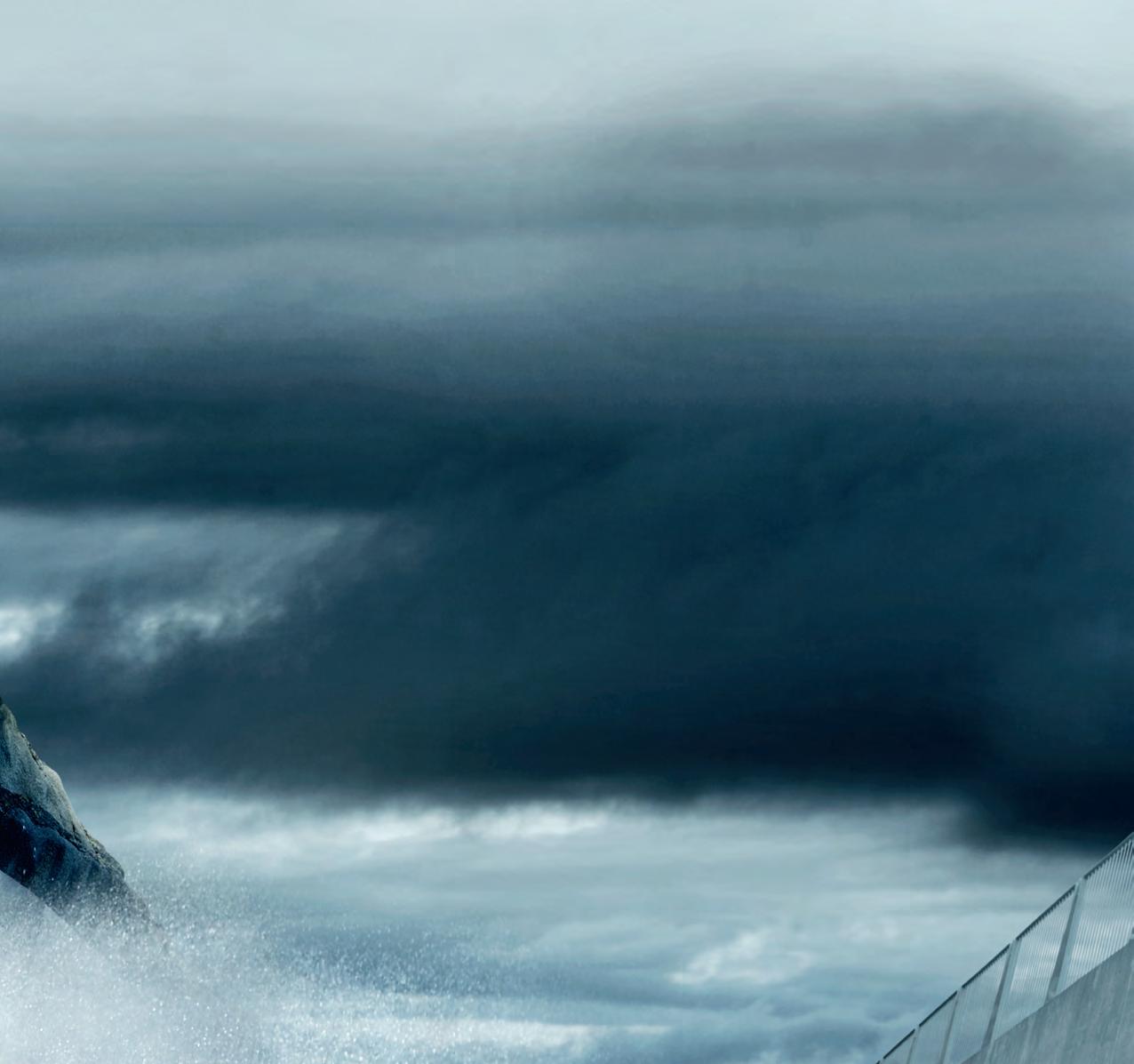






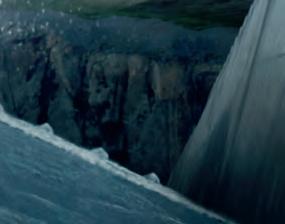





EDITOR’S LETTER INSIDE THIS ISSUE

How do you top an interview with the soon-to-be Prime Minister, as we had on our last cover?
Well, landing Benedict Cumberbatch, one of the finest actors of his generation, is a pretty good start. On P30 he talks about finding joy in misery, going grey and being his own worst critic.
Throw in Kiefer Sutherland (P46) and we’re on a roll. I met up with the actor-turned-musician to chat about everything from the student protests in America to what makes a good night out. For some insight into how we land these interviews – and what happens when they go wrong – check out my column on P8, in which recounts the time I stormed out of an interview with Henry Cavill and how I travelled half way around the world to be stood up by John Malkovich.
Elsewhere we have features from some of the hottest writers in the land, including a piece by Kyle MacNeill on his enduring love of Frankie & Benny’s – and why you should never go back. There’s plenty for city-dwellers, including hanging out with the urban fox rescue team (P34), a wistful defence of the municipal swimming pool (P38) and an introduction to the fine art of psychogeography (P42).
You can read all of these stories and more on cityam.com or our new app, which you can access by scanning this QR code. – STEVE DINNEEN


FEATURES REGULARS
20: SUNDAE SERVICE
Frankie & Benny’s holds a special place in the heart of Kyle MacNeill. He returns to his beloved chain
42: PSYCHOGEOGRAPHY
A stroll through the city can change your whole way of thinking – if you know what to look for, at least
50: FRA FEE INTERVIEW
The star of new show Lost Boys and Fairies on the importance of queer representation on screen
72: YACHT CLUB
Setting sail off the coast of SaintTropez sounds like a dream come true – and it kind of is, to be honest

16: CHEF’S TABLE
Restaurateur Ravinder Bhogal interviews her friend, the renowned composer Nitin Sawhney
52: WATCHES
We round up the most iconic watches in movies, from Pulp Fiction to Trading Places and Interstellar
63: WELLNESS
We check in for a health retreat in an exclusive Thai resort that offers something incredibly special
90: THE LAST WORD
Nightlife in the UK isn’t dead – it just moved to new venues, and you got too old to know where it went

4
16 34
24 Scan for the City AM app
Above: We explore how the @FootyScran X account changed the way clubs serve food at football matches; Below from left: A spirited defence of the urban fox; Ravinder Bhogal and Nitin Sawhney chatting in Jikoni restaurant
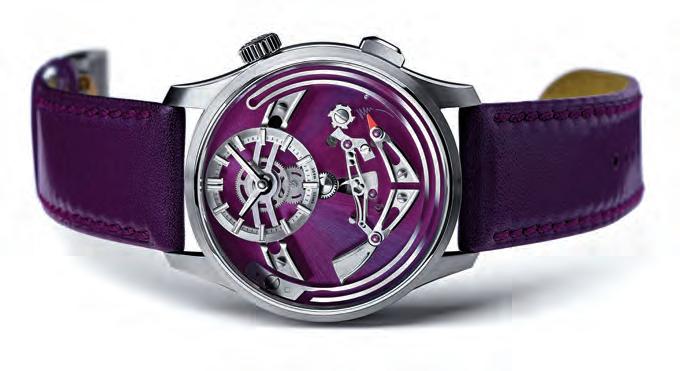
We love quality watches – so much so that in 2004 we started making our own. Combining award-winning English design with the finest Swiss watchmaking skills, and concentrating on craftsmanship rather than salesmanship, we’ve created watches that are the equal (or better than) the world’s most celebrated brands in every respect. Apart from price. The C1 Bel Canto is one such watch. But don’t take our word for it: Do your research

CONTRIBUTORS

ADELAYO ADEDAYO is an actor who has starred in shows including Sket and Some Girls. On P28 she tells us what she’d eat for her last meal, from her mum’s jollof rice to a Hawksmoor steak

LUCY KENNINGHAM is a features writer with a passion for industrial architecture. On P38 she dives into the world of municipal swimming pools, defiantly untrendy place people go to lose themselves

KYLE MACNEILL is a pop culture writer with fond memories of Frankie & Benny’s. On P20 he returns to the scene of his childhood birthdays and discovers a different beast than he had left behind

ANDY SILVESTER is the editor of our sister title City A.M. On P34 he goes in search of London’s urban foxes and defends these wrongly maligned city dwellers

ANNA MOLONEY is the magazine’s resident bookworm, keeping us abreast of all the happenings in the world of literature. On P88 she sings the praises of Oscar Wilde

When he’s not playing with his band Totally Amorphous, CHRIS DORRELL enjoys a spot of psychogeography, a French situationist philosophy he engages in on P42
For more great articles go to cityam.com. For a digital version of The Magazine go to cityam.com/the-magazine
EDITORIAL TEAM:
Steve Dinneen Editor-in-chief Adam Bloodworth Deputy Editor Billy Breton Creative Director Chris Stopien Deputy Creative Director Andy Blackmore Picture Editor Alex Doak Watch Editor Adam Hay-Nicholls Motoring Editor Tom Matuszewski Illustrator Anna Moloney Books Editor
COMMERCIAL TEAM:
Harry Owen Chief Operating Officer Jeremy Slattery Commercial Director Nzima Ndangana Luxury & Direct Sales Manager
For sales enquiries contact commercial@cityam.com. City A.M. The Magazine is published by City A.M., St Magnus House, 3 Lower Thames St, EC3R 6HD. Some products and websites promoted in this magazine are owned and distributed by City A.M.’s parent company The Hut Group
6






THE FRAUGHT WORLD OF CELEBRITY INTERVIEWS
Setting up a celebrity interview is a long and complex dance. Each one you read – like those with Benedict Cumberbatch and Kiefer Sutherland in this issue – stands atop the corpses of 100 that didn’t work out. They involve fraught discussions between journalists, brands, celebrities and formidable publicists, each with wildly conflicting interests. It’s not unusual for email chains to spill into triple figures and include lists of extravagant stipulations (“Kelsey Grammar will walk out if you mention his ex wife!”). Usually, on the day, they go off without a hitch. Sometimes, however, they do not.
My interview with Henry Cavill, for instance, ended with me telling the event organiser to “f**k off” as I stormed out, Superman looking on with an expression somewhere between ‘shocked’ and ‘apologetic’.
That day, some time in 2016, had begun well enough. I arrived studiously early for my meeting with the Man of Steel, who had been pencilled in as the cover star for an issue of this magazine.
The interview was tied to the launch of a new handset by a Chinese mobile phone company, which Cavill was fronting. I was booked in for 30 minutes and had a long list of questions about his acting style and how his family’s ties to the armed forces might have influenced him. There was also an obligatory mention of the phone, which Cavill would inevitably answer with platitudes so predictable I could have written them in advance. That’s the game.
The venue was packed, with an influencer event unfolding in parallel to the junket, which saw journalists from around the world queuing for their slot. It was not well organised. People on Cavill’s team were stressed. At least one was in tears. My slot came and went. After an hour I was told I would not be getting 30 minutes; 20 would have to suffice. An hour later that 20 became 15, which became 10, which eventually became five. Three hours had gone by, over which time I had experienced all five stages of accepting one’s own death: denial, anger, bargaining, depression and, finally, acceptance.
Eventually I was called in. “You have four minutes,” said a Terrible Man from the phone company.
“You must be f*****g kidding,” I replied, reverting from ‘acceptance’ back to ‘anger’. “Interviews are not divisible into units of less than five minutes.”
“You’re on the clock,” said the Terrible Man. Cavill was sitting across from me, gigantic and beautiful, clad in a neat-fitting suit. “How do you prepare for your roles?” I

From interviewing Idris Elba on a dance floor to storming out on Henry Cavill, STEVE DINNEEN relives his biggest interview disasters
asked.“Well, I usually…” began Cavill. “No,” interrupted the man, “there’s only time for questions about the phone.”
“You must be f*****g kidding me,” I repeated, apoplectic that the universe would do this to me. The job of a journalist at this stage is, of course, to ignore the Terrible Man.
“What was your childhood like?” I continued. “Erm, well it was actually ver…” said a sheepish Cavill, unsure how to react.
The Terrible Man then jumped up and positioned himself between me and Cavill, splaying his arms in a star-shape in a futile attempt to block his massive bulk from my sight. I leaned around him: “Tell me about your father!”
The man positioned himself between me and Henry Cavill, splaying his arms in a star-shape
“Enough!” screamed the Terrible Man. I stormed out, a string of expletives trailing in my wake. And with that, my cover feature was dead. They later sent me a free phone to apologise, which I flogged on eBay for a few hundred quid, so it wasn’t a total disaster.
Another time I interviewed Idris Elba in a loud – very loud – Soho bar. I had scoped out an alcove where we could just about hear each other but Idris was having none of it. “Stand with me,” he instructed. Surrounded by people dancing, we had to huddle so close I could smell his aftershave. My dictaphone picked up about a third of the interview. I did write that one up but it wasn’t very good.
And don’t get me started on John Malkovich, who left a junket early after I had flown all the way to Los Angeles to speak to him. I ended up getting very drunk with a publicist who thumbed through her little black book and set me up for a chat the next morning with Billy Zane. I have never been so hungover conducting an interview but thankfully Zane was happy to get stuck into the bloody marys.
Why am I telling you all this? Mostly for the lolz, but also to pull back the curtain on the wild ride we go through to land a big interview. It’s a tough job but somebody’s godda do it.
8 FIRST IMPRESSIONS


















BOOK OFF!
Everyone has a book inside them,” Christopher Hitchens once quipped, “which is exactly where it should, I think, in most cases, remain”. He wasn’t wrong. There are too many books. They scatter the shelves of WH Smith, gathering dust. Top 10 celebrity bestsellers fill the walls of airports where tired eyes linger on tomes they will never read. Books are used as decoration: you can pay an interior designer to organise your collection by the colour of their spines or –even more heinously – with the spines facing inward. YouTubers shamelessly film themselves buying books with which they make bedside tables. The mighty book – a vessel of ideas – has been reduced to a
There are too many books, says LUCY KENNINGHAM Most are ill-conceived, unnecessary and harm the environment. It’s time to reassess what we print
decorative detail.
The world now contains over 145m different titles, with 1.4m more published each year. Up to 980,000 of these are self-published, largely egotistical ‘rich people’ projects, with at best a paltry three-figure readership. The deluge of titles dooms us to suffer from ever-worsening decision paralysis, which discourages the picking up of a book in the first place. Why does this matter? Isn’t the democratisation of publishing a good thing, sure to improve the quality of humanity’s overall literary output? Haven’t a share of books always been ‘bad’, their existence allowing good books to transcend the rest? Well, no. The proportion of bad books is completely out of whack. The bodies that are meant to curate them are failing us. It’s often
touted – by the kind of people who roll out JK Rowling’s several trips to publishers before her Harry Potter success – that publishing houses are too elitist. But most publishers consistently choose quantity over quality. They have lost sight of what makes a book valuable. Some, like the 2007 runaway success Wreck this Journal, are made explicitly to throw against a wall. That’s not a book, it’s a stress ball. And don’t get me started on What to do While you Poo.
Too often, publishers come across an article or a podcast or a meme or a tweet and, sensing an opportunity, think: zinger! Let’s turn it into a book! This is how Simples: The Life and Times of Aleksandr Orlov made its way to my door (my father brought it to me from Moscow… Airport). There is a relentless replication and extrapolation of one piece of content into as many forms as possible in a way that disrespects the art of literature. “Culture today is infecting everything with sameness,” wrote Theodor Adorno and Max Horkheimer in 1947. Publishing a book has become no more than a stud in a person’s CV, an adjunct to a Wikipedia page, an (unregulated) signal of expertise. Even in academia, publishing your PhD has become a mere accolade. One researcher admitted to me that she didn’t anticipate anyone would actually read her upcoming publication ‘Anatomy of an opposition: Anti-sectarian movements in Lebanon’ (in spite of its clear worthiness). It was simply to prove her credentials. Then there is the not negligible matter of the environment. In the UK alone more than 77m unsold books are destroyed each year. If they were on average 350 pages each, that would account for the destruction of 1.6m trees. In a study of 86,000 books published, around 60,000 sold no more than 20 copies, according to data collectors Nielsen Bookscan. That’s a pretty damning commentary on the surplus produced by the publishing industry. On top of all this, a 2011 survey found the average Brit owns 80 books they haven’t read and showed that 70 per cent of books in the average bookcase remain unopened. Four out of 10 of those questioned confessed that their works of literature were purely for display purposes. Where does that leave us? In lieu of a Soviet-style Goskomizdat – the State Committee on Publishing in the USSR –perhaps we could agree upon a moratorium on memoirs before said author hits the age of 80. It is time for reference books to cease physical publishing, too, given their short shelf life and the existence of a thing called the internet. We should reintroduce pamphlets as a matter of urgency. Books from Sadiq Khan’s take on air pollution, Breathe, to Greta Thunberg’s No One is Too Small to Make a Difference would benefit from a bite-sized format.
Then again, perhaps a new Goskomizdat wouldn’t be the worst thing. I bet, at peril of a gulag, no one would risk their freedom to publish What to do While you Poo.
10 FIRST IMPRESSIONS
Most of these books could be an article or a podcast or a tweet – please stop writing them


You may be haunted by memories of your grandmother’s liquor cabinet but vermouth is a forward-thinking drink that should feel like ‘an ice-pick in the neck’, says CARYS SHARKEY
Ifirst tried vermouth in Spain. There, the day, slowed by the sluggish intensity of heat, is jolted into cool night by aperitivo hour. Vermouth is served over ice with a simple garnish of orange or lemon. The red liquid borders on viscous, giving it a sticky intensity that refreshes like nothing else. The journalist Helen Rosner describes drinking vermouth in the throbbing summer as “a thrilling exercise in fighting fire with fire”.
Vermouth is a wine aromatised by an apothecary’s shop of herbs and fortified with additional alcohol. I like mine with an olive – a saline hit that leaves a perfect teardrop of fat skimming across the surface. But vermouth never really found its footing in London. With just three specialised bars – in Soho, Kings Cross and Nunhead – it’s unlikely you’ll stumble across it.
Much like our summer, the promise of a British vermouth craze has been marked by many false starts. The drink seems destined to fall between the cracks, partly because of its innately ‘inbetweenish’ nature: stronger than wine, weaker than spirits; better known as an ingredient in cocktails than in its own right. Vermouth has a disorientating placelessness: who is it for?
In Italy I’m told the only people who order it are over fifty or Spanish tourists, although if the German pavilion afterparty at the Venice Biennale is anything to go by, it’s still popular in Dusseldorf. Perhaps the issue is tradition. Where Italians are bound by selfflagellating observance of the ‘right way,’ UK producers are exploiting the creative opportunities presented by vermouth.
Still Wild is a Pembrokeshire vermouth company with an ethos rooted in foraging salt swept botanicals. It makes a sweet and dry vermouth from local ingredients including bog myrtle, rock samphire and sweet woodruff. Its founder, James Harrison-Allen, told me he tried 73 plants and herbs before settling on the perfect blend. “We can embrace it as an essentially new product in this country,” he says. “Whereas Italy is very stuck into tradition and heritage, here you can take the framework of the movement and be far more creative with it”. Guy Abrahams, founder of the award

WHO’S AFRAID OF DRINKING VERMOUTH?
winning London Vermouth Company, echoed these sentiments, saying the British vermouth market is “ripe for creativity”.
There are now dozens of UK producers making an often hyperlocal and varied spectrum of vermouths, some cloaked in the salty mists of the coast, others ripe with English gooseberries or replicating a hedgerow cosmos writ large.
Should you be ready to take the plunge, I would start by clearing out any accumulated dribs and drabs of syrupy vermouths that might be festering your liquor shelf. It’s time for a fresh start, a spring cleaning of prejudices.
Try bottles produced by Still Wild, Vault,
London Vermouth Company, The Aperitivo! Co, and Sussex based In the Loop (a maker spearheading the move to get ‘English Vermouth’ a designated and protected term). Drink your vermouth with olives and pork scratchings and pickled onion monster munch and Spanish pintxos (a selection of salty, oily snacks like iridescent anchovies and wafer thin crisps). As the summer wears on and concrete begins to radiate, embrace the British aperitivo hour. Most importantly, it must always be cold. As Michael Kaplan, the encyclopaedic founder of Edinburghbased Great British Vermouth, told me: it should be drunk like “an icepick in the back of the neck”.
12 FIRST IMPRESSIONS
Vermouth is a wine aromatised by an apothecary’s shop of herbs and fortified with additional alcohol

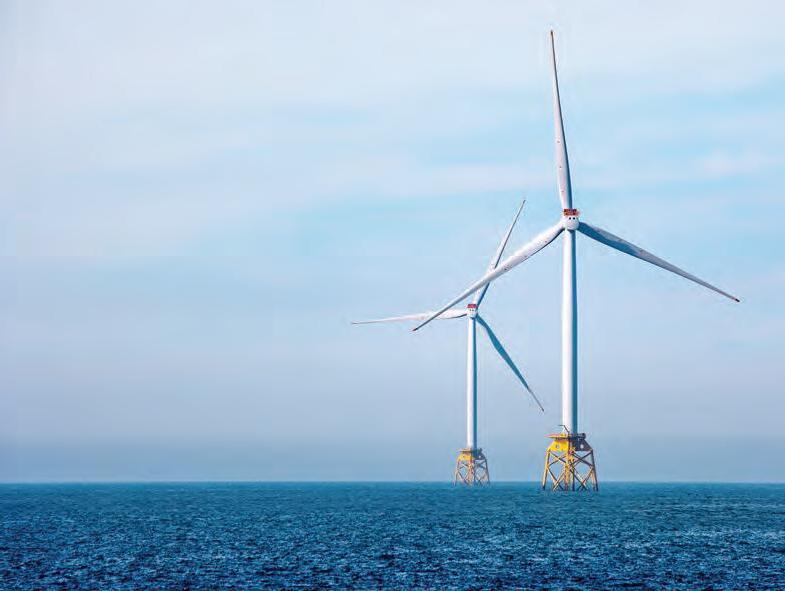







The race is on for green growth, net zero, and energy security.
At SSE, we’re investing right here, right now. We’re building the world’s largest offshore wind farm. We’re transforming the grid. And we’re delivering thousands of jobs.
Around 90% of our investments are in electricity networks and renewable energy. And, for those days when the wind isn’t blowing and the sun isn’t shining, we’re reducing emissions from the flexible back-up power we need today, to secure Britain’s energy future.
sse.com

WE
CHANGE WE’RE INVESTING IN HOMEGROWN ENERGY £20 BILLION ACTIONS, NOT AMBITIONS WILL SECURE OUR ENERGY FUTURE SSE’s £20.5bn five-year investment plan to 2027 expects to allocate ~54% into networks, ~34% into renewables, and ~12% into other businesses, including gas and low-carbon flexible generation technologies. In 22/23 SSE’s generation output was 60% non-renewable sources and 40% renewables. SSE is committed to being operationally net zero by 2050, measuring and reporting on its science-based carbon targets and aiming to cut the carbon intensity of the electricity it generates by 80% by 2030, from a 2017/18 baseline. Verify at sse.com/change
POWER
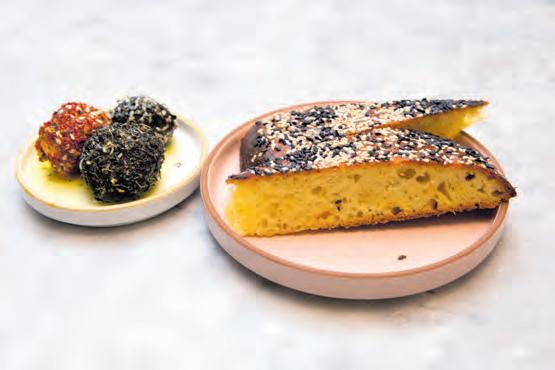
CHEF’S TABLE
Food writer and restaurateur RAVINDER BHOGAL interviews her friend NITIN SAWHNEY, the composer, producer, and multi-instrumentalist, at her restaurant Jikoni. Pictures by GRETEL ENSIGNIA
THE MEAL:
SOY KEEMA BUN, PINK PICKLED ONIONS CURED CHALK STREAM TROUT LA RATTE POTATOES, KIMCHI LABNEH, SAFFRON SHEERMAL
NITIN SAWHNEY: Hi Ravinder, how’s it going, are you in a good place?
RAVINDER BHOGAL: Yeah, I’m good! I’m having a year for me, after two pretty hectic years of book promotion. I’m taking a year to really find joy.
NS: Well that’s what your book, Comfort & Joy, is about! How’s that going?
RB: Comfort & Joy has done really well. I went to the States and did all the festivals in the UK so it was hectic but really joyful. The last book came out during the pandemic so there were no live events.
NS: You’ve had such a successful career as a writer as well as an amazing chef. That’s
Cooking is a very maternal thing. I didn’t go to cookery school, I was taught to cook by women who were taught to cook to nurture and nourish
what I’m full of admiration for, you’ve had these parallel careers and they compliment each other. Do you have a love for one over the other or do you feel they cross-fertilise?
RB: We’re quite similar in a way: you’re also multi hyphenate, you’re a polymath, you do so much, but I think the similarity in the writing and cooking is it’s about giving a service to someone. It’s about how you make someone feel when they read a piece you’ve written or eat a meal you’ve cooked. I think similarly you’re like that with music, ultimately you know it’s going to move someone in a certain way and I think there’s a joy in that, isn’t there?
NS: Yes, absolutely. I was talking to somebody about the neurology of music. The nucleus accumbens, the part of the brain which is the reward centre: it’s interesting in how that works with music and also the way it works with food. Your brain rewards you as well as your palette.
14 FOOD&DRINK

RB: It’s about the intention you put in when you’re creating a piece of music or cooking a dish. It’s a very maternal thing. I didn’t go to cookery school, I was taught to cook by women who were taught to cook to nurture and nourish their families. It’s an innate, deeply entrenched feeling. I always want to look after people, nurture people. With you recently when you were sick my instinct was to bring some food around.
NS: That was so kind of you!
RB: I run a restaurant and while it has to be commercial I really do it for the love. For the feeling it gives other people.
NS: That’s what I love about your food: it’s a synesthetic experience. It’s about memory, it’s about different senses being evoked. Were you ever conscious of that?
RB: I just think food is life and life is complicated. There are so many emotions when it comes to food. Recipes are like
When you bring cultures together, you create something that’s better than the sum of their parts. This is a form of soft-activism
stories with no endings – particularly the kind of food I cook, which is immigrant food. It’s constantly evolving. It’s an amazing way of telling stories about people and celebrating the similarities we have but also the differences.
The food that I cook is often a bit political. We have something like the prawn toast scotch egg, which I’ve always described as this bonny love child of a British scotch egg and a Chinese prawn toast. What we’re trying to say is that when you bring cultures together, you create something that’s better than the sum of their parts. This is also a form of soft-activism and it’s wonderful to see people use it, whether it’s through music or food or poetry, it’s a really powerful way of being active in the world.
NS: It’s interesting that you talk about stories. You studied literature and you’re a great writer but you have this awareness of narrative in the way the foods work together. You have to have that as a writer but also as a chef, which is fascinating.
15
Above left: A dish of Labneh with saffron sheermal at Jikoni; Above: Ravinder and Nitin at the restaurant

RB: It’s a gentle sort of storytelling. We are taking people on a journey when they come into the restaurant. I remember the first track we ever played on our first service was The Boatman from your album! I felt like I was about to go on this massive journey. It felt like crossing over, and that song is so beautiful. It feels like a lullaby. It was very calming to listen to as my first plate went out. I felt like I was crossing a river myself.
NS: I love that. The western concept of the ferryman represents somebody who takes you to a peaceful future, to destiny. I think there’s something poetic about that image, it’s something I find really inspiring, musically.
RB: I’ve grown up as a sikh and that representation of crossing over a river for us often means going from life to death. But I think in life you can have many little deaths and rebirths. You’re born a new person all the time, every time you go through something. For me that was disentangling myself from my past and having the courage to open a restaurant. You think about these themes of immigration and identity on your new album and that kind of diversity is what makes the world such an interesting place to be in.
NS: I’m a Booker Prize judge and it’s interesting for me how many books there are now focusing on the concept of cultural identity, looking at it from many perspectives. I keep thinking, is it because I’m especially aware of that subject? But it’s not: a lot of people are thinking about identity. It comes up in politics, it comes



up in culture, it comes up in schools. Identity is constantly a battleground, as well as a place for people to feel safe. That’s what I wanted to do with the album: create a safe space for people to express themselves. I always feel your restaurant Jikoni is a safe space.
RB: I always wanted it to be. People kept asking ‘Why did you do Jikoni? Why do you do the kind of food that you do?’
It was a subconscious thing for me because, as an East African Indian, British born, raised in London, I have so many identities. But I was being pigeon-holed. ‘You’re a brown girl, you must do Indian food.’ Throughout school and growing up there was this box you were supposed to fit into. I really struggled with that. I felt that I’d always lived in a sort of hinterland between who I was to my parents and who I was outside the home and who I really am. Jikoni is the place where I can express my multiple identities, my multiple tongues.
We have dishes on the menu that have Swahili names, Indian names, we don’t try to reduce them by saying, ‘It’s a chicken curry.’ We will call it by what it is, the kuku paka.
The thing I feel most proud of is that we have such an international crowd. Once on a table of 10, there was a Palestinian, an Egyptian, a Lebanese person, someone from Paris and all these people were saying, ‘Wow, this tastes like something my grandmother used to make.’ If they’re finding a sense of home at Jikoni, I feel like I’ve had a good day in the office.
l To book a table at Ravinder’s restaurant Jikoni go to jikonilondon.com; Comfort & Joy cookbook is available now; For more on Nitin Sawhney visit.nitinsawhney.com
16 FOOD&DRINK
Above: Nitin and Ravinder catching up; Below from top: Soy keema bun with pink pickled onions; cured chalk stream trout; la ratte potatoes with kimchi
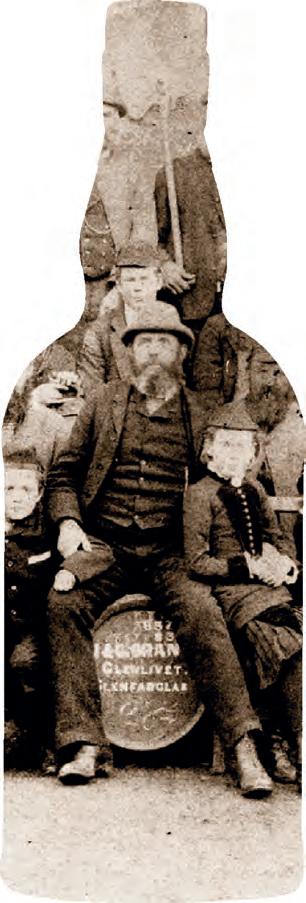


FOOD FOR THOUGHT
THE RECIPES MY EX TAUGHT ME
Food plays an integral part in relationships – but what happens when they end? How I still find joy in the dishes my ex cooked
Ithink about my ex precisely twice a year: in the winter, when I make his annoyingly good sausage casserole, and in the summer, when I make his annoyingly good chicken salad. By all accounts, he turned out to be a bad apple, but I’ll give him one thing: he gifted me a love of cooking that far outlasted the relationship.
When he first referred to the “holy trinity” in our shared kitchen, I thought he was perhaps revealing his religious side. In fact, he was sweating celery, onion and carrot - the basis of many a good meal, he said - in a pan glazed with the fat from the sausages he’d just browned. For the extra flavour, you see? I did not see - because prior to meeting him, I could’ve burned boiling water. Our culinary experiences were worlds apart. Where he reached for fresh garlic, deftly dicing it with a knife, I would have tipped in dried granules. In his arsenal of spices he had the paprika, sage and cayenne needed for the dish, whereas I had contributed a single pot of Asda mixed herbs to our cupboard. He had the confidence to replace the cider in the sauce with apple juice because it was cheaper but arguably just as tasty, and the knowledge to simmer and reduce it by half for maximum punch. A can of tomatoes, the container swilled out with stock, and an hour later we’d
have a warm, comforting meal to counteract the freezing Manchester night.
That meal was the foundation on which I’ve since built a robust knowledge of one-pot cooking. It might sound simple to more sophisticated palates but lest we forget that a 20-something boy who can cook is a rare beast. I suspect he’d learned out of necessity, whereas I’d arrived at university having only graced the kitchen to eat the food presented to me by my mum. As a result, I’d had to ring home during freshers’ week to ask how to brown chicken.
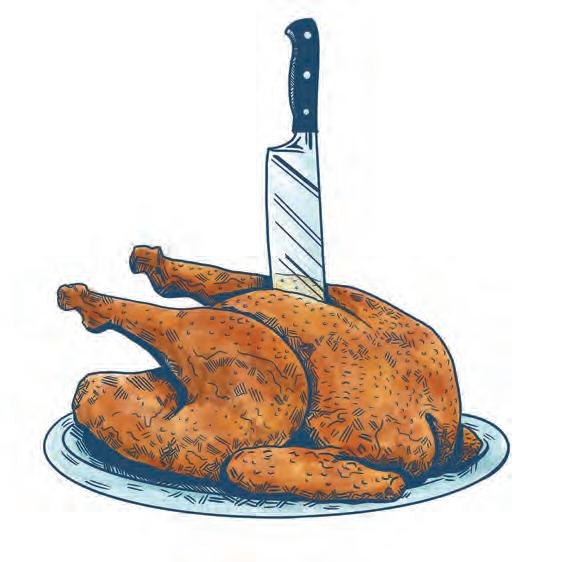
Imagine, then, the revelation of learning to poach chicken in stock, garlic and thyme so that it was plump and juicy, and not a pile of charred nuggets in packet fajita mix. That instead of reaching for a shop-bought dressing, my ex whisked together mustard, oil and vinegar and drizzled it on warmed mixed beans and a side of rocket. If the way to a woman’s heart is through her stomach, it’s via a salad leaf better than iceberg lettuce.
That I still cook both dishes almost 15 years after we broke up, however, is not due to residual nostalgia. That has long since evaporated; it’s simply because they’re delicious. Do I think about him when I make them now? Only in the occasional abstract: oh, he taught me this one. In truth, I’ve now made these recipes more times solo than we ever did together. They’re mine now. If you’re asking me how it feels to eat my feelings, I’d say they were pretty tasty.
18 FOOD&DRINK
LAUREN POTTS

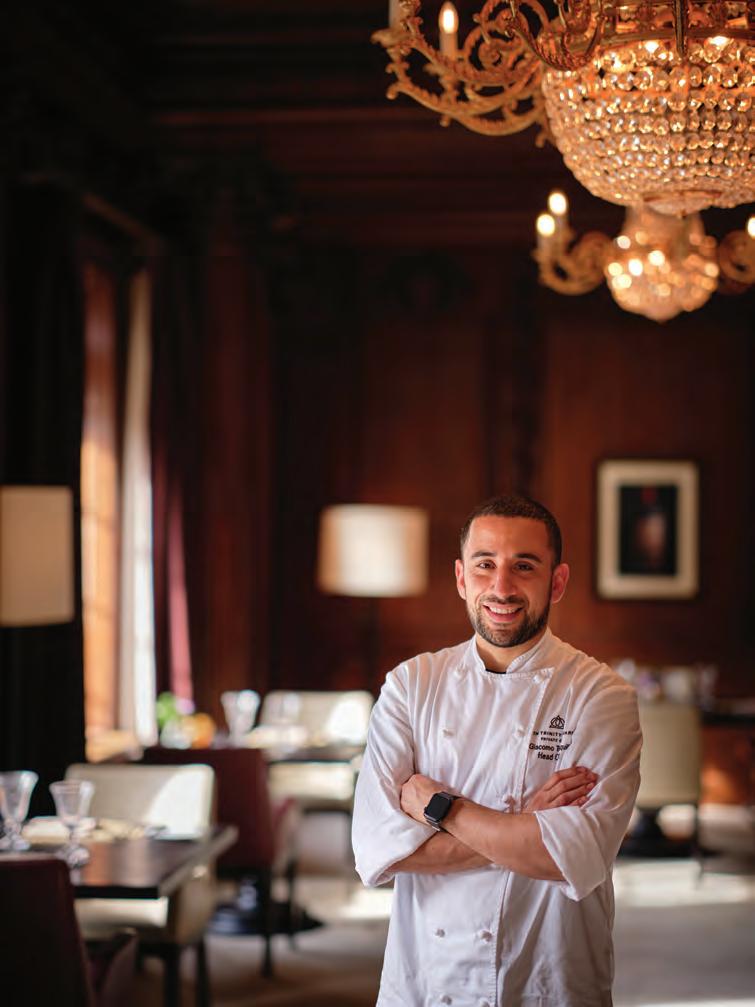
Breakfast or lunch for prospective members. Available throughout June, July, and August


ELEVATE YOUR DINING experience this
SUMMER
Indulge in a summer of gourmet delights at our exclusive club, where every meal is an event to remember. From June to August, enjoy a breakfast or lunch as our guest and discover why we are the city's premier dining destination.

Our club is a haven for those who cherish the finer things in life. Whether you seek a tranquil workspace, a refined se ing for business, or a serene retreat to unwind, our club offers the perfect ambiance. Don't miss this exclusive opportunity. Contact to secure your dining experience and the benefits of membership.
Reserve Your Spot Today
clubsales@tentrinitysquare.com
CONTACT
US
FRANKIE, BENNY AND ME
It was a childhood staple – now it’s a dying chain with a handful of sad restaurants. KYLE MACNEILL remenisces about the glory days of Frankie & Benny’s
My salad days did not involve much salad. They were instead filled with molten-hot dishes preceded by the disclaimer: “Please be careful, it’s really hot,” or ice-cold glasses piled vertiginously high with sugary things that towered above my gelled-up hair. And, almost always, I would devour these saucy and sweet extremities of temperature at Frankie & Benny’s, the Italian-American restaurant chain.
“Family: they’re the ones you can depend on,” Tony Soprano once said. But our family also depended on Frankie & Benny’s: for birthdays, celebration dinners and after-school surprises. My memories of it are tinted in a familiar shade of red: the crayons, the napkins, the sauces, the booths. And every visit ended with a cookie-and-ice-cream concoction so ludicrously sickly and diabolically fudgy that a dentist would rather pull their own teeth out with a sundae spoon than take on the challenge themselves.
Frankie’s wasn’t the only franchise in which I spent my childhood — Nando’s, TGI Fridays and Prezzo were all family favourites — but Frankie & Benny’s topped the lot. There’s something reassuring about the consistency of a chain restaurant, with an equally reassuring consistency to its gloopy sauces. We stuck to what we knew. But it turns out I knew a lot less about the duo behind Frankie & Benny’s than I imagined.
The story of Frankie & Benny’s, as it goes, begins exactly 100 years ago in 1924, when Frankie Giuliani left Sicily and moved to Little Italy in New York. After his parents built and opened their own restaurant, Frankie became friends with Benny at school. In 1953, the pair took over the family firm and the rest is history. Or fiction, actually. For years, I believed this tale, one that’s immortalised in every franchise of Frankie’s, through framed family photos and sepia-stained newspaper clippings.
But F&B’s didn’t begin in Little Italy; it was launched in Leicester. And it wasn’t opened by the slick,
suited-and-booted, rat-pack-styled duo of Frankie and Benny. Instead, it was founded in 1995 by The Restaurant Group (TRG), the earnestly-named conglomerate that has owned chains including Garfunkel’s, Chiquitos and Wagamama. I tried to speak to someone from TRG to find out how they happened upon this incredibly specific pair of fake Italians but nobody got back to me. Quickly expanding across the UK, the company opened its 100th restaurant in 2005 and became the kingpin of retail parks, dominating the spaces beside cinemas, bowling alleys and furniture stores.
But by the mid 2010s, the Italian-American dream of Frankie’s began to fade and profits began to spiral. After first blaming a rise in competition, TRG conceded that it was probably down to high prices and poor service. TRG threw spaghetti at the wall to see what stuck. Breakfast was positioned as the Big New Thing, rebranding efforts were attempted and the menu was changed again and again, featuring a revolving door of spin-off dishes. The chicken parmigiana, the new CEO noted with a sense of horror, had been replaced by chicken saltimbocca. An angry mob was forming. In a surreal twist of fate, a toddler was accidentally served alcohol not once but twice in the space of a few years. Perhaps they needed to block out the saltimbocca.
In 2016, 33 branches were shuttered. In 2019, 18 more flailing franchises were closed for good. Then, at the start of the pandemic, scores more were whacked. The conglomerate even opened a shortlived version of the chain called Frankie’s, stripped of the original’s charming decor and, most devastatingly, any mention of Benny.
Today the writing is very much on the wall. Late last year, following the closure of dozens more F&B’s, TRG announced it would sell the franchise to The Big Table, owners of Cafe Rouge and Bella Italia. TRG didn’t make a penny from the sale, instead paying The Big Table £7.5m to take the loss-making business off its hands. With just a few dozen restaurants left, it’s possible that
20 FOOD&DRINK


Frankie & Benny’s will soon disappear forever, melting away, like tears in ice cream.
To rub salt in the wounds, the fall from grace coincides with an Italian-American renaissance in the British food scene. Over the last few years, the likes of The Dover, Alley Cat and Grasso in London have created a new gang of grown-up meatball-andspaghetti restaurants with far slicker decor and fancier food than Frankie or Benny could ever whip up. In wider culture, too, the rise of the Mob Wife aesthetic and mass rewatching of The Sopranos would seem to be a golden opportunity. But Frankie & Benny’s – the commercial Godfather to these new Italian-American restaurants – is being left in the parmesan dust.
One of the remaining franchises is in Manchester’s Printworks centre. I head there on a weekday evening with my housemate, keen to try to relive the glory days of Italicised knickerbocker glories and Anglicised spaghetti bolognese. Taking a seat at one of its booths and slurping-up a syrupy, slightly-flat coke, I instantly feel at ease, nodding along to its playlist of crooners. Miles Davis and Sinatra are interspersed with Miley Cyrus, in an apparent effort to be a little more relevant. Regrettably, I don’t have the meatballs to ask for a crayon box. Just two other tables around us are populated, tucking into hefty
21
Above: Kyle out for a family dinner at Frankie & Benny’s some time in the early 2000s; Left: A now-vegan Kyle contemplating a forbidden sundae lll
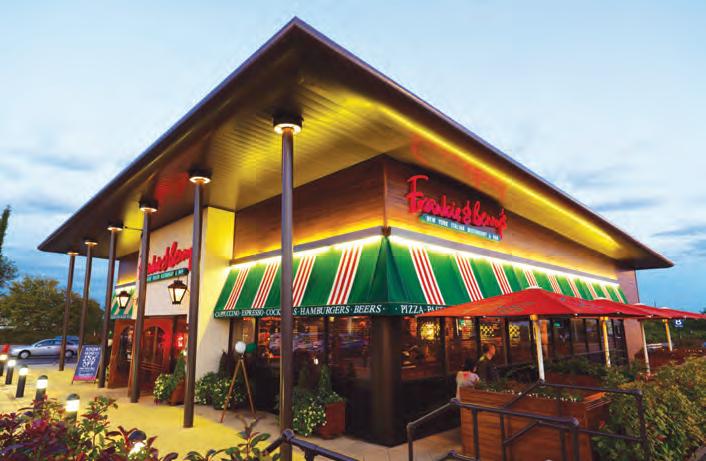
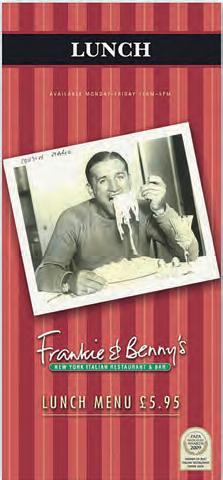

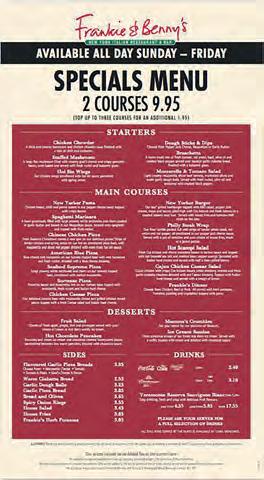

burgers and a bottle of
The service is excellent and the decor is as fun as I remember, a kind of watered-down Scorsese film set. But when our food arrives, I realise my memories of eating here may be slightly warped. Either that, or it’s changed; because Frankie’s food, to be frank, is not great. This will, of course, come as absolutely no surprise to most people;


Frankie & Benny’s had never threatened to land itself a mention in the Michelin Guide. But, once upon a time, I did love the food. Did I have no taste?
Perhaps, it’s partly because I have changed. I’m now a bit vegan, so my housemate is entrusted with eating the dairy. Either way, my sugary and vinegary penne arrabbiata is less angry, more a
little irritated, mopped up with sad garlic bread. When the sundae comes, I do briefly consider giving up years of veganism to dive into its billowing, pillowy cloud of ice-cream and whippedcream, a godly combination. But the bronzed busts of Benny that decorate the restaurant stare me down. According to my housemate its sweetness is migraineinducing. When the bill arrives I realise that, while cheerful, it’s not even cheap: two pasta dishes, a side, two cokes and a sundae comes to well over £50.
Yet, for all its flaws, I leave with a full heart. For years, I have sneered at restaurant chains: tacky, bland outlets drained of any personality. There are, obviously, countless reasons to support independent restaurants and true Italian foodies would understandably see Frankie & Benny as the devil and the antichrist manifest. But there is a snobbiness at play, too. The last time I went to Frankie & Benny’s, on my first day at uni, I remember feeling embarrassed to be in one of its booths, like I had outgrown it.
TS Eliot’s Alfred Prufock said that he measured his life out in coffee spoons. I measured mine in sundae spoons
But what they can do is take you back to – as Frankie & Benny’s current slogan goes – The Home of Real Good Comfort Food. Sitting here in this ersatz gangster’s paradise, I realise I could be in the Frankie & Benny’s in Croydon where I celebrated my sister’s thirteenth birthday, or the one in Glasgow I went to for a package holiday kids club reunion decades ago. It’s true that, like the Frankie & Benny’s origin story, some of my own memories might be fiction. Was I really as happy as I remember? Did I really finish that sharing sundae by myself? Am I seeing this all through rosso-tinted glasses?
Either way, there is something irresistibly romantic about it. TS Eliot’s Alfred Prufock measured his life in coffee spoons. I measured mine in sundae spoons. Time doesn’t pass here, in this liminal space somewhere between Leicester and Little Italy; the sundaes are permanently frozen; Frankie and Benny are stuck in stasis on the walls; my childhood self remains sitting in one of those booths, smile stained red.
22 FOOD&DRINK
From top: A Frankie & Benny’s during its heyday in the early 2000s; The iconic menus, familiar to millions of diners; Kyle returning to the mythical restaurant of his childhood to be faced with a bowl of miserable pasta
wine.
Garden. Party. Racing.

30 JULY – 3 AUGUST
#GLORIOUS
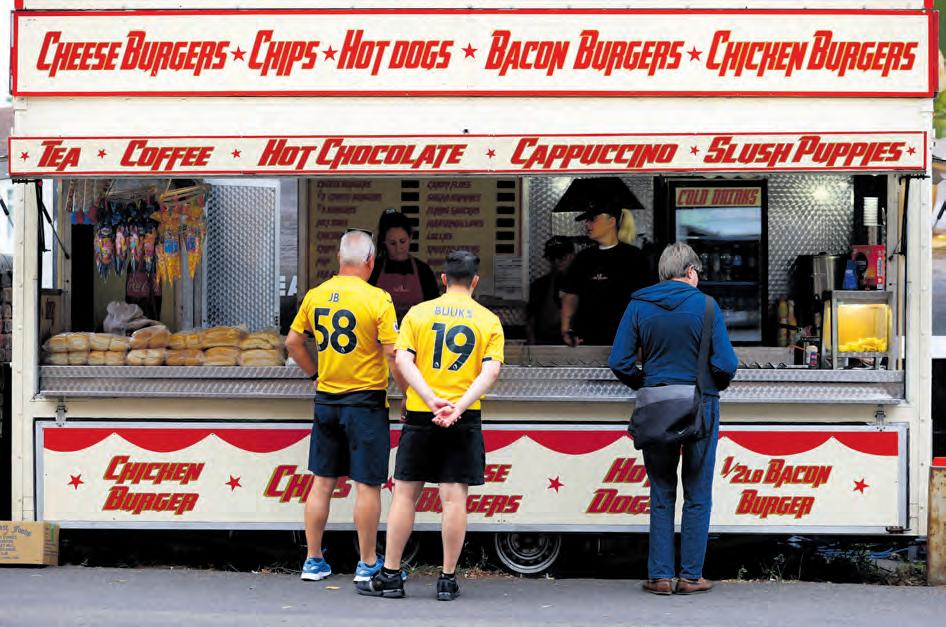



THE MAN WITH THE SCRAN
With almost 600,000 followers on X, FootyScran, which rates stadium food, has become an institution with influence over an entire industry. Words by CHRIS STOKEL-WALKER
24 FOOD&DRINK

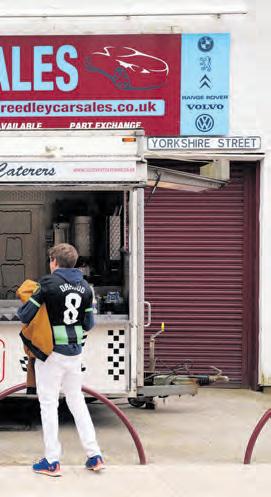
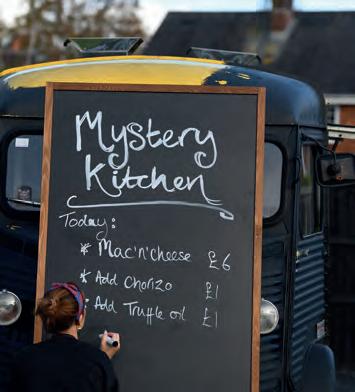
Richie Howard, a palaeontologist from Merseyside who now works at the Natural History Museum as the curator of fossil arthropods and graptolites, had a great time watching Vissel Kobe defeat Cerezo Osaka 4-1 in a J-League football match last month. But it wasn’t the fast-flowing football or the injury time goal, slotted into the bottom left corner from just inside the 18-yard box by Taisei Miyashiro, that most grabbed Howard’s attention. It was the beef steak donburi and takoyaki (battered octopus balls) that stood out.
After slapping down 1,700 yen (£8.70) for the beef bowl, served over steamed rice with the batter balls on
Tom Sibley set up FootyScran after seeing a photograph of sausage and chips with curry sauce, served in half a hollowed-out bread roll
wooden sticks, Howard took photographs of the food and shared it on X (formerly Twitter). “Absolutely immaculate vibes in the away end of the Sakura Stadium,” he posted. “And the scran omg”. In the post, he tagged two accounts: the official J-League English language account, and @FootyScran. “I love FootyScran,” says Howard. “I really enjoy seeing the food around the world.”
He’s not the only one. Nearly 600,000 people follow FootyScran on X, with 40,000 more on Instagram. The profile is a documenter and enabler of a Damascene transformation in what people eat while watching football. This food revolution is a world away from the burnt sausage rolls, cremated pies, soggy chips, and questionable hot dogs that most football fans will remember from years gone by. Today, you’re as likely to get chicken katsu curry or bang bang noodles as you are a slightly grey burger. And it’s largely down to a single social media profile, run by an air conditioning installer living in the West Midlands.
Tom Sibley set up FootyScran in 2020 after seeing a photograph on social media of a portion of sausage and chips with curry sauce, served in half a hollowed-out bread roll, sold at Merthyr Town, a Welsh team playing in the seventh tier of the football league. FootyScran has gone on to capture the changing face of football stadium food – and along the way, make its own indelible impact on both on- and offline culture. Google search traffic for “scran” has increased significantly across the UK since 2020, a shift in part accounted for by the popularity of FootyScran. Sibley himself remained intriguingly elusive as I was writing this, acknowledging the messages I sent him trying to set up a chat before dropping off the face of the earth. But several football clubs were happy to talk about the impact of FootyScran.
One of the clubs that has upped its food offerings is Luton Town, who were relegated fromo the Premier League this year. The club contacted Raffaele Ruocco, a chicken shop entrepreneur, about bringing something new to the team’s stadium to match their standing in the top flight of football and their £10m refurbishment of the stadium. “They approached me last summer,” says Ruocco. “They had a concept of what they wanted. Being in the Premier League, they wanted to evolve the food.”
Ruocco now runs The Kenny Henny, whose BBQ honey glazed chicken burger with fries was featured on FootyScran in April. “We’re trying to offer something to the people that’s not your usual run of the mill boiled burger or nostalgic pie,” he says. A broader range of food is important, says Ruocco, because football stadia can’t be exempt from more general shifts and trends.
“Everywhere you go, people have upped their game. Even McDonald’s is fancier than it was.”
Howard says FootyScran fills a hole left by the closure of banterlicious TV show Soccer AM, which had been on a downward trend for a decade or more before its final
25
Clockwise from top left: Wolves fans await Slush Puppies at Molineux; Southampton fans eat hot dogs at St Mary’s; The Mystery Kitchen at Farnham FC; A food wagon at Burnley’s Turf Moor; An old-school shot of terraces at The Den, New Cross
SCRAN OR NO SCRAN? STADIUM FOOD ACROSS THE WORLD

£7
£4.20 – 82.4% SCRAN

episode last year. “I reckon plenty of football fans are hungry for lighthearted, daft and inoffensive football content,” he says, “especially given how grotesque the general discourse is with all the bedroom pundits.”
What makes FootyScran work is that it doesn’t name and shame or pillory bad food, instead letting the pictures do the talking. Users simply vote whether an item is “scran” or “no scran”. The account itself is studiously silent when sharing the photos submitted by its hundreds of thousands of followers.
But while FootyScran has incentivised some clubs to drastically improve their matchday food – Tottenham Hotspur is one club often singled out in ‘best of’ lists since its eponymous stadium opened in 2019 – others have not bought into the idea. “The food at Newcastle remains terrible,” says Charlotte Robson, a Newcastle United fan and host of the True Faith podcast. She says she looks on in envy at FootyScran’s feed: “It makes me

CHICKEN SATAY STICKS
MANDURAH CITY
£8.80 – 91% SCRAN
£2.10

SANDUÍCHE DE COSTELA
£4.20 – 82.4% SCRAN
£6.30 – 83.7% SCRAN


want to be a football tourist.”
One place many FootyScran followers have on their must-visit list is Farnham Town FC, a semi-professional club that won the Combined Counties Premier Division South last season. One of the club’s directors is Harry Hugo, who runs a London-based
Football fans are hungry for lighthearted, daft football content given how grotesque the general discourse is
social media marketing agency that works with Instagram, TikTok and YouTube creators; he knows the power of social media to drum up offline interest.
“At a non-league level the main drivers of revenue are food and drink,” he says. So when he became a director in mid-2022, Farnham Town introduced a mystery kitchen concept to matchdays: a food truck would serve a rotating range of Instagramready, exotic dishes developed by a professional chef, alongside the standard matchday fare. “We had this idea that if we created a different dish every week, we would have the ability to publicise ourselves on FootyScran every week. From a revenue perspective it’s a lot better for us to sell a meal of chicken and rice than it is to sell a burger for half the price.”
It’s strange to think that a miserable portion of sausage and chips served in a hollowed-out bread roll on a rainy afternoon in Merthyr Town changed the way we think about stadium food – but it’s a funny old game, innit?
26 FOOD&DRINK
VALENCIA FC
SERRANO HAM BAGUETTE
REDHILL FC
BATTERED SAUSAGE AND CHIPS
ATHLETICO PARANAENSE
NOTTINGHAM FOREST
PIZZA DOG
SCRAN
BANGKOK GLASS FC
– 68.9%
MIXED WORMS AND INSECTS
– 29.2% SCRAN

THE LAST SUPPER
Star of upcoming Netflix drama
Supacell ADELAYO ADEDAYO tells us what she would eat for her last meal on earth
My mum cooked in my household – she’s very, very good. I come from a Nigerian family and my cousins would go to my mum’s house just for jollof rice. Even when they see me today they’re like, “Do you have any of your mum’s jollof?” Even if I had some I’d say no: I have to ration it! It’s legendary in my family.
Our house was a place that people came together to eat. My mum’s friends and aunts and cousins and everyone would come round and we’d all eat these amazing Nigerian dishes.
We ate a lot of akara, a bean cake that you have for breakfast. And a lot of moin-moin, which is also made from beans but boiled in water – you can have it with garri, which is made from cassava flakes. And, of course, we had a lot of jollof rice, and my absolute favourite, pounded yam with stew and okra. I adore pounded yam: the consistency is just amazing. It’s
I’m going to have some apple crumble made by me because my apple crumble is the best there is
part of a group of foods called ‘swallow’ in Nigeria that you eat with your hands – you sort of roll it into a ball and dip it into the stew and okra.
I think some of my mum’s cooking prowess rubbed off on me. I’m not as amazing as she is but I do a good pounded yam, my jollof is pretty good and I make a really good ribeye or sirloin steak. To fit in with acting I’ve learned that I need to batch cook dinners for the week ahead, otherwise I’m just on the delivery apps, so on Saturday or Sunday I’ll make my food for the week ahead, portion it up and leave it in the fridge for when I get home. I’m quite disciplined in that way.
I also really, really love going out to eat. I ate at Ikoyi a while back and that was unbelievable but I’m actually pretty bad at trying new places – I love Hawksmoor: you just know it’s going to be great every time. And there’s this place called Seabird in Southwark that does this grilled sea bass that’s absolutely amazing.
So on to my dream meal, which is a bit all over the place if I’m honest. I’m kicking it off with a couple of Jersey oysters with tabasco because I wouldn’t want to go without having eaten them one last time. Then I’m getting some beef suya, which is a Nigerian small chop done on the grill. It’s served in old newspaper with onions and really hot chilli powder and tomatoes. And
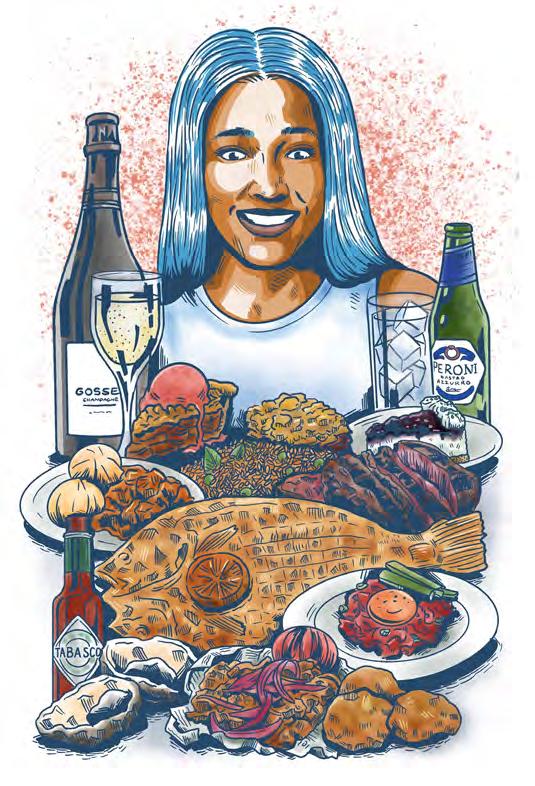
I’m going to have some akara with it too.
Next I’m having steak tartare from a very specific place, this Japanese restaurant in Sao Paulo. Before I ate this for the first time I had a bit of a thing about uncooked meat but this was just incredible – I couldn’t believe how much flavour there was in it.
There was a raw egg yolk on top – stunning.
For my main I’m gonna have the grilled sea bass from Seabird and a steak from Hawksmoor and my mum’s jollof rice, all on the same plate. On the side there’s going to be pounded yam with okra and stew, and in the stew there’s going to be oxtail and goat. All my favourite things on the table together.
For dessert I’m having apple pie with strawberry ice cream on top. And I’m going to have some apple crumble made by me because my apple crumble is the best there is. And I’ll have a lime and blueberry cheesecake, also from Hawksmoor – I had this in Liverpool but they have taken it off the menu now so we’ll have to get them to make it for me especially.
I’ll wash it all down with a glass of Gosset champagne, a glass of ice, ice cold water – because nothing beats that when you’re eating – and a bottle of Peroni. After eating all that I just want to sit back with another beer. Lovely.
l Adelayo’s new show Supacell starts on Netflix this month
28 FOOD&DRINK
Adelayo Adedayo will star in superhero drama Supacell on Netflix this month
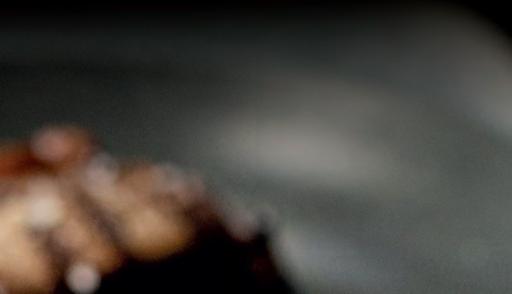
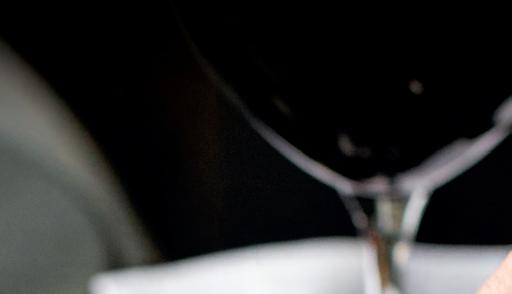


30 years

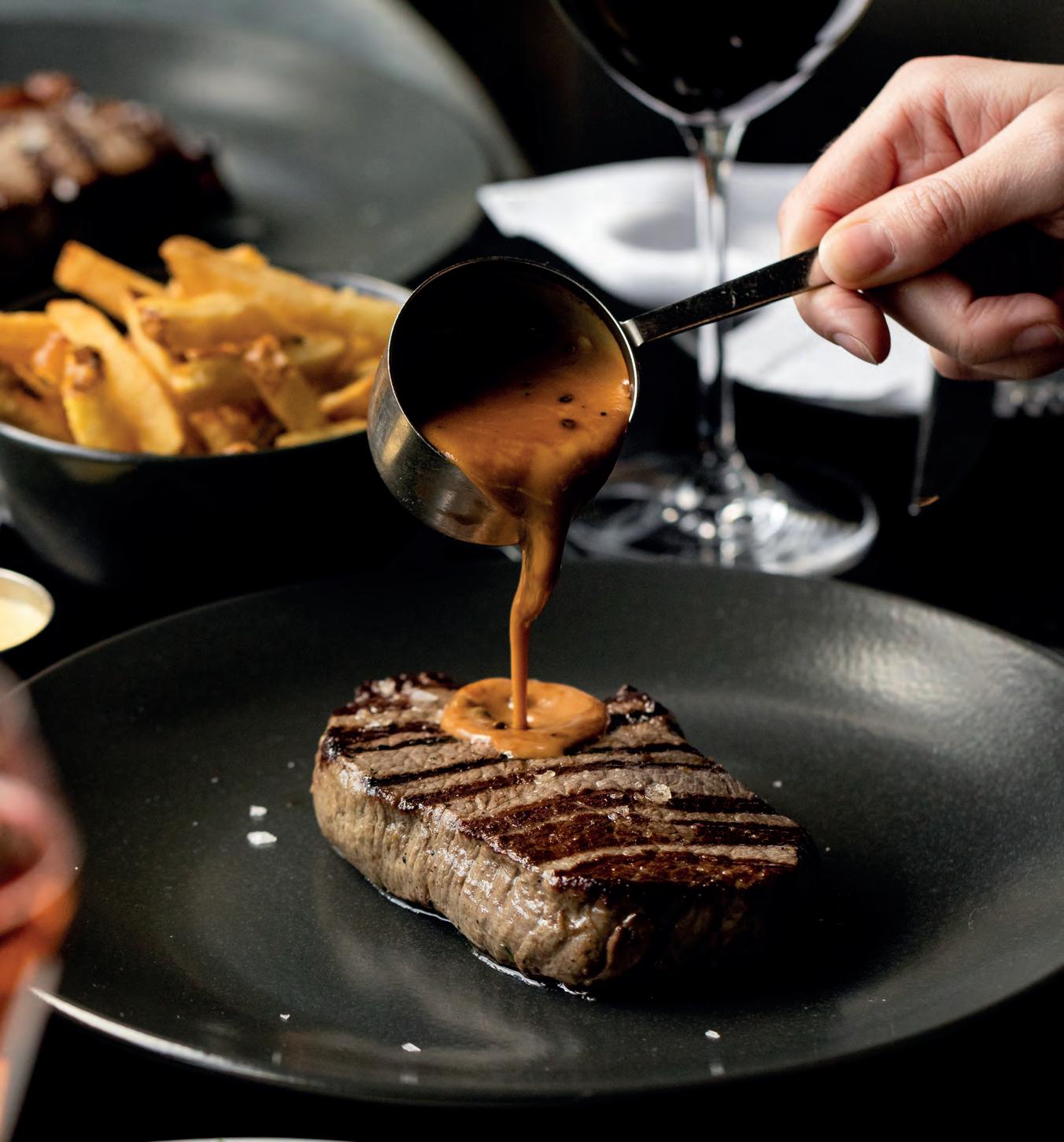
Serving the world’s best beef to your table
Our collection of restaurants in the UK has grown to twelve in London and eight regionally in Leeds, Manchester, Birmingham, Edinburgh, Glasgow, Liverpool, Newcastle and Cardiff.
gauchorestaurants.com | @gauchogroup Book Now

30 INTERVIEW
THE SERMON OF BENEDICT CUMBERBATCH
One of Britain’s finest actors tells ADAM BLOODWORTH about the ‘heaven’ of family life, going grey, and finding joy in the misery of his new role
I’m under strict instructions not to ask Benedict Cumberbatch anything personal. “He doesn’t do profiles,” I’m warned ahead of our interview. Arriving at the posh London hotel hosting the press interviews for his new six-part Netflix drama Eric, a publicist pulls me away from a pile of shiny pain au chocolats to whisper the rules once again, just to be sure.
It’s understandable. The 47-year-old had a stalker break into his garden last year, digging up plants and throwing them at his windows, while he was inside with his wife and three children.
Relaxing on a cream sofa in one of the suites, Cumberbatch is nothing like the highly-engineered publicity machine that precedes him. An empty wrapper in front of him suggests he has just demolished a Twix. He’s spoken about feeling old, but today he’s dressed more Gen Z: baggy cargo pants, white tee and a bracelet bearing multicoloured flowers. We’re settling into the first beats of conversation when he almost immediately breaks the rules. “As a parent, it’s a very hard watch,” he says of Eric, the new Netflix drama in which he plays an alcoholic father who mentally unravels when his son goes missing.
Cumberbatch seems to specialise in playing messed up men. Doctor Strange propelled him to the A-List and Sherlock first put him front-and-centre in the nation’s minds. He was also nominated for Academy Awards for his turns in The Power of the Dog and The Imitation Game, both of which feature complex, psychologically scarred men. But when I suggest this, he baulks. “I don’t think I’m drawn necessarily to darkness,” he says. “I’m drawn to a lot of light as well. I’ve played 115 characters over 20 plus years, so I’m going to be, every now and again, treading on something familiar. That’s just unavoidable.”
Having a conversation with Benedict Cumberbatch is a slightly dizzying experience. He speaks in a spiralling stream of consciousness, thoughts spilling out, sometimes fully formed, other times in fragments. He’ll start a sentence on one subject and by the time he’s finished it he’ll have launched into a whole new topic, having touched upon several others in the interim.
“But it’s important not to shy away from the darkness,” he continues. “Sometimes in culture we want to knock the edges off, or if there’s darkness it’s sort of cute and cool rather than speaking to the deeper well, the mass of grey, filling in the gaps between good and bad, likeable and unlikeable.”
In recent interviews Cumberbatch has deflected personal questions, but today he brings up home life multiple times, always unprompted. It’s late in the afternoon and he tells me he’s “sleep deprived,” so perhaps that’s it, but I suspect his openness is testament to him being a fine conversationalist, unwilling to swerve the necessary context if it can strengthen his answer. He feels he ought to set boundaries but when he gets into his flow, he struggles not to engage fully and earnestly. If anyone was born to deliver a sermon, it’s Benedict Cumberbatch.
He’s also a polymath, learning to play the banjo in The Power of the Dog and how to puppeteer in Eric. He executive produced Eric, as he did on The Power of the Dog, so when the acting stops, he doesn’t. If there’s a behind-the-camera issue he’ll try to “mull it over at the end of the day”.
In Eric he plays Vincent, an alcoholic father dealing with his own sense of parental abandonment when his nine-year-old son goes missing. What follows is a gripping drama about the unwinding of a man. It’s interspersed with fantasy when Vincent hallucinates a
31
Benedict made his acting debut in A Midsummer Night’s Dream as Titania, Queen of the Fairies, aged 12
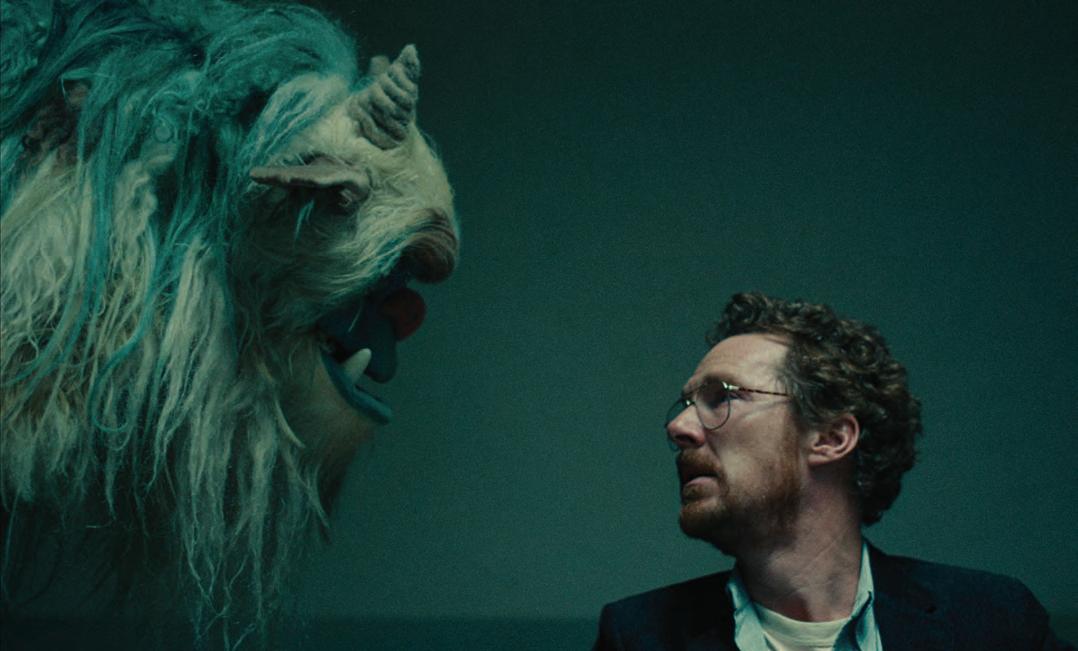
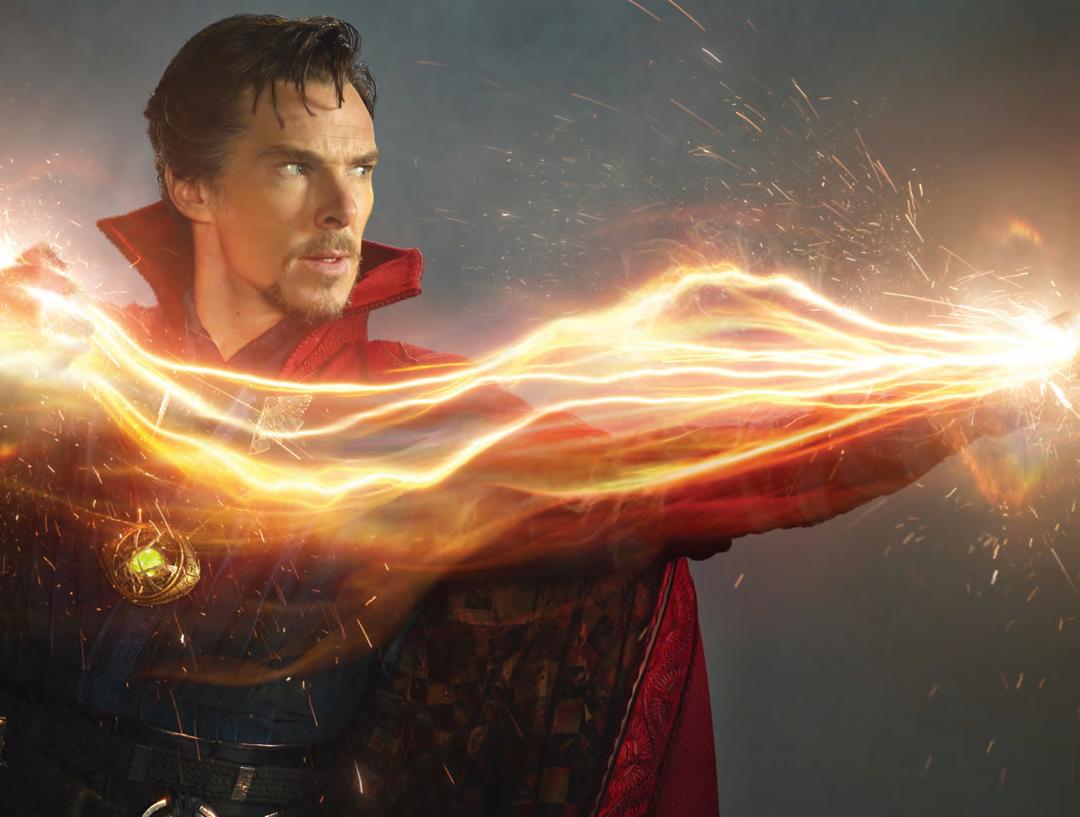
32 INTERVIEW
From top: Benedict starring in new Netflix series Eric, opposite a giant, imagined monster; He has announced he will reprise the role of Doctor Strange in the Marvel Cinematic Universe
Sometimes in culture we want to knock the edges off darkness rather than speaking to the deeper well, the mass of grey, filling in the gaps between good and bad, likeable and unlikeable
giant monster from a fictional TV show, thinking it’s following him in real life. It’s a brilliantly strange, unwieldy set-up; reading lines to a seven-foot-tall puppet is surely his oddest gig yet.
“What a privilege for me to be able to have these deep dives into the very worst of it and hopefully come up with some kind of redemptive message,” he says. “In this case it’s about love. It’s about reconnecting and taking responsibility and moving away from the things that are damaging us, coming out of the darkness of that and into the light of a new beginning.” He circles back to the idea of never going back to a certain type of character, revising his answer: “That’s a story worth repeating a few times.”
Vincent, dreamed up by Abi Morgan –the writer behind The Iron Lady, Shame and Suffragette – is quite unlike anyone else. “It’s rare to bring something this complex into life,” Cumberbatch says. “He’s a functioning alcoholic who’s already had a mental collapse, from this unloved childhood where he was sectioned off as an embarrassment and pumped full of pills and no love. It would be hard to dredge that up every single day if it wasn’t already so brilliantly realised on the page.”
He says of his creative process: “It’s really about charting a lot of complex things, giving as wide a variety as possible for the edit with people you trust. And that means a lot of work, and creating enough to fail and fail better. You’re fuelled by so much that you can really, really feel free to let go.”
Did he let go, surrendering to the role? “Yeah, wonderful moments of freedom.” Then Cumberbatch goes into one of his knotty thought trails that tackles five or six different subjects as if it were one thought, his mind jumping from one thread to the next non-sequitur. “Fighting with yourself in some weird, clammy chalk pit, throwing yourself onto floors trampled on by 1,000 extras. Then being on a dance floor and dancing in sync with a giant seven foot tall puppet, jerking twistedly like a crazed person.”
If it takes time away from family the role has to be “worthwhile,” he says, especially as Eric involved filming in Budapest. “My family came there, but it was time away from home. There are other things to consider as well, but you know, that’s the primary concern when taking a job really.
Is this going to be interesting? He’s a hard character to lean into, but to play him was a source of joy.”
Cumberbatch lives in London with his wife, theatre director Sophie Hunter, and their three children, aged between four and eight. Born into a family of actors, his mother Wanda Ventham and father Timothy Charlton both had careers that began in the 1950s. He recalls growing up surrounded by the film and TV landscape and being backstage on sets.
Charlton saved for Cumberbatch’s “ludicrously expensive education” at Harrow school in north London, and today the actor says he works to make them proud. It was there he made his acting debut in A Midsummer Night’s Dream as Titania, Queen of the Fairies, aged 12. His professional debut came in 2000 on televised hospital drama Heartbeat; a year later he made his London stage debut. It was in 2004 that he first came to mass attention playing Stephen Hawking in the Stephen Moffat drama Hawking (Moffat went on to write Sherlock, the two remain close friends).
Cumberbatch has spoken about crippling self-doubt, and finds watching his work back “horrible”. The idea of the inner critic, something Cumberbatch has spoken about in the past, is explored through the show’s puppet, the titular Eric, who is “reflective of the monster in all of us,” he says.
“The damaging nature of an overbearing inner critic, slamming the blame and shame into someone to try and paralyse them. I think we have all experienced variants of that at some point in our lives. I’m 47 so I’ve lived a bit now, and it’s full on. Hopefully not as much as Vincent but it’s made real in this, it’s made external.”
More than once he circles back to the implication that, at 47, he is getting on. Does he feel old? “I think there are stages of your life when you really feel your age,” he says. “Having three young children is a reminder that time goes by very, very quickly. I haven’t been back to back [with work] – when you’re constantly doing stuff you don’t notice the gradual change. But when you’re sitting in the make-up mirror after a six month break you’re going ‘Wow, grey hair! There’s lines!’ It’s not, ‘Oh my god, I’m old,’ it’s ‘I’m old, that’s a fact’… I’m older, is what I should be saying. I’m not old, it’s fucking infuriating when people in their 30s say that. It’s just an acknowledgement that time is passing.”
The passing of time focuses the Londonborn actor on what’s truly important. “Leaving the work at work is so easy,” he says. “I’ve got three people at home who demand that immediate, present tense nowness and,” he pauses, slowing and softening his voice to a breathy whisper: “It’s heaven.” He goes into soft, quieter speech whenever he talks about his family: “It’s the greatest thing, and we have to give them a lot, we have to hold them and give them boundaries and all of the tenderness but let them be free to teach you. It’s an amazing, enthralling journey.”
“I only really pop out for these things,” he adds, referring to our interview, falling back into the sofa and hugging his left knee to his chest. “I’m not at every shoe store opening like I used to be as a young ‘un, when you have the energy and time and the curiosity.”
I think we have all experienced he damaging nature of an overbearing inner critic, slamming the blame to try and paralyse yourself
Before we go I get a glimpse of life behind the Benedict Cumberbatch curtain. He’s mid-sentence but rises up from the sofa and spins around to where his rep has already positioned his coat at the exact height of his outstretched hand. We say our thank yous, then he marches down the corridor. No one is prepared for him to leave but he’s got somewhere to go. Exec producer hat back on, he bowls over to a publicist for confirmation all the interviews have gone well, then he’s out of sight; it was too quick to tell whether it was the stairs or the lift. Benedict Cumberbatch was in control.
33
lll
A DAY WITH THE URBAN FOX RESCUE CREW
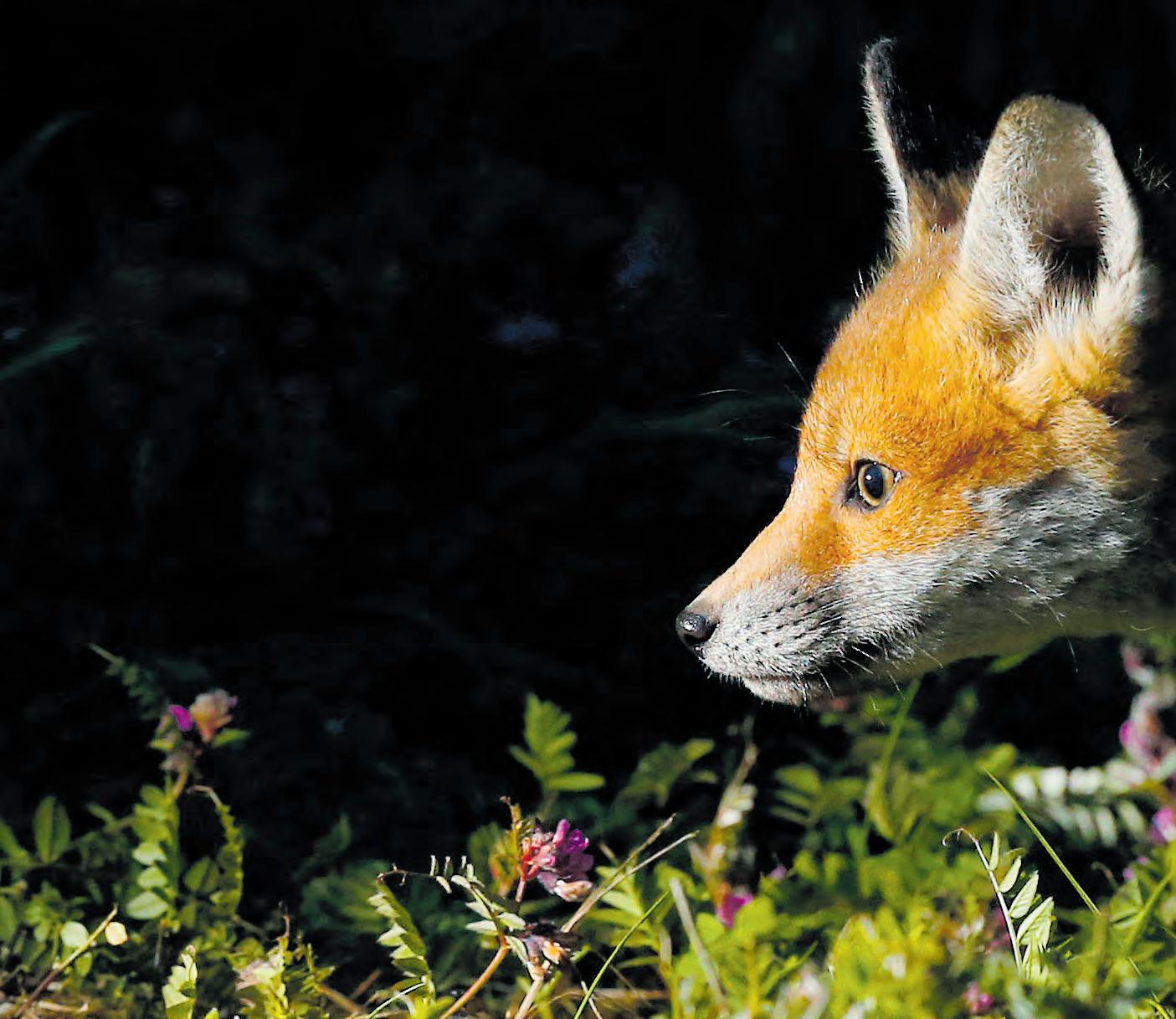
They have lived among us for millennia and form the basis of myths and legends. But despite humans co-habiting in cities with the urban fox, relations can be strained. ANDY SILVESTER joins former rocker and founder of The Fox Project for a day helping to rehabilitate injured vulpines. Pictures overleaf by ARIELLE DOMB
In October 1969, Trevor Williams, the lyricist and bassist for prog rock group Audience, took to the Lyceum stage to open for Led Zeppelin. A month later, at the same venue, he opened for Pink Floyd. After being snapped up by Genesis’ record label Charisma, Audience appeared to have a bright future ahead of them. But three years later, following a US tour with Rod Stewart that was considered by all involved to be very successful, the band split. Their last record, Lunch, was finished with the help of the Rolling Stones. They’re one of those groups that came tantalisingly close to megastardom, only to fade into relative obscurity. Today they maintain a cult following but average only around 6,000 monthly listeners on Spotify.
It is a glorious Friday morning in May when Trevor invites me into the cottage in Kent he shares with his wife Sue. I walk over a fox doormat, duck under a hanging fox ornament, and pass by lashings of foxadjacent material on my way to the kitchen, where Trevor is making a cup of tea. “The problem with being
34 FEATURE

so strongly associated with one thing,” he tells me, “is that everybody buys you stuff with it on.” You see, while Trevor may once have been on the same line-up as David Bowie and Black Sabbath (for the Atomic Sunrise festival of 1970), these days he is known for something quite different. These days he is the fox guy
At the bottom of his garden, about 20 yards from the kitchen, no fewer than 21 fox cubs, born just weeks ago, crawl over each other. Trevor swapped rock stardom for The Fox Project: a charity, of which he is the CEO, that rescues injured or young foxes, nurses them to health and independence, and releases them back to the wild. In 1992, The Fox Project took in three foxes. Last year, the hospital, ambulance and care home combined took in 1,400.
Scientists differ on whether the red fox – vulpes vulpes – is native to Britain. There is some evidence of foxes roaming through Warwickshire more than 135,000 years ago; the earliest specimen found anywhere was in
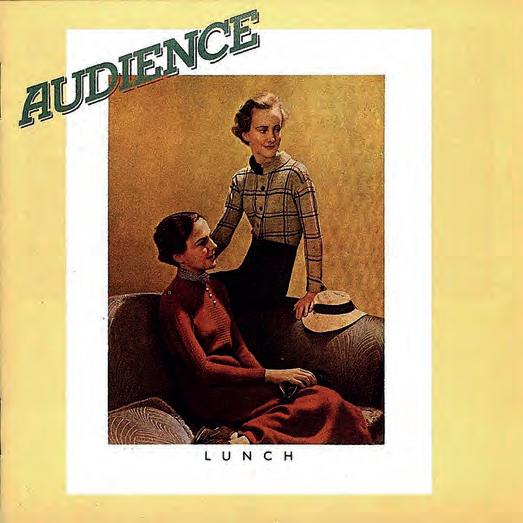
Hungary, dated sometime north of 1.8m years ago. The relationship between them and humans ranges from companionable – foxes have been found buried alongside humans in the middle east – to mythological, most notably in Japan, where the famed kitsune forms the basis of a thousand trickster stories.
They also serve as prey. Trevor met Sue, his wife of 36 years (“we didn’t get together for twelve years – he needed to grow up,” Sue chuckles), when they were hunt saboteurs. “It was the sense of injustice,” Trevor says. But disrupting hunts wasn’t enough: he wanted to set up an advice line, providing information on foxes that wasn’t from either the pro-hunt lobby nor the extreme anti-hunt campaigners. “There were myths and legends and misunderstandings and there really was nowhere else to go to.” That turned into something more substantial, located not on the green and blood-soaked lands of England’s historic counties but in south London.
There are around 300,000 foxes in the UK today, a good 10,000 of which live in London. That number has remained pretty stable. Urban environments, after all, suit these natural scavengers, providing them easy access to food. The fox population at large is resilient, and has shown an extraordinary ability to adapt.
Foxes began what we might call their ‘urban phase’ in the 1930s and 40s, exploding after the war into the burgeoning suburbs. Councils, faced with a problem they barely understood, didn’t have much power to deal with these new residents, and yet they were held responsible. Most decided to simply shoot them, especially when they edged into gardens or parks or hospitals. Bromley, on the border between London and Kent and now part of The Fox Project’s territory, once employed a fox control officer who blasted 300 in a year.
The problem, Trevor explains, is that culling foxes doesn’t even work. Clearly it’s not ideal for the fox but neither does it reduce their overall numbers, with a raft of scientific studies showing that culls only temporarily displace a population, sometimes for a matter of days.
35
lll
From left: There are 300,000 foxes in the UK, with around 10,000 of them living in London. Foxes began what we might call their ‘urban phase’ in the 1930s and 40s, exploding after the war into the burgeoning suburbs; The cover of Audience’s final album, Lunch, which was finished with a little help from the Rolling Stones
lll

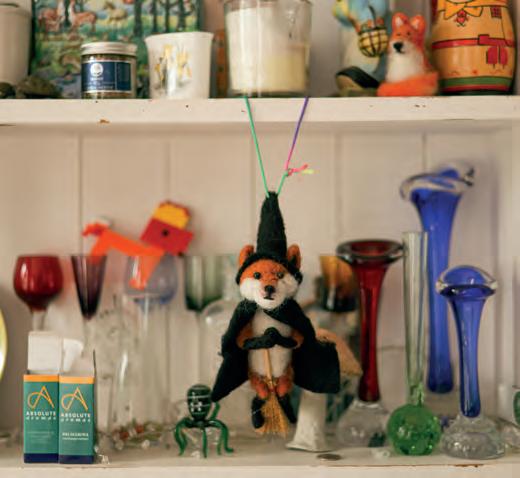
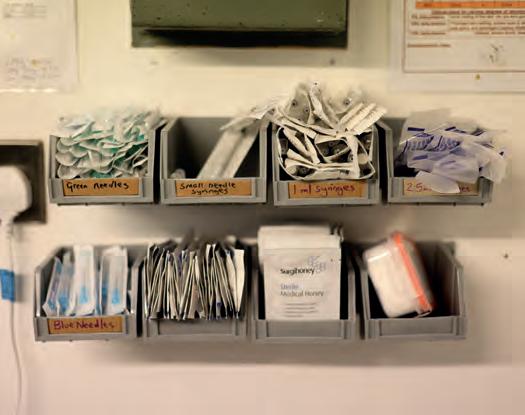
A far more effective threat than guns or hounds is the car, which is responsible for as many as half of all fox deaths. Other dangers are less obvious. Netting is a particular problem, from goal nets in back gardens to protective netting around plants. Foxes get caught and panic, often tearing their flesh in an effort to get free. The well meaning but ill-informed might cut the netting to free the fox, but those wounds, when infected – which happens often – can turn very nasty indeed. The best thing to do is call the professionals.
lll
The Fox Project is pretty simple. The public see an ill fox or an abandoned cub and call the charity’s emergency line. From 9am to 9pm, every day, there are ‘fox ambulances’ doing the rounds. If there are too many calls, ‘fast responders’ are on hand to help. Unlike real ambulances, they invariably turn up quickly.
Sometimes, an ill fox will need to be trapped, in which case The Fox Project will work with a concerned homeowner to set up a regular food pattern, and then catch them in what amounts to a gigantic, humane, non-lethal mousetrap. Lost and ill cubs head to Trevor’s garden to bulk out, spending time with other cubs and forming familial bonds before heading to ‘foster’ gardens around the south east. Ill foxes – common ailments include mange, injury, and so on – head to the fox hospital in Paddock Wood, a ten minute drive away from Trevor’s place.
If the idea of a ‘fox hospital’ conjures images of a bucolic country farm, you’d be wrong. It’s in a nondescript industrial estate which, apart from the over-indexed amount of fox paraphernalia adorning the vehicles in the car park, does not scream ‘wildlife sanctuary’. Inside, however, is a command and control centre crossed with a field hospital: it is quite the operation. A volunteer who handles the phones and organises the logistics of the rescues waves as she takes
36 FEATURE
From top: A cub rescued by the Fox Project fattens up before being released back into the wild; Trevor Williams has found his Kent home filled with fox paraphanalia after founding the charity; Filing cabinets filled with syringes used to treat injured animals at the animal hospital
In a concrete world, there is something almost transgressive about our furry neighbours, wild dogs that live underground and come out at night to poke around our gardens
another call, looking every bit the emergency dispatcher.
In the main room, Nikki shows me the pens: I meet Geordie, who came in dazed and confused but is finally getting back to his full diet. The working theory is he was hit by a car but not hard enough to be injured, just a tad… concussed. Then there’s Dave, who was found with a massive abscess across his back; he’s recovering after having it lanced. JonJo is in a rougher state: he was bleeding badly when he was rescued, with staff thinking he’d crawled through barbed wire. He’s had stitches (and a shave) and today’s rather challenging task is to clean his wound, which involves covering his head with a towel and grabbing him by the scruff of his neck to administer the medicine. JonJo is less than thrilled by proceedings but just about gets the wash he needs. Elsewhere, Chelsea is getting back to health after being found hiding at the back of a shed, covered in often-fatal sarcoptic mange.
Others that come in are victims of what Trevor calls “misadventure.” Jaja, for instance, is not named after the controversial Star Wars character, but the jam jar he arrived in, having popped his head inside to see what remained. He was fine, and released back to the wild with a salutary lesson in the dangers of curiosity. Jaja’s moniker is unusual, says Trevor, with most rescued foxes being named after a nearby park or landmark.
“The one name we’ll never allow is Basil,” he says.
Today, at least, it seems those in the hospital’s care are on their way back to health. That is not always the case.
The ultimate aim is to be able to release the foxes back to the wild but the hospital’s success rate, Nikki tells me, is around 40 per cent. “When you’re putting them to sleep, you know you’re taking the pain away,” she says. Earlier in the day, Trevor, Sue and the various volunteers pottering about the cub sanctuary talked in hushed tones about “last Saturday.” More than a dozen foxes came in. Not all of them – some cubs, some adults – made it. How does Trevor deal with the loss? A sigh. “You have to be pragmatic,” he says. “And you have to move on, which you do, because more come in.”
Another sigh. “Now and again it gets you. You find yourself grieving a little bit. But… you’re just trying to give those that make it another go, a second chance.”
While few people appreciate their bins being torn up, there is an undeniable thrill to catching sight of a fox from the top floor of a night bus, or a bushy tail disappearing over the back fence late at night. One viral video, which did the rounds on Youtube last year, saw an urban fox wrangle not one, not two, but three chicken drumsticks into its mouth to take back to its den, before hopping over a four foot fence. Trevor tells a story of a lady in Greenhithe, near Dartford, a place not famed for its pastoral beauty. “She said seeing foxes
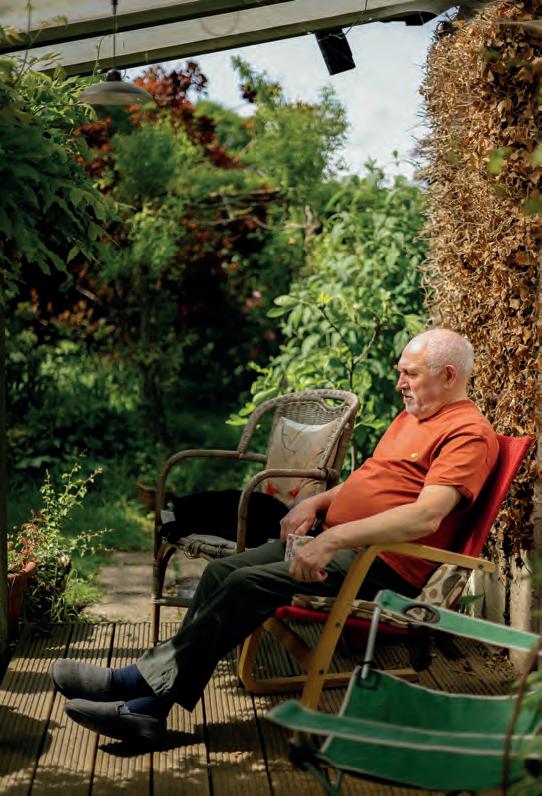
connected her to something, to the land. I’ve never forgotten that.” In a concrete world, there is something almost transgressive about our furry, mischievous neighbours, wild dogs that live underground and come out at night to poke around our gardens.
Sitting in his idyllic Kent garden, Trevor seems content. He may no longer be sharing a stage with some of the biggest bands ever to pick up a guitar, but he’s the picture of a man who has found something rewarding to do with his days. He dreams of opening a proper wildlife hospital, but says he has run into difficulties with land-banking developers, planning departments, and an ever-present shortage of cash. Still, he perseveres.
As I leave this secret haven for foxes, I remember something one of the volunteers told me. When cubs are deemed healthy enough to live on their own, and older foxes have recovered from their ailments, they’re released as close as possible to where they were found. Once free, the foxes instinctively bolt. But then, a few seconds later, they turn back to look at their human rescuers. The fox is probably checking it isn’t about to be caged again – but it’s tempting to think it’s a little thank you.
l The Fox Project is raising funds for new veterinary equipment. You can find out more at foxproject.org.uk
37
Trevor Williams once opened for Pink Floyd and Led Zeppelin with his prog rock band Audience – he has since swapped the stage for his rescue charity. Here he enjoys a breather in his idyllic garden in Kent
lll lll
WASHED AWAY
Slipping on a swimming cap and goggles, LUCY KENNINGHAM dives into the strange, nostalgic and slightly grotty world of the municipal pool, a reassuring constant from New Cross to New Delhi
In the swimming pool we can both forget who we are and dream of becoming someone else,” writes former competitive swimmer and author Piotr Florczyk in his short study, Swimming Pool. And indeed, when I ask myself why I used to slouch down to the municipal pool, towel trailing behind me, practically every day one summer it was – I feel – a way of washing myself away.
It all starts with the aggressively utilitarian building you walk into. You push through a turnstile, venture down slippery, grotty steps into a dingy room. Shoes off, you abandon your clothes, jewellery and other detritus. In a murky puddle of water masquerading as a footbath, you cleanse your feet. With your face obscured by cap and goggles, you leave the tiled hallway for the cavern of the pool. You plunge in and the water hits you. Cold chlorine rushes up your nose and water seeps in through the gaps around your goggles as you find yourself submerged. You squint and shiver. You come up desperate for air. Then, like Jesus parting the Red Sea, you separate the water that enfolds you with scooped hands. Using strokes you first learnt as a child, you strike through the water. When you reach the end, you flip over and continue shuttling between two walls in a sunken pit filled with chemically-treated liquid, housed in a large, echoey building
full of gymmers and swimmers, showers, tiles and mops.
There is an intensity that’s integral to the act of lowering yourself into water and propelling yourself through it. If you don’t move, you’ll drown. Humans were not made to swim, so the very act is a rebellion against nature. We are not dolphins, nor sloths, who can apparently hold their breath for 40 minutes underwater.
The swimming pool is defiantly uncool. Nowhere is this more true than in sunny southern France, where I lived for one infernally hot and oppressive summer. Here anyone who wants to display their beach body, flirt, get a tan or bask with any other libidinous intention could simply cruise on the tram down to the beach. The pool, by contrast, is for swimming. In France, nearly everyone in the pool had some sort of flotation device or flippers. This gave fully grown adults the appearance of not being able to swim in a manner I found curiously un-French.
For a place where we undress and parade around with bare legs and arms, the public swimming pool is remarkably unsexy and unsexualised

For a place where we undress and parade around with bare legs and arms, the public swimming pool is remarkably unsexy and unsexualised. This is very much not the beach. Oldish, sometimes yellowing polyester (I’ll hold my hands up to this) prevails. It’s all Zoggs and Speedos (brands which, beguilingly, don’t even try to be cool). Perhaps this has something to do with what George Orwell described as the “naked

38 ESSAY
lll
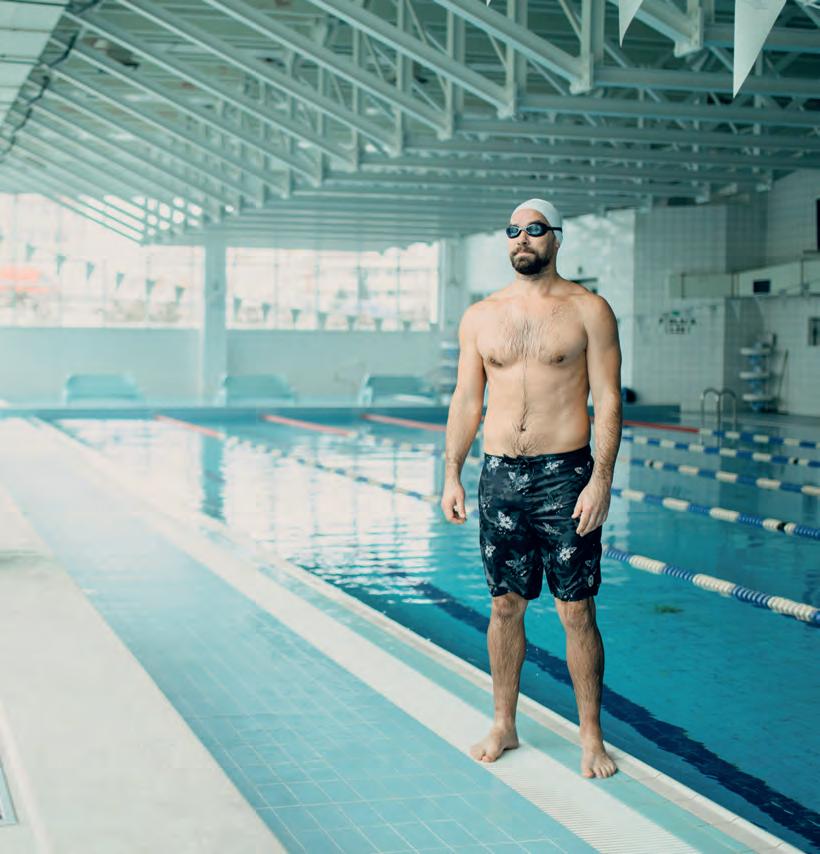
democracy of the public swimming pool”.
In this regard, swimming is diametrically opposed to running, which has become an aspirational way to spend a weekend. This has been wholly unwelcome for veteran joggers like myself, who want no part in a fashion parade. But unless you’re charging down a hill in the middle of the Lake District, it’s hard to fully disconnect yourself from your surroundings.
Runners flaunt their gear: a branded cap, running belts, watches, socks, headphones, headbands, tights, laces, the newest neon carbon-plated shoes and heart-rate monitors. Brands are inextricably linked to running. Nike, Adidas, Saucony, New Balance, Hoka. Swimming is different. We wear our faded Zoggs costumes and ropey
old goggles. A few people track their swims on Strava but it’s mercifully rare even for fitness fanatics. The resulting map (a generous description) is simply too dull. There just ain’t much glamour in chlorine and the echoes of screaming kids. I think that’s why pools are so endearing. We are laid bare, equalised in a way that rarely happens anywhere else.
When I thought about going swimming for this article, I felt the same fear I used to feel each time I approached the French piscines. Perhaps you could call it the fear of exposure. Not only was I going to throw away the comforting consumerist individuality of my clothes, wipe my eyes of eyeliner and stuff my hair into a
There is something alluring about the municipal swimming pool, places steeped in childhood memory where we cast off all the physical markers we use to identify ourselves
nondescript swimming cap (in France, they are mandatory), worse still I would be without my headphones (at the time, I was very into Hot Chip due to the influence of my cousin’s boyfriend).
There would be no Huarache Lights or Over and Over to haze over my anxieties as they did for many of the other waking hours of my day. You have lost the soundtrack that distracts you from your life. In the pool, stripped of your identifying markers, you are forced to be alone with your thoughts.
With each length I thrashed out in the pool (I would swim for at least an hour each session), I erased the horror of my latest linguistic faux pas. I am doing the most boring thing possible, I would think, as I counted lengths, usually from one to 40 (another legacy from my father, who had happened upon this number due to its equivalence with one kilometre) but often to more than 100. Sometimes you stumble upon some semantic tangent that lasts enough lengths to dislodge the count from your head. After a time, the goggles cut into your flesh. You start to feel empty, which is strangely thrilling. For a while you glide, fly, slice, float, chop. Each stroke leaves you lighter.
What draws me to the pool is the thrill of belonging, momentarily, to a temporary world. When you’re in the water, it’s a secret club that exists for the hour or so you are there. Not unlike a London bus, the pool invites an extraordinarily wide variety of people. There are factions: you align with those in your lane and seethe at any poor etiquette displayed by new entrants. You become familiar with the speed and strokes of your comrades in aching arms.
For a while, I frequented Peckham Pulse, which has the benefit of being totally free for residents of Southwark every Friday and Sunday afternoon. Otherwise, swimming costs £5.65, which is within the realm of possibility for most Londoners. The highest strata of society will not be attending Peckham Pulse but everybody else does: children, exercise nuts, the employed and the unemployed, the fit and the unfit. There is a lane for you all (just don’t get in the wrong one).
At Hough End Leisure Centre, a modern

39
lll
affair with windows that stretch out onto Hough End Park in south Manchester, groups of men would visit just to chill, as if it were a Parisian coffee bar. They would lounge at the side for hours.
Balham Leisure Centre, meanwhile, is a particularly unpleasant building to spend time within – but that didn’t stop frequenters banding together; if anything it brought us closer. Older people and retirees and the unemployed tended to dominate during daytime hours.
I would enter, strip off in the changing rooms – avoiding the dirtiest parts of the floor in my bare feet – dump my stuff in a plastic tub and set it on the benches that line the side of the pool (there is a surprising amount of trust in this very un-London-like action). Then I would slip into the pool, normally in the fast lane due to my fellow swimmers being over 75.
It wasn’t hard to strike a rhythm with the others. Elderly posh-ish women floated past with impeccable posture, whereas I preferred to dunk myself in and out in a loose, intense interpretation of breaststroke. There was one particularly ghoulish-looking man with sunken eyes who, in my head, was known as The Corpse. The Corpse used to sporadically clamber out of the pool and dangle his frail, skinny, pale frame over the side until it cleared, then he would arch his body and dive, hurtling along the bottom of the pool for one entire length (25 metres). Inevitably, The Corpse emerged spluttering and sickly. I both hated and admired his expectation that an entire lane of coswimmers would clear themselves for his little performance.
“Pushing off we can literally let go of things”, Florczyk writes. Perhaps that was what The Corpse was doing. Who knows from what? Thanks to the anonymity of the pool, I could never ask him.
Nearly everyone has been to the swimming pool. Most attend lessons as school children. There are classes for babies, older people and people with disabilities. If you ask those around you for their recollections of pools, it is revealing. “The rapids at Centre Parcs!” one colleague grins with childlike glee. “The big float in the leisure centre on Saturday mornings!” “Swimming parties!” “Chocolate from the vending machine!” “The machine that dries your towel!”
I found these answers telling. Swimming as an adult is a monotonous grind. But the
word ‘swimming’ tends to conjure up memories of fun-filled family days out. As adults, we insist on extracting the fun from every physical activity, bar sex and perhaps exotic romps like Zumba. Not so for children.
I asked my family for their most profound memories and reflections on swimming pools. “You, burning to a crisp, while a thousand wasps perished in a bowl of jam by your side,” my brother immediately replied. That’s not the sort of enchanting and ephemeral image I was looking for, I wrote back. Yet so often, for paleskinned people, this is the reality (and another reason, you might think, to stick to indoor pools).
My father did most of his swimming in the large outdoor pool in the British High Commission in New Delhi, India, where I spent a significant amount of time between the ages of six and 10. It was a pool that had to be cooled due to the baking sun, full of children in colourful wetsuits (to avoid sunburn) and tanned or redding diplomats sweltering in a colonial compound.
I learned to do handstands, dive, hover at the bottom to let my sister use me as a surfboard, and would run around maniacally with three girls who looked and dressed identically to me, pretending to be quadruplets to anyone who would listen. My dad pretended to be a basking shark named Barry who would eat us (in a kind way). This was the exciting new world opened up by the pool: the possibility to become someone else. In reality, the whole thing was an unforgivable luxury for mostly whiteskinned diplomats in a country where 163m
Clockwise from top left: Swimming pool changing rooms are strange, ugly places; The swimming cap is a singularly unsexy piece of sportswear; The counting off of lengths can be a mind-bendingly boring experience
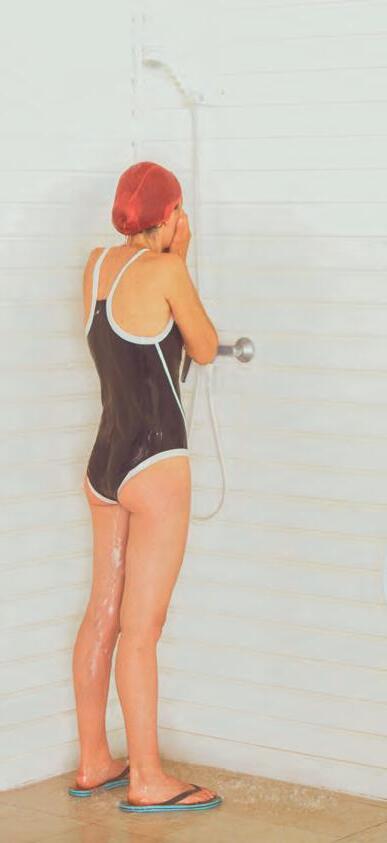
What draws me to the pool is the thrill of belonging to a temporary world. When you’re in the water, it’s a secret club that exists for the hour you are there
Indians lack access to safe drinking water. That is the thing about pools. Despite the 1960s-built crumbling and moulding leisure centres of modern Britain being rather decrepit, they represent the extremes of affluence. It is, after all, very unnatural that we dig out 25m long pits, fill them with water and chemicals, then jump in and travel up and down them repeatedly. It is an unthinkable waste of resources, in many ways. The pool itself is a symbol of “control over the uncontrollable” writes Joan Didion, from southern California where “the apparent ease of life… is an illusion”.
In Montpellier, southern France, there were lots of municipal piscines to choose

40 ESSAY
lll lll


from, and I tended to switch between two preferred options. One was the Olympic swimming pool – Piscine Olympique d’Antigone – flamboyantly named after the daughter of Oedipus and heroine of Sophocles’ tragedy. The other was a white-tiled basement pool called the Piscine Pitot which felt like discovering a secret each time you entered.
The Olympic pool, by dint of being Olympian sized, required a more Herculean strength to get through. In a bizarre and rather unchic twist of history, the Olympic pool is in a district of the city named Antigone. Due to the whim of 1970s mayor Georges Freche, each building, square and street name is inspired by the architecture of ancient Greece. This is enchanting in theory (ah,
to stroll down Rue Poseidon…) until you’re faced with the reality. The anachronism isn’t subtle: grand columns, a horrid statue of Venus and a huge, curved, Soviet-sized municipal structure.
The Antigone pool itself had steps leading up to a nasty, blue-grey, translucent – yet also reflective – exterior that said ‘welcome to the dentist’ rather than ‘enjoy your swim’. Piscine Pitot, on the other hand, was a basement pool under a palatial and futuristic square with odd, white, metallic lattice structures in it.
Inside, the lighting was dim (why don’t they do this in England?) and if you went in the evening it played soft, ambient music. It was painfully tasteful. When you emerged you could see French kids fencing in the room next door. En garde! they cried, netted
metal shielding their faces as they leaned forward to mock stab one another.
The only problem was the opening hours:
MONDAY: 12–2 PM
TUESDAY: 12–2 PM, 5–8 PM
WEDNESDAY: 11:30 AM–4 PM
THURSDAY: 7:30–9 AM, 12–2 PM
SATURDAY: 2–6 PM
SUNDAY: 9 AM–1 PM
They remain so to this day. The questions of who wrote this timetable, what on earth they were fitting it around and how the pool made any money (entry was two euros, even in 2023) all go unanswered.
Despite the undeniable allure of the swimming pools, fewer and fewer people are choosing it as their pastime. Between 2010 and 2023, 400 pools closed in England (not just due to lack of funding, given many leisure centres are privately owned), which is a terrifying prospect for the nation’s young swimmers.
There has, mercifully, been some backlash to this decline. A splash of hope was the campaign to save Withington Baths in south Manchester. A detailed Edwardian red brick building with a conservatory roof, Withington Baths first opened its doors in 1913. Its architecture, stained-glass windows and period tiles drench it in charm and elegance, words that will never be used to describe the likes of Peckham Pulse or Deptford Wavelengths.
In 2014 the council proposed shutting it, along with two other pools, to save £80m from its budget. Locals fought back. Love Withington Baths mounted a two-year campaign that saved the pool from closure. Having lived in Withington, I can say with certainty that the baths really were a cornerstone of the community.
But Withington is simply a shining example of a universal truth. The swimming pool is, paradoxically, a place of both solitude and community. It’s a strange human ritual practised in Manchester, Montpellier, New Delhi and every other town across the world. Most cities have a cluster of swimmers who find some solace in the churn of repeated strokes. Together, but alone. Not you, but another version of you. The pool is a place of possibility.

41
lll
We
HEAD SPACE
are increasingly alienated from the cities in which we live. CHRIS DORRELL finds an antidote in psychogeography, a philosophy that arose in the cafés of 1960s Paris, which provides a framework to see urban spaces in a new way.
Pictures by ARIELLE DOMB
The modern world can feel disenchanting, stripped of the symbolism that allows us to relate to our environment in a meaningful way. The same shop fronts recur on streets from Cambridge to Cardiff and from Glasgow to Gloucester. Stories, which gather on streets and buildings like barnacles on a ship’s hull have been obliterated by the ever quickening pace of urban expansion and redevelopment. Modern town planning favours straight lines and a utilitarian directness. But there is a way to reclaim a degree of mystery, of serendipity: psychogeography.
On its most basic level, ‘psychogeography’ is a rather grand term for exploring how urban spaces make us feel. The modern city sits uncomfortably on a heap of discarded and vanished versions of itself. Psychogeography seeks to unearth these previous layers, like an archeology of the subconscious. Our role as active participants is to renegotiate our relationship with these places.
Psychogeography emerged in the melange of ideas coming out of Paris in the 1950s and 60s as a reaction to the rise of the modern capitalist city. Paris was extensively rebuilt in the 19th century by Georges-Eugène Haussmann. The cramped mediaeval city was swept away in favour of grand boulevards and sweeping parks. Purpose and order triumphed over haphazardness. This
continued in the 20th century as the necessities of capitalism further defined the urban landscape. Great roads and public transport networks crisscrossed the city, taking people directly where they needed to be.
A group of avant-garde French writers known as the Situationists attempted to push back. They sought out chance occurrences – situations – which could disrupt the comfortable assumptions that framed Parisian life. The leader of the movement was Guy Debord, a cigar smoking French philosopher with a penchant for penning unreadable treatises on modern life.
Debord had a thing for walking, or what he called a ‘dérive’, from the French word for ‘drift’. He described the dérive as “a technique of rapid passage through varied ambiences”. He would let himself be carried by the natural and historical fault lines of the city, which would often run contrary to the best laid plans of city planners. Industrial cities were particularly favourable to the Situationists, Debord said, because they were “rich centres of possibilities and meanings.” Debord’s grandiose ambition was nothing less than identifying the effects of the urban environment on the human mind.
His description of a dérive implies that the city is an active force, pushing and pulling an ambling philosopher through its urban landscape. “From a dérive point of view cities have psychogeographical contours, with constant currents, fixed


FEATURE 42


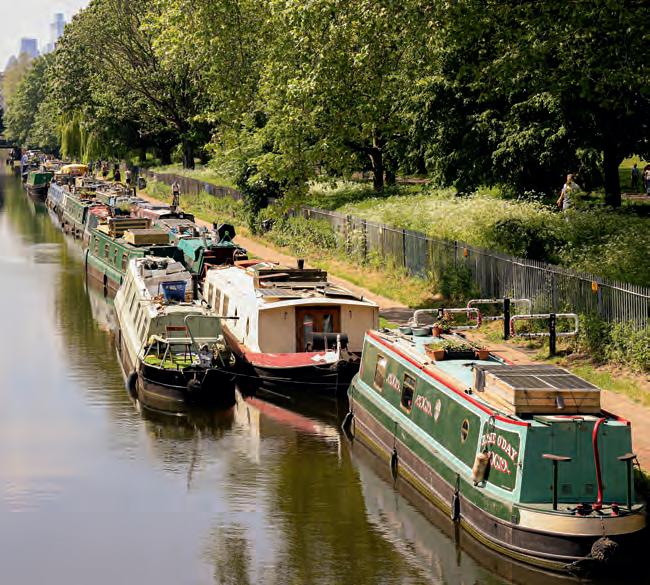
points and vortexes that strongly discourage entry into or exit from certain zones,” he wrote.
Will Self, one of the more prominent modern writers in the English psychogeographical tradition, has a more prosaic explanation of how Debord’s dérives actually worked. He described it as “meeting up at the Parc des Buttes Chaumont in the north of Paris, buying a few cheap bottles of red wine, getting drunk, and drifting down to the Ile de la Cite in the Seine where they’d sleep it off.”
Psychogeographers took inspiration from the figure of the flaneur, the urban stroller who wanders through modern society. The flaneur observes life without reason nor rhyme. The purposelessness of a dérive was to challenge the utilitarian nature of modern cities, the idea that travel had to be to somewhere.
Psychogeographers took inspiration from the figure of the flaneur, the urban stroller who wanders modern society observing life
In typically French style, however, the Situationists never really practised psychogeography, preferring to focus on the theory. But there is a distinctly English strand of psychogeography, centred around – but by no means limited to – the city of London, and this is a more hands-on affair.
London never experienced the kind of urban renewal that Paris went through in the 19th and 20th century, although it nearly did. In the discussions following the Great Fire of London in 1666, Christopher Wren presented plans for the city to be rebuilt along classical lines. Wren was a man of reason and order, who had recently visited Renaissance Rome. His London was to be a city of straight lines and columns.
His plans foundered on a simple fact: Londoners still owned the land on which their previous properties had been built. They wanted the old
43
Clockwise from main: The canalside in Bow has been extensively redeveloped, almost completely erasing the past, but the canal itself is a rich vein; The view from Three Colt Bridge, which leads out of Victoria Park down Gunmakers Lane; Tower Hamlets cemetery provides an oasis of green among the city
Left to right from top: A gravestone in Tower Hamlets cemetery, one of London’s seven great Victorian cemeteries; Looking into the Limehouse Cut, London’s oldest canal, which connects the River Lea to the Thames; The skyscrapers of Canary Wharf, built during the 1980s and 90s, have forever changed London’s skyline; Stone drinking troughs, provided by the Metropolitan Association, are found all over London – this one is on Lauriston Road, just north of Victoria Park; More than 6,000 people now live in what was once the Olympic Village in Stratford; The name ‘Limhouse’ derives from the local lime kilns – its proximity to the river made it one of London’s major maritime centres, but the sea now feels distant
streetscape back, so London never experienced its Hausman moment. This failure from planners and developers to impose some kind of order on London’s streets means it is rich pickings for pyschogeographers.
In the oldest parts of the city the urban ambience changes virtually on a street-bystreet basis. “Londoners are involuntary psychogeographers,” says Matthew Beaumont, a professor of English at University College London, labelling the practice “mischievously pseudo-scientific”. Even today London remains a hotchpotch city, physically bound to its history like some untameable organism. The realisation can be unsettling: the irrational and the unconscious lie just a layer or two beneath the smart shop fronts and neat houses.
Writer and filmmaker Iain Sinclair, for instance, claimed to have found an occult connection between six churches built by the 18th century architect Nicholas Hawksmoor. In Sinclair’s feverish imagination, the churches were placed in such a way as to form a pentagram, casting a spell over the city. This reframing of history shows the creative potential of psychogeography. The aim, Beaumont says, is to establish “subrational connections”. These connections are “idiosyncratic, eccentric and highly personalised.”
Iset out for a psychogeography expedition on the first temperate day of this miserable year, placing myself in the mindset of the flaneur. Debord has a number of suggestions to ensure a walk generates some psychogeographical insight, and they are surprisingly useful for a practice steeped in the most armchair of philosophies. “One can dérive alone, but all indications are that the most fruitful numerical arrangement consists of several small groups of two or three people”.
The sunny morning has little bearing, apparently: “The influence of weather on dérives, although real, is a significant factor only in the case of prolonged rains, which make them virtually impossible. But storms or other types of precipitation are rather favourable for dérives”.
Ironically, Beaumont suggests that imposing rules on a dérive can be a good
way of ensuring that the walk is suitably random. For Beaumont, following the course of a buried river can be a good plan. In some sense the urban environment will reflect the natural landscape, although not always in obvious ways. I opt for Regent’s Canal in east London, a place where the scars of the industrial revolution rub shoulders with the most forward-looking elements of 21st century Britain.
I pass below St Augustine’s tower, the oldest building in Hackney, dating back to the 13th century. The tower is all that’s left of the original church after the rest of the building was pulled down some 500 years later. The churchyard around the old tower now contains a cafe. Hipsters spill out, standing where once were gravestones. The graves aren’t gone though: they’re been shunted to the side, where they glare at the cafe crowd. The past is not always intruding on the present, sometimes it’s the other way round.
If you listen closely, the voices of old Londoners can still be heard. The hopeful last words of Philip Lewis Rees, who died in Hackney in 1863, are still inscribed on his tombstone at St John of Bethlehem’s church. “He who was slain on calvary; opens those pearly gates to me”. Probably not a poet in life, next to nothing else is known about him.
I slowly follow the city south. On the cusp of Victoria Park, three trees stand on a brief patch of green. They’re cut off from the park by a single road, looming over a stone drinking trough on which is written: “Metropolitan drinking fountain
Hipsters now stand where once were gravestones. The graves aren’t gone though: they’re been shunted to the side, where they glare at the crowd



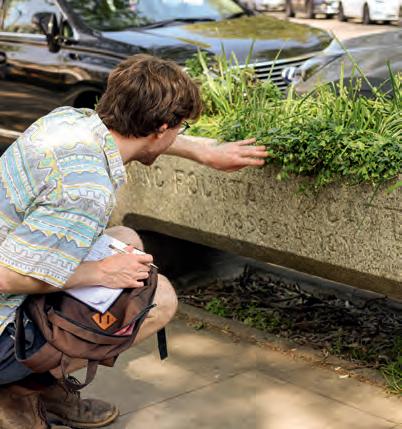


& cattle trough association”. Its origin is depressingly familiar: privatised water companies failed to provide adequate drinking water; the troughs, of which there are many scattered across London, were put there by philanthropists to provide free drinking water.
By the time I reach the canalside in Bow, London’s past feels especially distant. The canal itself, the Limehouse Cut, is a thread connecting London both
FEATURE 44
lll












spatially and temporally, but its power to transport is limited by the sharp modernity of the canal path. But then, before too long, a psychogeographical remnant pushes its way to the fore: a single, square brick chimney comes into view, looming over a Lidl car park. The chimney is almost entirely nondescript; like the unknown soldier, this lone surviving structure hints at what once must have been a forest of towers lining



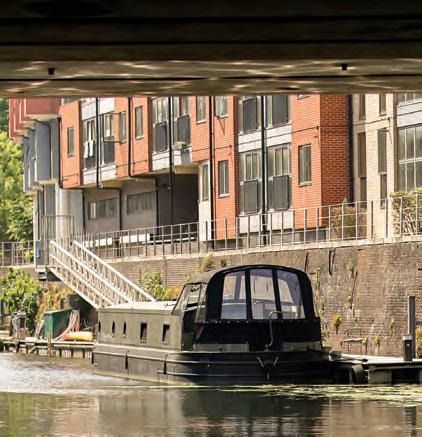

the canal. Now it’s all that’s left, defiantly facing the glittering spires of Canary Wharf.
Psychogeography is, according to some, a dying pursuit. In Sinclair’s most recent book about the capital city, the Last London, he speaks of his pessimism about the possibility of resisting the erosion of locality. He’s even abandoned
the term psychogeography: “The topic has outlived its usefulness and become a brand.” But he’s also more aware than anyone of a city’s capacity for renewal. “London stalls, revives, suffers and renews itself all the time.”
So long as we continue walking around London, reimagining it, new cities will emerge, standing on the wreckage of the old. Time to head out on a dérive of your own to discover them.
45
lll
LOST & FOUND
Actor,
musician and
–
now – whisky brand owner Kiefer Sutherland chats to STEVE DINNEEN about the state of Hollywood,
the
politics of Jack Bauer and starring in the new Clint Eastwood movie. Portrait by MORITZ ‘MUMPI’ KUENSTER
Kiefer Sutherland glugs me out a whisky as we settle into a vast sofa that threatens to envelop us both, leaving us somewhere between sitting and reclining. We’re in the London headquarters of the Gibson guitar company in a private room accessed through a hidden panel in the back of a red phone box. All four walls are lined with rows of shining guitars. I could hear Sutherland before I could see him; between interviews he “decompresses” by jamming on his own Gibson, playing songs he wrote for his self-titled band. The star – who was born in Britain, raised in Canada and lives in Los Angeles – is ostensibly here to talk about his newest venture, Red Bank Whisky, but the conversation veers between topics as diverse as the fears that come with getting older (he’s 57 now), the conflict in Gaza, the time his childhood home was raided by armed FBI agents and the perilous state of Hollywood.
From the corner of my eye I can see his press lady shift uncomfortably in her seat as the conversation enters controversial territory but Sutherland answers every question in the same laconic, gravelly drawl. You would expect nothing less from the enfant terrible of 1980s and 90s Hollywood, star of cult classics Lost Boys, Flatliners and Stand By Me (on the set of which he taught River Phoenix to play guitar), former fiance to Julia Roberts (a relationship that hit the rocks amid rumours of infidelity, denied by Sutherland), and who ended up in the slammer not once, not twice but three times, most recently for a DUI in 2007 (after his release he had three birds tattooed on his arm as a reminder not to do it again).
Dressed in skinny black jeans, black boots and a black zipup jacket, he looks every inch the rock star, the deep lines on his face hinting at a life well lived.
I ask if he’ll join me in a whisky but he demures: “I never drink when I’m working, whether it’s film or theatre or even music. I’ll raise a glass as a way of saying thank you to the audience but I’m very focused – that’s been my rule from the very beginning.”
I glance down guiltily at my already half-empty glass and he breaks into a Cheshire cat grin.
“Ah, you’ve got miles to run, son. As you get older it’s just not as easy. You don’t bounce back as quick. You don’t bounce back from working out. You don’t bounce back from going out. You just don’t bounce.”
It’s fair to say Sutherland has done his share of bouncing. You only need to google “Kiefer Sutherland drunk” to discover a trove of spicy material. He got into bar fights. He famously body-slammed a Christmas tree in the lobby of a fancy London hotel while he was working as the tour manager for the band Rocco DeLuca & the Burden (a moment captured in all its terrible glory in the rockumentary I Trust You to Kill Me). So what does a good night out look like today?
“At this age? Safety. Everybody gets home safe.”
Over the last four decades, Sutherland has been a near-constant presence on screen and stage. By the end of the 1980s he was already one of the biggest stars in the world and, following a relatively dry spell in his thirties, he became the biggest name on television with the release of 24. He’s fairly brutal in his assessment of the industry today, however. The problem, he says, is that the people running studios when he broke through in the 1980s were filmmakers – today they’re grey suits with a ‘masters’ in business.
“Warner Brothers is owned by General Electric, they make jet engines. Sony is owned by Sony, they make radios and televisions. And people wonder why, a business that, over 120 years, has been only financially positive – the only financially successful export out of the United States – is suddenly going south.
“We’ve lost track of the people who know how to make a movie. There’s this algorithm they’ve come up with, where we’ll either make a billion dollars or lose $500m, and use that as a tax write-off. Instead of making a $200m movie we should make ten $20m movies like we used to. Stand By Me was an $8m movie. Lost Boys was $14m and that was an expensive one.”
He hasn’t given up, though. Sutherland recently wrapped his latest movie, Juror No. 2, directed by Clint Eastwood. He says he’s always wanted to be in an Eastwood film and, on hearing this would be the director’s last outing, wrote him a handwritten letter asking for a part. Was it everything
46 INTERVIEW
lll lll

Warner Brothers is owned by General Electric: they make jet engines. Sony is owned by Sony: they make radios and televisions. And people wonder why Hollywood is going south
47


he had hoped and dreamed?
“Eastwood was amazing. He’s softly spoken but he knows exactly what he wants. And more importantly, he knows exactly when he’s got it. He’s got a great calm and confidence: I cannot tell you how rewarding that is for an actor.”
You could be forgiven for dismissing yet another actor-turned-musician outfit as a vanity project, someone with money and fame cosplaying in another industry. But Sutherland is good. His albums are a highly polished, blues-inflected take on country rock, full of wistful tales about rolling with life’s punches. He could be taking it easy right now, cherry picking film roles and living a perfectly manicured life in the Hollywood Hills. Instead he’s constantly on the road, bouncing between film and music gigs, not to mention launching a whisky brand.
He says he can’t remember the last time he spent more than three weeks in the same city. “I’ve made that choice. I don’t have to tour – I could go to Hawaii and lay on a beach. But that’s not where I’m at. I did that a couple times in the past and I really enjoyed it but I would much rather be with my friends going to play some shows.
“There’s a real adrenaline hit that you get before you go on stage, the hopes and expectations of trying to do something well, and the fear of thinking you might not. For me it’s a product of wanting to be the best you can possibly be at any given moment. There’s always gonna be moments when that doesn’t happen, so it’s like playing Russian roulette. My first gig didn’t go well and it pissed me off so much
that I planned another for three days later. That’s something I discovered about myself: normally if something doesn’t go well the first time, people say, ‘I’m not doing that again’. I had a very different reaction: I was gonna do it again and again until it did go well, then I’d be fucking done with it!
“I’ve done a lot of theatre in my life and I kept thinking ‘that’s going to serve me when I do live performances’. But I was always playing a character. When I play a song it’s something I wrote. It’s personal and I’m trying to tell you why I wrote it and why you should listen to it. You make yourself about as vulnerable as you can possibly be. It’s night and day, really.”
He breaks into an anecdote about Laurence Olivier after his famous stint in Macbeth (in true thespian style, Sutherland calls it “The Scottish Play”). Olivier received four standing
The FBI claimed my mother was distributing hand grenades to the Black Panthers. That was disproven, of course, but it took a while
ovations after what was seen as one of the greatest Shakespearian performances of all time. After the show he was found pacing back and forth in his dressing room, clearly distraught. “What’s up, Larry,” asked his manager, “that was sensational.”
“I know,” replied Olivier. “But I can’t work out why.”
For Sutherland this is the essence of the creative process: “You’ve surrendered to such a degree that you’re no longer in control, you’ve crossed the line into something else.”
When Sutherland was four years old, the FBI stormed his house – “they put a gun to my 11-year-old brother’s head” – and arrested his mother for allegedly selling hand grenades to the Black Panther party.
“I don’t know how that story got out but it’s absolutely true,” he says. “My mother was organising a breakfast programme for children who weren’t getting fed before they went to school. She also helped distribute mace in the ghetto because women were being violated so badly. The FBI claimed that she was distributing hand grenades, not mace. And, of course, that was disproven and she was allowed out of prison. But it took a while.”
I suggest a family experience like that might cloud one’s view of the world, change the way you see things like the student protests that are sweeping across America. Sutherland isn’t so sure.
“Look, part of the reason you go to university is to get into a good protest. But this situation is so nuanced and complicated that you have to be a little more pragmatic about what you’re asking for. Ultimately
48 INTERVIEW
lll
lll

the only way forward is for the younger generation to show unity, in spite of what older people are doing.
“I do think that on some level the world has forgotten that 1,500 Israelis were slaughtered on October 7th, some as young as six months old – it was absolutely brutal. And in no way is that a justification or an excuse to kill 35,000 men, women and children in Gaza, it’s absolutely horrific. We have to take a much bigger look at the fucking leaders making themselves more important than the crises they’re a part of.”
Sutherland’s roles have tended to skew towards the political. He played a (reluctant) President in his latest series, Designated Survivor, and he was the President’s brutal right hand man in perhaps his most famous role as Jack Bauer in 24. The latter has come under scrutiny in the years since the show aired, not least for Bauer’s use of what might diplomatically be called ‘extrajudicial force’.
“Jack Bauer wasn’t political,” he corrects me. “He became politicised. He served at the whim of the President. The show itself could get political around the edges but Jack Bauer as a character was simply an instrument. I actually really liked the character and I thought he was very noble. John McCain said it was his favourite show. Barack Obama really liked it and so did Bill Clinton. [Writer and producer] Howard Gordon had a habit of looking at a newspaper and saying, ‘I’m gonna make the worst version of this’. And then it would come true. We shot the first season before 9/11,
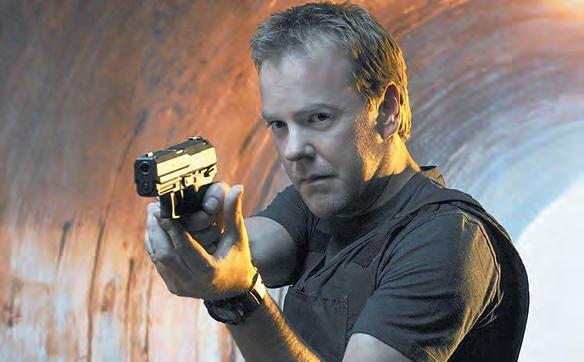

before the terrible events of Abu Ghraib…”
I met Sutherland the day Rishi Sunak announced the summer election, an hour or so before his infamous speech in the driving rain outside Downing Street. Sutherland comes from a political family, with both his father (the actor Donald Sutherland) and his mother (the actor and activist Shirley Douglas) active in left wing circles. What does he make of politics in the States right now?
“It’s absolutely ludicrous,” he sighs. “How long they’re allowed to campaign for, how long they’re allowed to donate and collect money for. And that there is no regulation. It’s alarming.”
I wonder if he’s tempted to throw his weight behind a candidate in the way so many of his Hollywood peers have?
“I can’t vote in the United States because I’m British, right? So I don’t think it’s
completely fair for me to start telling people what they should do if I can’t do it myself. Ironically, I can’t vote in Canada where I grew up, either, because I don’t live there.”
Our interview has overrun and his publicist rises to shoo me out of this strange room, back through the phone box and into the London rain. As I finish the remains of my whisky (which really is very good, smooth and complex and warm and, according to Sutherland, unlikely to leave me with a headache the next morning), I squeeze in a last question. As a man who was, for much of his career, associated with youth culture, how does it feel to be approaching his seventh decade?
I get scared of the day I can’t sing in the band, of the day I can’t play, of the day I’m too old to be insured to do a film. This isn’t the time to take it easy
I expect him to blow off the question, to tell me he doesn’t feel a day over 40, but he’s surprisingly introspective. “I get scared of the day I can’t sing in the band, of the day I can’t play. I enjoy it so much. I’m going to do it as much as I can. I worry about the day I’m too old to be insured to do a film. I’m lucky, I’ve been doing this most of my life but this isn’t the time to take it easy. For 40 years I’ve acquired a knowledge and capability to do something and now I’m at the peak of my creative capabilities, because of what I know. I’m speaking about film here. The music is exciting because there’s so much I don’t know. Every moment feels like a learning experience.”
As I leave I can hear Sutherland start to strum his guitar again. Decompressing before the next interview. Getting ready to go again.
l Red Bank Whisky is out now priced £47.95; for more information go to redbankwhisky.com
49
lll
lll
From left: Sutherland starring in Flatliners, which helped make him a cult hero; As the vampire David in Lost Boys, one of the enduring hits of the 1980s; In his iconic role as Jack Bauer in 24 Right: Sutherland playing an intimate gig to celebrate the launch of his Red Bank Whisky

I was taught being gay is an inherently shameful thing and it runs very, very, very deep. I think I’m doing okay but it’s an ongoing thing
50 INTERVIEW
‘QUEER SHOWS ARE CHANGING PEOPLE’S LIVES’
Kicking off a summer of Pride, Lost Boys and Fairies star
Fra Fee tells ADAM BLOODWORTH about his new landmark BBC show, a dream role for the man from Dungannon
Between Heartstopper, Love, Simon and Red, White & Royal Blue, there is finally a diverse range of LGBTQ entertainment on our screens. One topic in the spotlight this year is gay adoption, through the Luke Evans film Our Son and new BBC drama Lost Boys and Fairies, released for Pride Month, which follows the story of a gay male couple in their thirties trying to adopt.
Comic book fans will already be familiar with Fra Fee, who played Kazi Kazimierczak, one of the Marvel Cinematic Universe’s few gay characters, in Hawkeye. The role helped put the man from Dungannon, Northern Ireland, amongst the A-list. Fee also had the frightening task of following Eddie Redmayne in the role of Emcee in the Cabaret musical in London, one of the most prolific, critically acclaimed queer stories to have graced the London stage.
“At secondary school there were zero positive representations of queer life,” he says. “You were taught homosexuality was something that was not good. Lost Boys was such a happy experience, playing a part that resonated so much really moved me. With future roles I’m just pursuing that feeling.”
In Lost Boys, Fee plays Andy, who’s dating drag performer Gabriel (Sion Daniel Young). It’s joyous and sentimental, and at times tragic, combining elements of magical realism with a political message. Gabriel performs in drag in a labyrinthine queer venue, a high-ceilinged space more like a church than a gay bar. There is a severe lack of LGBTQ community spaces in the UK, even in our capital city. “We just kept wishing it was real,” says Fee. “I don’t think any of us have been to anything like it, whereas in the show everyone is welcomed into this celebratory, wonderful colourful space.”
He says the show’s themes and style “feels like an adult version of Heartstopper, in that it focuses on this really gorgeous relationship that is perfectly ordinary. It’s extraordinary in its ordinariness.” Heartstopper, about teenagers Nick and Charlie who fall for one another, has been credited as reframing the way we tell LGBTQ stories in the mainstream. It has been celebrated as vital representation for the community and has pulled in giant audiences for Netflix.
“I know young people feel confident to come out at school aged 12 or 13, and I suspect that’s partly because of what they’re seeing on their TVs,” says Fee. “These shows are genuinely changing people’s lives, which is mindblowing because it’s not something I’d ever imagined for myself at the time.”
Fee, who lives with his boyfriend Declan in an Oxfordshire village, remembers the culture of homophobia at school during Section 28 created issues he’s still working through as an adult. “You think you’re doing absolutely fine, but every now and then something catches you off guard in how you react to something,” he says. “You’ve been taught it’s an inherently shameful thing and it’s very, very, very deep. I think I’m doing okay but it’s an ongoing thing. It’s not as if society has completely changed to the stage where I can be completely free. That’s obviously not the case. Queer people are still being attacked, beaten up on buses.” It’s testament to his character that he’d “love” to go back to lead a workshop at his old school one day.
Fee was introduced to acting by his dad who performs amateur dramatics productions at home in Ireland. But it was at university in Manchester, while studying music, that Fee began to fall in love with musicals, which he viewed as a way of escaping into another life. “I’m a bit of a Sondheim freak,” he says. His dream stage role would be George from the Sondheim musical Sunday in the Park with George. An adaptation starring Jake Gylenhaal was heading for the West End in 2020 but was scuppered by the pandemic. Has he made his interest clear to casting agents? “To the universe!” he says through laughter. He has 25 theatre credits to his name already, in a career going back to 2009.
Since the MCU called he’s been blessed with more work than he can take on. “Saying no is an important part of the process,” he’s learned. He’s also holding Marvel to account over LGBTQ storylines: “I certainly think they could do a bit more work with the queer representation,” he says. It can’t all be agenda-setting work, though: as we part he’s getting ready to return to the calm of the countryside and his “amazing” boxer dog. “There are so many class pubs,” he says. “It’s pretty chill!”
l Lost Boys and Fairies is out now on BBC iPlayer
51
FROMANGLE EVERY
LONG BEFORE THE ICONIC, OCTAGONAL ROYAL OAK, AUDEMARS PIGUET WERE EXPERIMENTING IN 3D
It s tortuous name – ‘[RE] Master02 Selfwinding’ – could alone be paying tribute to the watch case’s equally dazzling jigsaw of asymmetric facets. Then again, the design of 1960 was originally dubbed ‘Model 5159BA’, so you can forgive Audemars
Piguet for a little poetic licence come 2024’s revival.
Model 5159BA’s run of just seven watches barely justified an initial capped letter, let alone a sub-brand of its own, like the ‘Royal Oak’ of 1972 –an early exercise in fashion iconography from the notoriously

buttoned-down Swiss watch industry. But [RE]Master02 follows on from ’01’ in 2020, which kickstarted contemporary reinterpretations of vintage AP obscurities with a 1943 chronograph reissue, powered by modern, future-proof mechanics. l £41,000, audemarspiguet.com
52

WHAT’S TICKING?
You can tell the time instantly, everywhere, from train departure boards to the screen you may be reading this upon, ultimately – paradoxically –rendering today’s humble wristwatch so much more than the sum of its parts. Status symbol, tradable commodity, saviour of ancient crafts, and futureproof analogue antidote to digital’s obsolescence.
POETRY IN MOTION
For the next few days South Kensington’s 4 Cromwell Place will open its doors to host ‘Poetry of Time’, an enchanting exhibition of animated mechanical watches crafted by Van Cleef & Arpels’ genevoise ateliers. Since 1906, fairies, flowers and flighty fabulousness have come to life in horological form, with all the whimsy you’d expect of Paris’ historic haute joailler non-pareil. What’s more, in keeping with VC&A’s impassioned mission to preserve and perpetuate its ‘métiers d’art’s’, weekending parents desperately seeking inspiration will be glad of a particular highlight: L’ÉCOLE, School of Jewelry Arts, which will
host a series of children’s workshops whose programme can be booked via the website.
l Tuesday to Saturday 11am-6pm, Sunday 11am-4pm, free of charge, vancleefarpels.com
WHEELS IN MOTION
As anyone who participated in last month’s Ford RideLondon 60-miler or 100-miler will know, endurance cycling isn’t for the faint of heart. Nor is it for the heart of a mechanical watch, whose shock-absorbing ‘collet’ must keep the delicate balance ticking steady, regardless of Epping Forest’s potholes. With typical pragmatism and value for money, however, RideLondon’s official timekeeper and sponsor of the historic Giro d’Italia, Tudor has seemingly come up with the ultimate horological peloton. Its new Pelagos FXD Chrono “Cycling Edition” has been specifically designed for two wheels, cased in carbon composite, integrating titanium elements to help make the watch necessarily robust. What’s more, its logarithmic ‘tachymetric’ stopwatch calibration is coiled around the dial, allowing average speeds to be read at a glance.
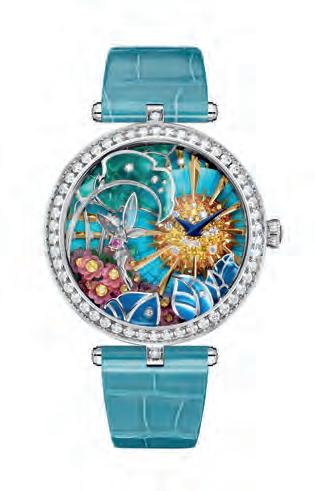
l £4,560, tudorwatch.com

CHRONO-LOCO
It’s a dream come true for chronograph geeks: Swiss flyboy Breitling has acquired full rights to its long-departed nemesis, Universal Genève. Universal evolved from a timid ladies’ and men’s dress watchmaker to become a key player in the post-war chronograph arms race. Both brands designed in parallel the now-standard, efficiently readable configuration of placing the pushbutton at the 2 o’clock position to unleash a central ‘sweep’ seconds timer, plus 30-minute and 12-hour ’sub-counters’. Since 1986, ‘Universal Genève’ is a name that’s appeared sporadically on watches from a Hong Kong outfit, Stelux. With Breitling’s acquisition, we await to see whether the new imprint is positioned higher (ca£8,000-plus) or lower (ca£4,000minus) than its chronograph offering. We suspect the latter... l breitling.com
53
Main image: The amazing Tudor Giro d’Italia, designed for serious cyclists; Inset: Van Cleef & Arpels shows off incredible jewellery arts in a new exhibition; Left: A Universal Tri-Compax ad from 1952
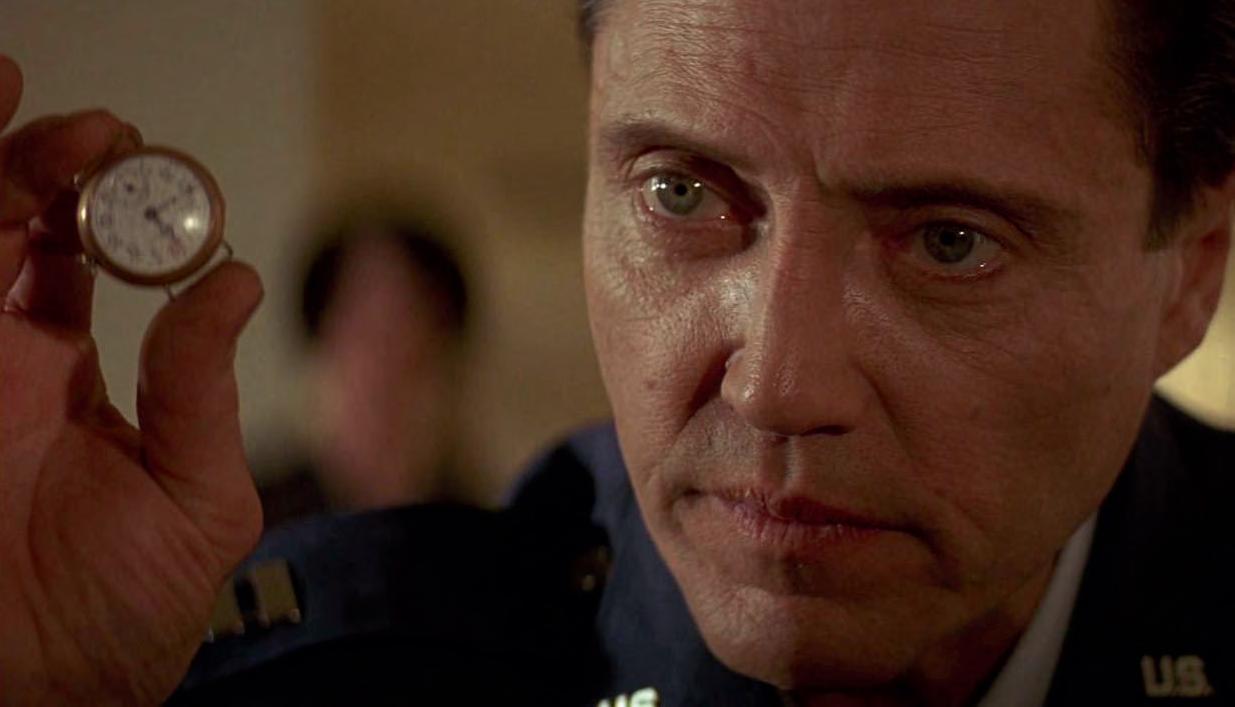
SCREEN TIME
It’s not all barefaced 007 product placement: ALEX
DOAK
charts the role of the wristwatch on the silver screen
No one can deny that the Rolex Submariner or Pierce Brosnan’s Omega Seamaster are perfect accompaniments to James Bond’s exploits. The former was literally taken from the wrist of Cubby Broccoli on the set of Dr. No, since Rolex themselves saw nothing in the burgeoning franchise. The latter was a clever decision by wardrobe grande dame Lily Hemming, on the basis of Brosnan’s blue eyes and the fact most Royal Naval commanders default to Omega’s diver when they earn their stripes.
But short of Sean Connery’s perfectly timed explosive salvo in Goldfinger, or the chassis of a runaway Soviet train being lasered in Goldeneye, these are
mere props. We need to look elsewhere to see clocks and watches being integrated into the very fabric of movies, befitting the horological nature of cinema with its split-second timing and intricate pacing.
This is perhaps best emphasised by Christian Marclay’s video-art masterpiece ‘The Clock’. Unveiled in 2010 and last exhibited at the Tate Modern in 2019, Marclay and his tireless recruits stitched minute-long clips from 1,440 different films and TV shows to chart every successive minute of a 24-hour day via a clock or watch dial featured somewhere in shot, or spoken.
It’s utterly hypnotic: should one of just five galleries that secured a DVD be showing it (always played in real time). The overwhelming impression is that of time’s hold on human behaviour and its
cinematic role in governing tension. Filmic clichés centre around certain time-stamps: early evenings in romcoms are filled with dates nervously checking watches or women running late because of a wardrobe crisis.
Heading up to midnight, everyone starts losing their minds. Take Ryan Gosling’s character in Drive (2011). True to the original book by James Sallis, adapted with abrasive flair by Danish director Nicholas Winding Refn, the character’s inherited Patek Philippe –strapped to the steering wheel of his Chevy Malibu – counts down his getaway with an off-kilter tick. Aside from the props department using flimsy fakes rather than a real Patek Calatrava, it brings palpable tension to every heist, while Gosling remains steely as ever.
54 WATCHES

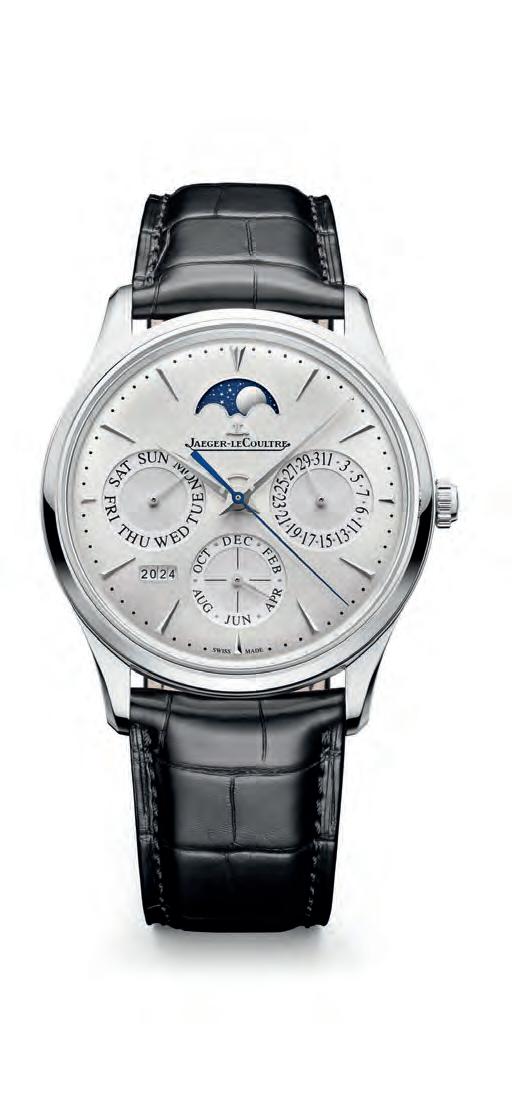
The power of a timepiece on the silver screen may be its ability to move things along by virtue of its perpetual ‘tick’, but there’s added significance to be found in a wristwatch’s sentimental nature.
Alfred Hitchcock popularised the term ‘MacGuffin’ as an object lending ‘drive’ to a story. Think the glowing suitcase in Pulp Fiction or, better yet, Bruce Willis’s beloved gold watch in the same film, bequeathed by Christopher Walken’s character Captain Koons.
The Jaeger-LeCoultre Master Ultra Thin Perpetual Calendar (£26,100) worn by Benedict Cumberbatch’s neurosurgeon in Doctor Strange (2016) may have conveniently chimed with the British actor’s ambassadorship for J-LC. However, it serves well as a cinematic talisman. Dr S’s hands are rendered useless by a reckless crash in his Lamborghini; having fixed himself, he treasures the watch in its broken state, with its inscription from an old flame: “Time will tell you how much I love you, Christine.”
[NB: the good doctor stores his watch collection in a horizontally oriented, motorised ‘winding’ drawer, despite every automatic mechanical watch relying on a vertical orientation, for gravity to nudge its winding rotor around. Some academic, eh?]
In the phenomenon that was Succession, Jesse Armstrong’s tale of hubris and birth right deployed the luxury watch as social commentary from the very first episode. Prospective
son-in-law – not to mention the most obsequious man in television – Tom Wambsgans presents patriarch Logan Roy with a Patek Philippe, joking that, “It’s incredibly accurate. Every time you look at it, it tells you exactly how rich you are.” Logan doesn’t even try the watch on. Instead, it is given to a Latino family as a bribe to keep quiet about his son Roman’s behaviour towards their little boy. The motif is picked up again in season three, when Kendall Roy convinces naïve cousin Greg to spend $40,000 on a steel Rolex Submariner, a significant over-valuation even in today’s waitlisted market of horological hype. It’s a hierarchy of humiliation that could only be wrenched by the 0.01 per cent.
Relaunched this year for its 45th birthday, Steve Martin’s character Neal Page wears a ‘grooved’ gold-cased Piaget Polo in Planes, Trains and Automobiles (1988) as another status-setter. The first shot of John Hughes’ bittersweet classic is a screen-filling close-up; an early tension builder given the film’s hapless arc, but with a typically elegant Hughesian pay-off – the Polo goes on to provide the global currency of “a hell of a nice watch,” paying for his night at a sleazy motel. All John Candy’s dishevelled shower-curtain salesman Del Griffith can muster is his digital Casio, resulting in those immortal words, come the next morning: “Those aren’t pillows!” There’s another watch-led dynamic between two equally mismatched
55
From left: Christopher Walken’s character Captain Koons explaining where this pocket watch had been hidden in Pulp Fiction; Daniel Craig and Eva Green in Casino Royale, a predictably watch-heavy movie; Inset below: The Jaeger-LeCoultre
Master Ultra Thin Perpetual Calendar (£26,100) worn by Benedict Cumberbatch’s neurosurgeon in Doctor Strange
characters in Breaking Bad (2012). TAG Heuer’s iconic, blue-dialled, square cased Monaco ‘chronograph’ is more famously associated with Steve McQueen, worn by his character in the woeful ‘Le Mans’ of 1971 (auctioning recently for a record $2.3m). The same watch formed an unexpectedly affecting totem in the brilliant Netflix series Breaking Bad after it is gifted from Jesse Pinkman (Aaron Paul) to Mr White (Bryan Cranston); as their relationship crumbles, White symbolically abandons the watch out in the middle of nowhere.
Later in Breaking Bad an episode closes with a close-up of the ticking timepiece on Walt’s bedside table: an ominous countdown to the horrors that will shortly unfold. A few episodes later, he calmly times the jailhouse massacre of 10 men within two minutes, with the Monaco’s appropriately crimson second hand setting off around an appropriately crystal-meth blue dial.
Two years later, Christopher Nolan’s futuristic blockbuster ‘Interstellar’ (2014) sees Matthew McConaughey’s character Cooper zooming-in – just as viscerally –
Jesse’s gifted watch to Mr White in Breaking Bad was a totem; as their relationship crumbles, White abandons it
on another ticking seconds hand. His former NASA pilot has rejoined the fray on a deep-space mission to secure the future of humanity. Cooper bestows his Hamilton watch to his daughter Murph before takeoff, which – in a typically cerebral pay-off from Nolan – forms a pan-dimensional connection with Murph’s grown-up self, played by Jessica Chastain.
From inside the ‘tesseract’ of the fifth dimension, Cooper sends a message using Morse code through the seconds hand of Murph’s watch. Despite a rich heritage supplying Hollywood’s propmasters with wristwear, Hamilton itself had no idea its ‘Khaki Field Murph’ would be so pivotal to Interstellar’s denouement. Needless to say, the Swiss watchmaker wasted no time releasing an exact reproduction for fans of the film, in a box created with production designer Nathan Crowley to reflect the fifth-dimension.
So there you have it: there are Omegas on Her [officially licensed] Majesty’s Secret Service and Hamilton heirlooms that serve the very functions of space and time. Something for everyone.

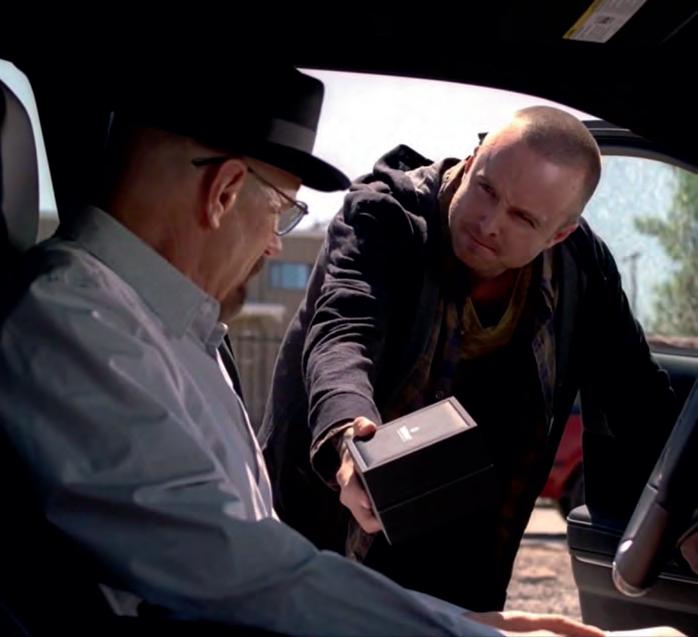
56 WATCHES
From top: Steve McQueen wearing a square cased Monaco ‘chronograph’ in the woeful ‘Le Mans’ of 1971; Jesse gifting the same watch to the nefarious Mr White in the Netflix hit Breaking Bad

WOMAN’S HOUR
LAURA MCCREDDIE-DOAK
LUNAR TICKS
One of the oldest complications around, the moonphase – a function that tracks the movement of the celestial bodies – is having a resurgence. Here’s why.
Get out your telescopes, and study your star charts because celestial complications are having a comeback. And we’re not just talking demure windows
taking centre stage.
Moonphases are nothing new: the origins of a function that tracks the passage of the lunar body from waxing gibbous to waning crescent, over the 29.5 days that make a lunar month, first arrived in 205 BC. It was part of an analogue computer that was found, in 1901, off the coast of the Greek island of Antikythera, after which it is named. The machine had 37 gears, allowing it to track the sun and moon as they moved through the heavens. It could also inform you when the next Olympics Games were, should you need to know. How this function went from 2nd century computer to wristwatch is harder to chart. There were astronomical clocks, found in cathedrals, made thousands of years after the Antikythera. However, they had the earth at the centre of the known universe, with the sun in orbit. You can imagine what happened to those in a post-Copernicus era…
Moonphases cropped up in 16th century German longcase clocks, but it was the English, in the 17th century, who adopted the “moonphase at six o’clock” approach. Unsurprisingly, given its reputation for firsts, it was Patek Philippe who, in 1925, originally put this function on a
wristwatch as part of its perpetual calendar furniture, joining the day, date, month and leap year indications.

Now these complications are coming to the fore. Last year, Christopher Ward unveiled its C1 Moonphase, which it dubbed “the most beautiful watch ever”. To be fair it wasn’t wrong: the dial is a glittering expanse of logo-less aventurine, while the top half of the dial is dominated by a glowing orb made luminous thanks to Globolight – a mix of SuperLuminova and ceramic that glows white, rather than the more common
This year Watches and Wonders was a constellation of celestial complications. Independent brand Trilobe created a customisable version of its Les Matineux, the L’Heure Exquise Secret. It maintains the three concentric dials on which the time is told, but on to that a celestial-scape can be mapped that commemorates how the sky looked on a particular day at a specific time and location. The stars shine when put under UV light, bringing that moment to life. Raymond Weil kept things a little more traditional with a grinning moon on its GPHG-winning Millesime, while Laurent Ferrier represented its lunar cycle as a double moon set against a backdrop of aventurine glass so you could see the phases in both hemispheres.
It’s not hard to see why these functions are popular. It’s the same thing that has driven a rise in the popularity of tarot: now more than ever, we need a little sprinkle of magic on the everyday. A reminder that, although we may be earthbound, we are all made of stardust.

58 WATCHES
Above: Denica Riadini-Flesch, who set up farm-to-closet clothing brand SukkhaCitta in her native Indonesia; Opposite: A SukkhaCitta clothing factory
THE FABRIC OF LIFE
Denica Riadini-Flesch, Rolex Laureate, wants you to think about where your clothes come from and who makes them, says LAURA MCCREDDIE-DOAK

Rolex is renowned for many things. Expertly made watches, notorious preowned prices, and, most recently, putting emojis on a watch historically worn by presidents. It is not quite so well-known for is its efforts to protect the planet through its Awards for Enterprise scheme and its Perpetual Planet initiative. Rolex has been giving bursaries under the Awards umbrella since 1976, when then-CEO André J Heiniger set them up to mark the 50th anniversary of the Rolex Oyster, the world’s first water-resistant watch.
According to Heiniger: “We initiated the Rolex Awards for Enterprise out of a conviction that we had a responsibility as a company to take an active interest in improving life on our planet and in the desire to foster values we cherish – quality, ingenuity, determination and, above all, a spirit of enterprise.”
Originally intended as a one off and to champion exploration for the sake of discovery, the Awards have now changed to support and promote long-term individuals and organisations who use science to understand and devise solutions to today’s environmental challenges. This change was further reinforced by Rolex’s Perpetual Planet initiative, set
up in 2019 as an expanding portfolio of eco-centric partnerships, such as the Under the Pole expeditions that push the boundaries of underwater exploration. There’s also the One Ocean Foundation and Menkab, both working to protect biodiversity in the Mediterranean, and the Xunaan-Ha expedition that focuses on the water quality in Yucatán, Mexico. In a world where watch brands are quietly abandoning talk of sustainability and seemingly ditching green targets, this feels refreshingly proactive.
Since 1976, 155 men and women have been selected as laureates. The Awards do not recognise past achievements – rather they are for new and ongoing projects. The only barrier to entry is age, with candidates required to be 18 or over. The judges comprise 10 experts in their respective fields, such as Dr Helen Czerski, British oceanographer, physicist and expert in the physics of oceanic bubbles or Tsitsi Masiyiwa, a philanthropist and social entrepreneur devoted to empowering young people in Africa with education opportunities and access to technology. Previous laureates are equally impressive – 2012’s Professor Mark Kendall is an Australian biomedical engineer who revolutionised vaccination with his low-cost Nanopatch, which removes the need for
59
needles. Vreni Haüsserman – 2016’s laureate – is a German-born Chilean marine biologist who has led expeditions to document the unique life and ecology of Southern Chilean Patagonia leading to the discovery of previously unknown sea life and ecosystems that thrive in the Patagonian fjords. Among 2023’s winners is former development economist Denica Riadini-Flesch, who set up farm-to-closet clothing brand SukkhaCitta in her native Indonesia to give a living wage to the women garment makers who work there.
Before she returned to Indonesia, Riadini-Flesch was working for a world bank in the Netherlands. She already felt guilty about leaving her home country, “knowing it’s not an opportunity most women in Indonesia have.” Riadin-Flesch returned home with a mission. She knew that Indonesia is one of the largest clothing manufacturers in the world but fewer than two percent of its textile and garment makers, most of whom are women, are paid the living wage.
“I travelled through the countryside witnessing these beautiful fabrics being made by women who were working 10-hour days, then going to bed at night worrying about how they could afford school fees,” she says. “Behind what we wear are these women we will never meet and I wanted to change that.” To do that Riadini-Flesch cut out the middleman: SukkhaCitta’s clothes are sold direct or through a handful of shops, allowing her to pay a living wage.
She also championed education. “In developing countries artisans, such as these women, earn less than $2 a day because the economic model is broken and we don’t value these people,” she says. “To break the cycle, you need education.” Since SukkhaCitta was set up in 2016, the women who work for the brand have seen a 60 per cent increase in their wages, the network of artisans is now spread over 13 villages and RiadiniFlesch has set up four craft schools in Indonesia, with a fifth on the way. Called Rumah SukkhaCitta (House of Happiness), they are Indonesia’s first textile craft schools, where women are

trained in how to earn a living wage from their craft and how to set up and run their own businesses.
In developing countries, artisans like these women earn less than $2 a day because the economic model is broken
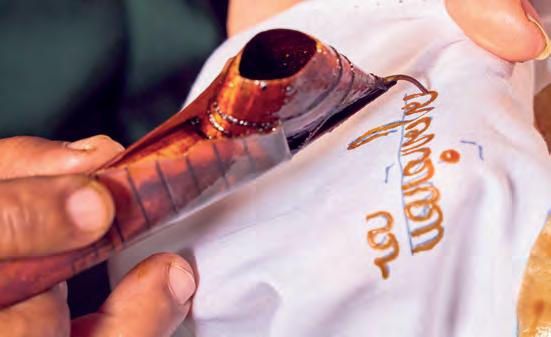
However, it wasn’t just the issue of money Riadini-Flesch wanted to address but the environment impact of the garment business as well. Cotton is one of the dirtiest fabrics in the world due to the number of herbicide used on the crops. Riadini-Flesch’s solution to this problem came in the form of Ibu Kasmini, a 65-year farmer who used to grow cotton the traditional way, but turned to corn because it was more lucrative. RiadiniFlesch asked Kasmini to turn her land over to cotton again, using the traditional methods that eschew a monoculture approach in favour of using other plants to act as deterrents or nutrients for the cotton. The clothes are also dyed using natural dyes, preventing three million litres of toxic dyes from entering Indonesia’s waters.
“Mass production is systemically disconnecting us from how our clothes are made,” she says. “It’s not that we want to exploit people, it’s that we simply don’t know.” It’s not just the money from the Rolex Award that will make a difference, either: it also amplifies her story. “It’s so special because these women have been invisible for far too long and now their story is being heard, she says. “It’s being celebrated all around the world and that’s why the Rolex Award is such a special thing for me.”
60 WATCHES
Above and left: Artisan fabric makers are getting paid a fair wage thanks to SukkhaCitta, a company supported by the Rolex Award

Discover more at
do.
No one does beauty like we

The tap that does it all.

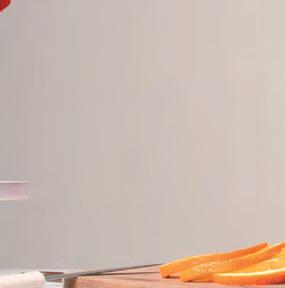













How Sustainable is a Quooker?
With a Quooker in your kitchen you always have instant 100ºC boiling water on demand. Add a CUBE and enjoy filtered chilled and sparkling too.
DID YOU KNOW the average London adult buys more than 3 plastic water bottles every week - that’s a startling 175 bottles every year! In total, some 7.7 billion plastic bottles are bought across the UK each year resulting in substantial amounts of single-use plastic waste - with over 40% ending up in a landfill.
With a Quooker and CUBE you can say goodbye to plastic bottled water forever.
To book your own virtual appointment, scan the QR code or visit quooker.co.uk Book now to guarantee your place and get access to our special Summer offers


62
WELLNESS PEACHY? FEELING
Check out this line of cocktailthemed ‘personal lubricants’ to inspire your night-time adventures

Who could forget the peach scene from Call Me By Your Name?
Timothée Chalamet’s incredibly on-the-nose sexual awakening involved the actor getting down and dirty with a piece of stone fruit – and now you can
recreate the scene at home without having to make a trip to the fruit aisle of the grocery store.
Sexual wellness brand Nauox has a range of genderless “personal lubricants” inspired by botanicalinfused cocktails. These include the Sweet Haven (pictured) flavoured with peach, kiwi, cherry, raspberry, clove and hibiscus, which promises to be “a fruity
and invigorating experience”. Also available are Agave Nectar (guava, exotic dragon fruit, lychee, agave, cardamom and white tea), Yin-Yang (jasmine, cherry blossom, ylang ylang and sweet oolong tea), Dulce Dreams (caramel, vanilla, cocoa and white chocolate) and Holy Honey (blueberries, oats, honey, maple, and bananas).
l From £20 plus shipping, nauox.com
SECTION HERE 63
63
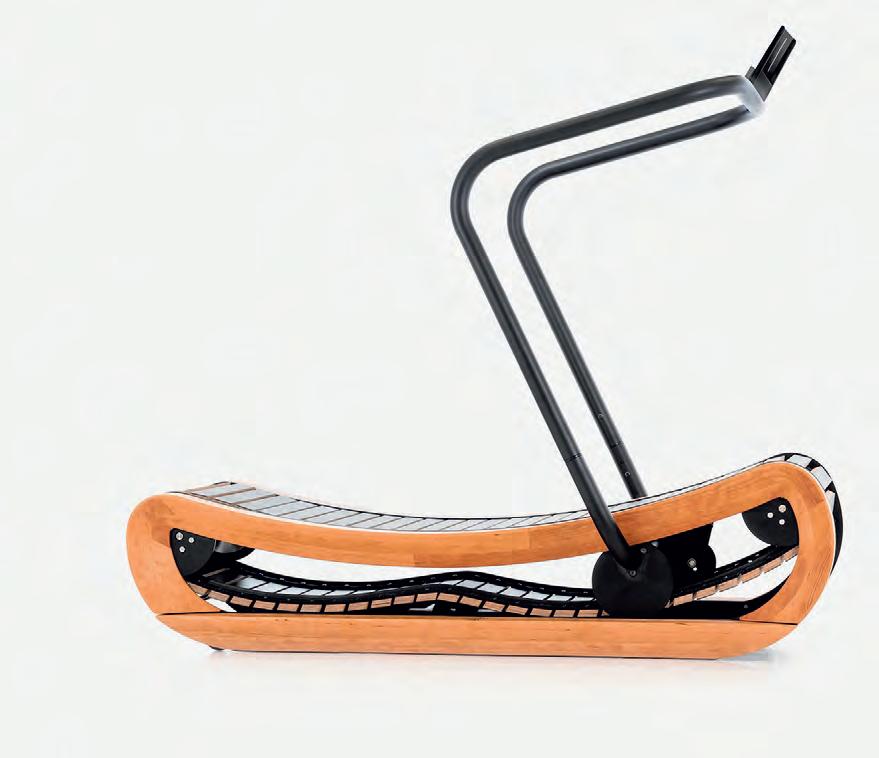
NHORD SPRINTBOK TREADMILL, FROM £5,849, OHRD.COM
Peloton may have established itself as the go-to producer of ultra high-end fitness tech but there are other brands for the more discerning fitness enthusiast. The Nhord Sprintbok is an absurdly beautiful piece of equipment, with its pleasing curves and hardwood finish. It’s motorless and requires no maintenance, and the 17.2-inch touchscreen features virtual runs that vary from Sydney Harbour to the Italian Dolomites.

MYPROTEIN PLANT PROTEIN SUPERBLEND, FROM £7.49, MYPROTEIN.COM
Made from upcycled barley leftover by beer brewers, Plant Protein Superblend turns grains that would otherwise have gone unused into high-quality protein. Each serving is packed with 20g of protein, helping to support muscle growth and maintenance of muscle mass.
64 WELLNESS

MYVITAMINS
GUMMIES
FROM £9.99, MYVITAMINS.COM
Gummies have become a major part of the wellness landscape, providing a tasty, convenient way to top up on essential nutrients. Myvitamins offers a wide range catering to every need. Sea Moss Gummies (£16.79) contain a nutrient-rich type of seaweed with added vitamin C, vitamin D, and iodine. Tumeric & Ginger Gummies (£10.79) come in a fiery peach flavour and are packed with 297mg of turmeric and 45mg of ginger, while Omega 3 6 9 Gummies contain unsaturated fatty acids that help keep you healthy in a balanced diet.
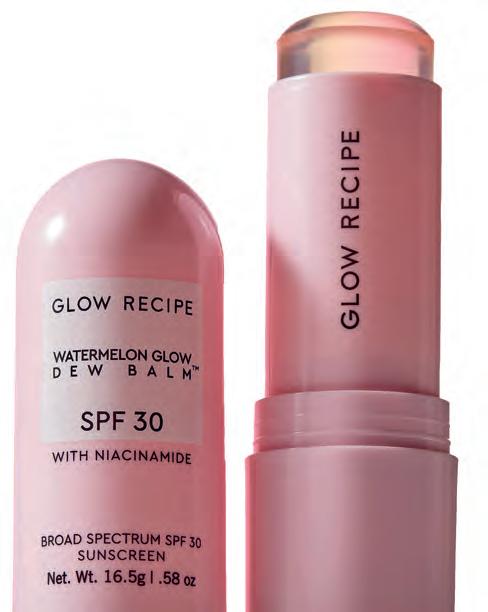
GLOW RECIPE WATERMELON GLOW
SPF 30, £27, CULTBEAUTY.CO.UK
The weather has arrived and that means you need to remember sun protection. This Dew Balm stick makes topping up a cinch.

CMF BY NOTHING
£69, NOTHING.TECH
Nothing is carving out a name for itself as a cool, affordable alternative to the tech giants. This fitness tracker has GPS and lasts up to 13 days.
65

Atextbook Bangkok afternoon: the sun is doing its darndest to incinerate anyone who dares go outside, but luckily I’m indoors, laying in a bath with a towel covering my modesty. Chernkwan, a local, is covering my chest with water, leaning in and checking she’s
splashed every part of me like a doting parent taking care of their newborn cherub. It’s slightly awkward, but I’m committed. She’s swishing around cloth bags in the bathwater filled with local medicinal herbs and foraged plants. She’s a master timekeeper: every ten minutes Chernkwan points to the steam room where I intermittently sweat between long, unnerving bathes.
Rakxa – where rooms cost £3,718 for five nights – is the poshest wellness retreat in Thailand. Within the Phra Pradaeng District, the ‘green lung’ of Bangkok, a natural expanse on the south-eastern outskirts of the capital, there are panoramic views of the hedonistic city 20 kilometres to the north, but silent Rakxa taunts the stressed-out workers with its pindrop-calm.
66 WELLNESS

INSIDE THAILAND’S SWANKIEST WELLNESS RETREAT
Thailand was the first Far Eastern Mecca for wellness, but Rakxa is bringing a modern touch, finds ADAM BLOODWORTH
Chernkwan grew up on the other side of the mud-brown Chao Phraya River separating Rakxa from the bright lights. Her mother taught her traditional Thai medicine when she was in single digits and now she harvests vegetables from on-site gardens to perform these rituals, helping stressed out Westerners decompress. Ever since backpackers forged the trail in the 1960s, Thailand’s reputation as the Far
Eastern wellness destination has become so entrenched that it’s a cliche. Baz Luhrmann’s film The Beach bolstered the ‘find yourself’ narrative for the early 2000s, and the explosion of gap year culture and the mainstreamisation of the once remote place means spiritual pilgrimages can these days involve getting robbed on a touristy beach.
McDonald’s is the first sight you see as
you arrive by boat to the party island of Koh Phi Phi, the location of Luhrmann’s film. Still, the lure of Thailand needs no explanation. Even in the popular parts, if one beach is a tourist hellscape you tend to walk round the corner and find the next one absolutely deserted.
I had wanted to see what the God tier of Thai wellness looked like, so I checked into the Rakxa Thai-run wellness facility as an
67
embarrassingly predictable patient. I was jet-lagged and had a cold, probably because I’d been burning the candle at a local music festival in the hours before I arrived. (You might like the idea of going to the Far East to relax, but the reality is wanting to squeeze as much out of a longhaul trip as you can.)
Rakxa is part of a trendy new cohort of ‘integrative wellness’ retreats using traditional and modern techniques to get you fighting fit. The idea of integrative wellness began in the Western world with destinations like Clinique La Prairie, the Swiss clinic that opened in 1931, and these days the industry’s business-end is bio-hacking, with clinics including Mayfair’s Hooke attempting to keep you alive for longer at an eye-watering cost.
Cough up almost £4,000 and state-of-theart tech will assess your balance, suspension exercises examine your neuromuscular activation, hyperbaric chambers measure your breathing.
Acupuncture, massage, breathwork and tai chi are the counterbalances, suggesting you needn’t have been born in the modern age to be fighting fit. But really it’s about being in Thailand, isn’t it?
At Rakxa, most guests enter the resort and don’t leave for anything from five to twelve days. A pristinely manicured expanse of private villas and treatment centres are designed in traditional Thai styles. Winding paths take you through trees, past swimming pools, and along boardwalks. It might not be that big but it feels like its own little state. It’s a recognisably swanky Far Eastern resort, only there’s the word ‘hospital’ above one building. And there’s no booze.
I’m given a push bike as the main method of transport. Bikes are instantly nostalgic: they remind me of being a kid, of transporting myself to the den I made in the forest at the end of my road in the halcyon days when that was the most important journey I’d make. It’s all part of the shtick.
Careering around the site on two wheels, you get a smug sense of self importance as the staff bow to you and smile broadly. “Sawadi-ka!” The Rakxa staff pull you into their way of living. Have I ever smiled this much at anyone? It’s true what they say about working out your mouth muscles: it does wonders.
My apartment looked like a CGI mock-up someone would create but never actually make. It had floor-to-ceiling windows, great feng shui with massive sofas and a dining table in the living room (which in itself was as big as my London flat), a bathtub big enough for a walrus to luxuriate in and sliding doors out onto my private lawn and swimming pool. Behind that was the monitor lizard-laden lake with loungersfrom which to watch the amphibious fellas shimmying across the surface.
It’s a hard life. But I had busy days of meetings and, like a good school boy, I cycled to them. The first morning I had the


best massage of my life, which involved an incredibly tender caressing of the scalp that sent me to sleep, followed by tai chi on a boardwalk overlooking the water. Sometimes I struggled to concentrate on the activities (it’s hard to fire your brain up when you’ve just spent four hours around an infinity pool) but the lure of the skyline brings you back to a state of focus, a constant reminder of the purposeful silence and stillness at Rakxa, how it contrasts with ordinary life.
Later I sat in a Joey Tribbiani lounger with an IV drip in my arm feeling like I was having a very expensive breakdown. Many people here probably are. On the water, the monitor lizards poke their little heads above the water. It takes a few minutes to see one haul itself from one side of the lake to the other as a load of complicated things to do with immunity poured into my arm. On the first few evenings, Bangkok was tempting. Khao San Road! Night markets! Booze! Dinner is typically over by around
68 WELLNESS


eight, with the restaurant closing at nine. But by day four you have the sense that the whole world has become Rakxa and that nothing else worthwhile exists. All that matters is the morning pilgrimage to breakfast, the earnest greeting I have with each of my practitioners, my daily meetings (I must attend them all! I didn’t. I missed one, inevitably) and the cycle back home to see the sunset.
One thing you certainly won’t see is an abundance of other guests. Rakxa makes
sure there are never too many people on site at once. During my five-day trip I became well acquainted with a lovely retirement-age lady from the States who said she’d arrived struggling to walk and now was back on two feet. The way she explained the story made me believe her: it wasn’t all woo-woo, she’d really found solutions here. We spoke about finding joy. “I’m trying to fit some of that back in,” she said. Most guests were in their sixties and seventies and working on a
There was one poisonously judgemental lady from LA but I avoided her like one of the monitor lizards dodging a pushbike
sort of reverse hedonism. There was one poisonously judgemental lady from LA but I just went in the other direction when she came near me, like one of the lizards dodging a pushbike.
Some crazy things started happening. I started to feel relaxed. One morning, this lifelong night owl felt excited to get up and watch the sun rise. I learned about the sense of control that comes with rising early as I rode my bicycle to my treatment centre and enjoyed the synchronicity of three or four employees lining up at an entrance to welcome me.
Mealtimes, sometimes with my new friend, were incredible technological feats. There’s no scrimping on portions, which are hearty: the idea is you’re full enough you don’t need to snack (I did ask for double portions of in-room cookies. One thing at a time). Each night the three-courses offered a new perspective on Far Eastern cuisine. Local seafood, colourful papaya salads, properly tart kombucha served in cocktail glasses with little decorative flowers. It all tricks your mind into thinking you’re having something hedonistic, and makes you realise how needless the poison of alcohol really is.
There could be activities in the evening, I thought, as it’s dark by seven in Thailand. But maybe I’m programmed to be afraid of doing nothing at all, facing the reality that is actually winding down. But by night two I was already thankful for the glorious stretch of nothing that had become my nights.
There are other things to do first in Thailand: the retreats of Koh Phangyang will be less engineered luxury and you’ll meet more people, but Rakxa really is something else. There’s a potency to the pristineness, the landscape and hospitality that feels like it shouldn’t be allowed. It’s almost too many good things all in one place. This is Thai wellness, a concoction spurred on by some of the nicest people in the world and totally unlike anything else. I am in my own little Truman Show, and that’s rather lovely. Just one more lap around the place on my bike before I go: it might not be real but it feels great.
l Adam experienced the five night Rebalance programme, from £3,718; rakxawellness.com
69
Clockwise from top: One of the wellness clinics at Rakxa; A woman receives a consultation from one of the on-site doctors; The stunning infinity pool, from which you can watch monitor lizards race through the jungle


TRAVEL

LAS VEGAS VIVA
Spend a night in 1950s casino kingpin Jackie Gaughan’s perfectly preserved apartment in Downtown Las Vegas
You can easily pay $1,500 for a bog-standard, soulless bedroom on the Strip, but go to Downtown Las Vegas’ Freemont Street for the city’s best stay.
The El Cortez hotel is the last remaining 1940s-era motel-style accommodation in the city, and the last standing joint that was frequented by the mobsters that set up Vegas. It is also the last place that retains the old school attitude to
hospitality: current owner Kenny Epstein, in his 80s, wanders through the foyer introducing himself to guests.
On the top floor is the Jackie Gaughan Suite, a sprawling 2,700 square foot apartment that costs just £1,180 a night. It sleeps six easily, so go with a group of mates and absolutely lord it up.
Casino kingpin Jackie Gaughan died in 2014 and ten years on from his death, the suite still retains its original fixtures and fittings from the early 1980s, when he decked the place out as his personal
home. These include a hulking refrigerator that mobsters could easily have stored multiple enemies inside, and Gaughan’s personal cups and mugs at his in-room bar. Wait until you see the pink jet bath with Strip views and a metal duck-neck tap: it’s next-level high camp. You feel you’re snooping through someone’s cupboards, because you are. Raise a glass to Gaughan from one of the six balconies. It’s what he would want. l elcortezhotelcasino.com; email jbernard@elcortez.net to book the suite
SECTION HERE 71
YACHT CLUB
Make new friends on a boat so handsome you imagine she’ll sail up into the air, says ADAM BLOODWORTH
Akilometre off the coast of Cassis, I’m doing backstroke. In my peripheral vision I catch a black speed boat reverse each time I move my arms. In a crisply ironed shirt, the crewmember adapts the vessel’s position to match my strokes. I test the formula: I swim forwards a bit, and the speed boat lines up with me again, always remaining exactly 20 metres away.
Framing the French Riviera on the skyline is Le Ponant, the boat I’m staying on, where men (more ironed shirts) stand waiting for me with towels rolled into neat logs. But I’m not getting out yet. I’m swimming in a busy water passage so the speedboat is to protect me. Having your own water security team feels very Tom Cruise but this is life on a private yacht. Only Le Ponant isn’t a private yacht, it’s a public ship masquerading as a billionaire’s plaything.
With 16 bookable rooms hosting 32 guests, and an almost even guest-to-staff ratio, it’s unique. It feels like a yacht even if boat nerds insist it’s too big to qualify (there’s actually no standard definition, so I’m right and they’re wrong).
Onboard, I’m handed a sparkling French apple cider in a champagne flute to take the edge off when I finally get out of the freezing cold water. (Okay, maybe freezing is dramatic, but the Med in spring still makes your heart race.) I’m
not the only pleb who wants a slice of the billionaire lifestyle: within the luxury sphere, tenders have been shrinking the number of cabins on small and midsize ships. The relaunch of Crystal Serenity under Abercrombie & Kent saw the vessel go from 1,200 to 700 passengers as demand grows for more personalised cruises.
At the business end of that trend is the yacht industry, which was worth $8.91bn in 2022 and is forecast to keep growing until at least 2030.
It’s understandable: they shaped our modern idea of glamour. Yachtbound photos of Elizabeth Taylor and Richard Burton in the 1950s established a new era of paparazzi photography, and David Beckham, Kylie Jenner and Leonardo DiCaprio still use them today. In an age where it’s hard for the rich and famous to visit restaurants on dry land without getting papped, the yacht is a haven of discretion. Even Jeremy Clarkson is prone to baring all at sea when he’s done playing farmer in the Cotswolds.
Short of having Clarkson’s cash, private yachts of this quality are prohibitively pricey. Charting one in the Mediterranean will cost £30,000 for entry level boats in low season, and that wouldn’t include docking or taxes, and sometimes not food. Double that and you’d still end up with something far less romantic to look at than Le Ponant. Plus, even if you have the cash, you don’t necessarily want the faff of amassing fourteen friends and

72 TRAVEL
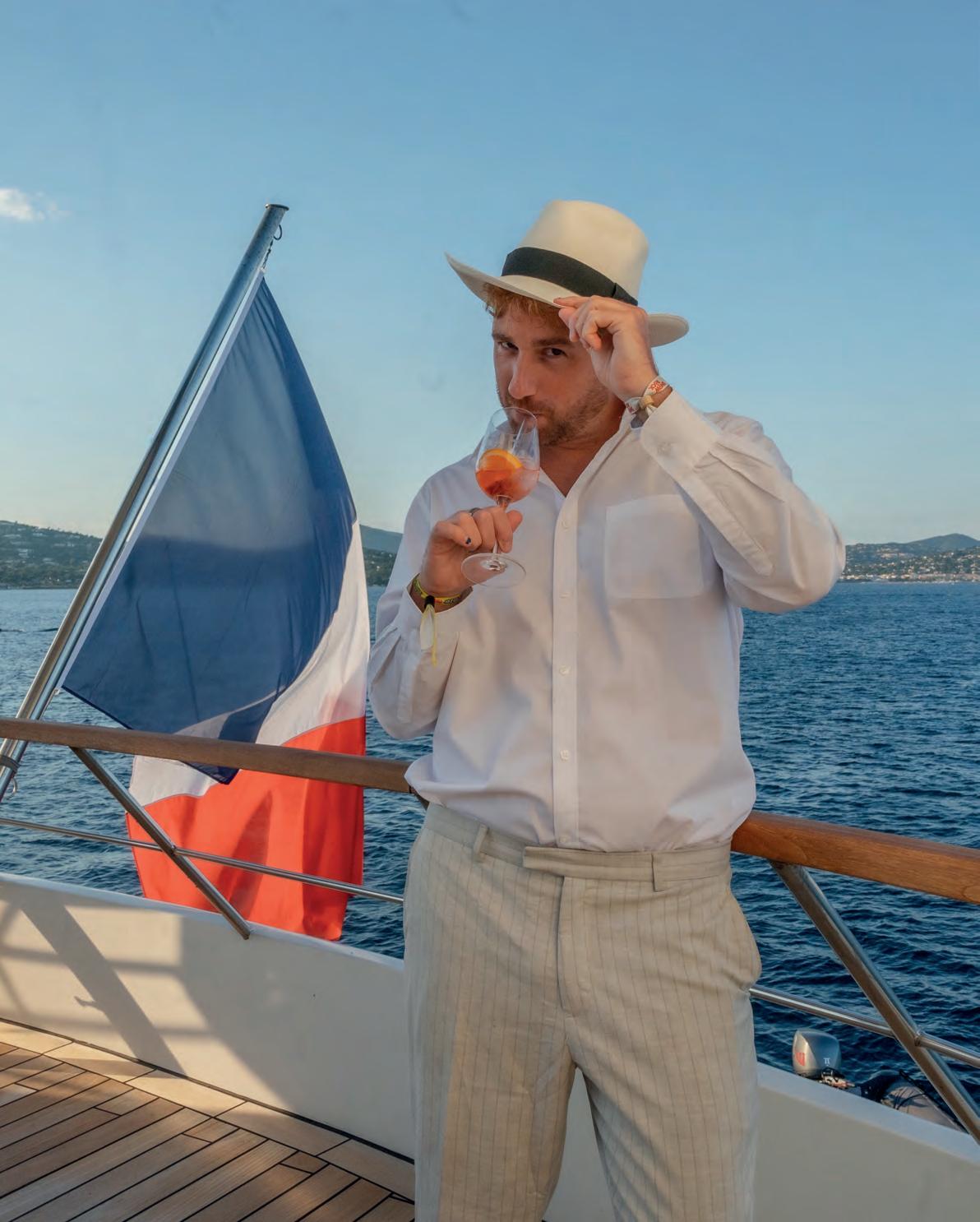
73
Adam sips a Campari spritz aboard the yacht as it sailed around Saint-Tropez, dressed in typical oceanic attire. Portrait by Jack Degg

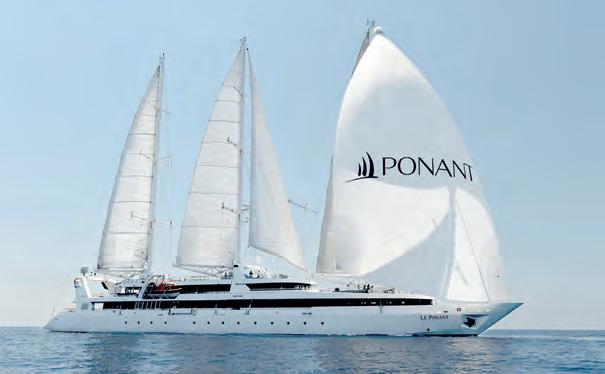

guaranteeing they each have the hedge fund-level wealth to cough up for their share of the private charter.
Le Ponant is the image of a sailboat you had in your mind as a child, the sort of impossibly beautiful ship that would have tickled JM Barrie’s imagination; you imagine she could take off into the skies at any moment. She retains her original teak decking from the build in 1989, with three soul-stirring sails on the top deck, best for doing your Liz Taylor impression from while spread eagle on a sunbed. Later it’s pre-dinner drinks accompanied by funky jazz bands (singers blasting sentimental ballads are old hat, one Ponant staffer tells me). Cocktails taste great on top of Le Ponant. One shameful morning I saw the bartender carting a new crate of Campari up the stairs after I’d gone gung-ho on the spritzes the evening before.
But there’s another allure to spending a week at sea with 31 randos: the opportunity to make new friends. Cruises can be chaotic but 32 guests might be the perfect number: any less would be rather intense, like a dinner party you can’t escape from, and any more you’d forget who they all were, awkwardly staring at the floor instead of saying hello, endlessly meaning to make new connections but failing because social
boundaries hemmed you in.
There was the Australian who emigrated to southern France and is living out her mother’s dream Mediterranean lifestyle, the lady who writes for Tatler (darling!) and the Belgian man who came alone and took a shine to a single, rather fabulous London-based mother who’d come with her daughter. What fun!
Day trips – a chance to take the speedboat to shore – took us to SaintTropez (again, darling!), Cassis and Nice. In Saint-Tropez, LVMH is ruining things by buying all the shops and killing the bohemian spirit, but it’s such a small place that normal-folk and yacht owners
mingle on the same promenade. It feels weirdly democratic; there aren’t enough restaurants for there to be ‘cool’ ones and touristy ones, just the handful on the waterfront where everyone goes. Have an eight euro croque monsieur at Le Gorille; opened in 1952, it is the final place on the waterfront that retains the zephyr of Saint-Tropez in its artistic, alternative heyday. Trips offer opportunities to escape the on-board company if you needed to, but I was keen to get back, if only to pretend it was my regular daily commune to be whisked away on a speed boat from land to my bed.
Cruises can be chaotic but 32 guests is the perfect number. Any less would be like a dinner party you can’t escape from
On the last night we were dancing to Daft Punk in the lounge (this is where the bigger boat helps: decent indoor communal areas, more like a typical cruise ship). After hoovering up as many cocktails as there were guests, I sat cross-legged with my shoes off, getting the goss on why the Belgian man hadn’t made his move. It was that type of ‘new friend’ conversation where there is always more to say.
l Le Ponant sails from Dubrovnik to Dubrovnik from August to October 2024, and from Athens to Athens from June to July. Seven night sailings cost £8,280 per person based on double occupancy. To book go to uk.ponant.com/le-ponant. For airport chauffeur services from Blacklane go to blacklane.com
74 TRAVEL
Clockwise from above: The original teak flooring on the top deck of Le Ponant is a rare find on publicly bookable ships; The majestic boat complete with its original 1989 sails; The luxurious lounge space where you can chat to your fellow guests, remodelled extensively in 2022
Human nature needs nature
Book an off-grid cabin today



76 TRAVEL
The diving at Sharm can’t help but impress even the most jaded of resort haters
I HATE RESORTS: CAN SHARM CHANGE MY MIND?
Dedicated adventure girl OLIVIA PALAMOUNTAIN is a devout hater of resort holidays. We packed her off for a stay in Sharm El Sheikh, where there is little else
Call me contrary, but holidays that have been calculated to make life easier grind my gears. I’m the kind of person who enjoys the chaos of travel. I want the freedom to roam, the chance encounter, the dodgy decision – after all, adversity on the road brings the laughs back home. Unsurprisingly, I would never, ever book a resort holiday. The Stepford Wives of the hospitality world, these controlled, manicured all-inclusive temples to indulgence are experts in what I don’t want. From the groaning buffet spreads full of things that will never get eaten (nobody needs a chocolate fountain at breakfast) to the lazy buggy drives and the monotony of spontaneity-free days in ‘paradise’, even the tropical ones leave me chilly.
It doesn’t help that resort life is all about ‘getting away from it all’ and I’m rubbish at relaxing. As my serene Greek housemate says: “You’re always doing something.” Please, someone, show me how to lose myself at a resort where it’s impossible to get lost. Don’t get me wrong, I’ve tried. Travel writers are often beggars rather than choosers when it comes to their assignments, and while I’ve found myself at all-inclusives the world over, I have rarely come to a more generous conclusion.
The Four Seasons Sharm El Sheikh opened in the sprawling, purpose-built tourism destination on the utmost point of Egypt’s South Sinai peninsula some 20 years ago and remains the undisputed Sheikh of Sharm. Bathed in glorious, year-round sunshine, home to world-class watersports and just a nippy 10-minute transfer from the airport, my editor asked me to tackle my biggest fear: the resort holiday. I was ready. Set in a maze of meandering pathways clad in perfumed bushels of bougainvillaea, the Four Seasons really is an oasis in the desert. Yes, there are buggies, but I brave the heat to wander this “Arabian village” on foot, discovering cascading fountains and clandestine meeting spots that frame flashes of the blue beyond. Nods to Moorish design continue inside the opulent villas, complete with all the ultra-comfortable hallmarks of the Four Seasons. I crack open a beer on my terrace and drink in dreamy views of the Red Sea as the sun wanes.
The real beauty of Sharm, however, is what lies beneath. A Mecca for underwater adventures, dive master and all-round cool dude Amr guides me around the spectacular reef, alive with vibrant corals, kaleidoscopic fish and even the odd benign shark. From the Maldives to Mexico, the Caribbean, Indonesia and Australia, Sharm blows every other reef I’ve explored
clean out of the water – and, with its new dive centre, training pool and classroom, the Four Seasons would make a fantastic place to earn your PADI.
Hungry? I don’t find it easy to get excited about dining on the same property every night but with 14 restaurants, I guess there’s plenty of choice. Plus, there’s no baulking at an outrageous bill from a hipster joint slinging ‘small plates’. Still, I can’t help missing the beat of a local backstreet bistro: old habits die hard and a familiar sense of fomo starts to creep in. Fortunately, the free-flowing booze is banging. I recommend skipping the rip-off premium selection (these cost extra) and exploring the Egyptian-made options: the quaffable Château de Granville house tipple is an elegant semillon that slips down night after night.
To offset the extravagant consumption there are fitness facilities galore, including tennis courts, a subterranean squash court and a fabulous gym. At home, workouts have to be shoehorned between work, meetings, events and hangovers. With zero distractions, I’m in the gym twice a day, because that’s how hyper, intense people like me unwind. And it starts to work. I ease up on frantic comms, exchange doom-scrolling for a book and watch as the sad skin around my bitten nails starts to heal.
With gym-beach-eat-repeat established, divine days melt into Arabian nights and I can’t be bothered to venture into Sharm – but Four Seasons has a chauffeured limo so my arm is twisted. The Old Market was built in 1986, which makes it younger than I am but hopefully I’m not nearly as tired, dusty or boring. It does, however, have a much better bag collection, courtesy of the endless boutiques selling counterfeit designer garb, as well as the magnificent El Sahaba mosque, which looks a little forlorn surrounded by so much tat.
As much as my independent spirit rebels against the package holiday, five days of cocooned at a resort with all the bells and whistles has been a balm for my frazzled body and mind. Despite the limitations of a manufactured environment, I found my own groove here, which I guess is what it’s all about. For the record, I still think resorts are weird. I travel to feel, not to forget, and resorts are carefully constructed illusions designed to keep the messy realities of the world at bay. But at least Four Seasons Sharm helped me to understand the point of resorts, even if I will go back to my stressful holidays of navigating my own travel and getting my timings wrong.
l Rates at the Four Seasons Sharm El Sheikh start from $330 per night ($425 including tax)
77

FREQUENT FLYER
JENNY SOUTHAN
WE MEAN BUSINESS
What’s new in the world of business class air travel?
And what’s on your wishlist for the next wave of upgrades?
Once you have flown in business”, they say, “there is no going back”. By “business” we are of course talking about long-haul seats that convert into fully flat beds. The good news is that, after several years of relatively little innovation, 2024 is gearing up to be a stellar year for premium flyers. It will see the introduction of a huge array of elaborate new experiences, with features ranging from 4K screens and wireless charging to seats with built-in cooling and heating systems (this last distinction can be found on the new Lufthansa ‘Allegris’ offering, which debuted last month on an A350-900 from Munich to Vancouver).
This year, Air New Zealand will unveil eight new Business Premier Luxe suites at the front of its B787 aircraft. These will come with sliding partitions and a companion seat so two passengers can have a meal together. Announced two years ago, American Airlines’s new B787-9 Flagship Suite is a business class product so good the carrier is getting rid of first class altogether. When you settle into these self-contained pods, which come with their own privacy doors, marble-effect work surfaces and Nest Bedding mattresses, you can see why.
So what else is new? If you’re flying on a next-gen Cathay Pacific, look out for its Aria Suite, described as a
“private hideaway” aboard its new B777-300ERs. Here you will find wireless charging stations, 24-inch 4K widescreen TVs, Bluetooth audio, privacy doors and curated artworks. Meanwhile, Japan Airlines has unveiled what look like business class office cubicles, complete with burgundy armchairs with a ‘Euphony’ headphone-free sound system built into the headrest.
Over in the Middle East, low-cost airline Flydubai is introducing a cutting-edge, ten-seat business class cabin on its new Boeing 737MAX aircraft, which makes it look more like a private jet with stylish sleeping berths. At the other end of the scale, Qatar Airways says it is working on version 2.0 of its lavish Qsuite, which famously has central pairs of seats that can be joined together to create a double bed.
What about our flag carrier British Airways? The airline’s Club Suite first arrived in March 2019 but is still to be rolled out across its long-haul planes (including the superjumbo A380s). This won’t happen until 2026, by which point, with the amount of competition in the skies, it will probably already look dated. However, with news BA is also installing a new First Class seat on the A380, there will be the added temptation to upgrade. On my wishlist is a shower, and perhaps an Apple Vision Pro. l Jenny Southan is the founder of travel trend forecasting agency Globetrender

78 TRAVEL

THEATRE AND FIZZ AT THE BARBICAN
Enjoy the sizzling KISS ME, KATE at the Barbican Theatre with a complimentary glass of champagne
To be or not to be...in love. That’s the question in this star-studded new production of Cole Porter’s legendary musical comedy, Kiss Me Kate. Fall “so in love” with your leading couple: multi-award-winner Adrian Dunbar (Line of Duty, Ridley) and Tony Award-winning Broadway Royalty Stephanie J. Block (Into The Woods) in her West End debut. This dynamite duo head the summer’s hottest cast alongside Olivier nominee Charlie Stemp (Crazy For You), Georgina Onuorah (The Wizard of Oz), Nigel Lindsay (Victoria), Hammed Animashaun (Black Ops) and Peter Davison (All Creatures Great and Small). This brand- new production is directed by Bartlett Sher (The King and I, South Pacific), choreographed by Anthony Van Laast (Mamma Mia!, Sister Act) with costume design from Catherine Zuber (Moulin Rouge). With hilarious backstage chaos, singing gangsters – not to mention a romance that’s just too darn hot – and a full-scale orchestra performing the Cole Porter classics Brush Up Your Shakespeare, Too Darn Hot, Always True To You (In my Fashion) and Tom, Dick or Harry, this might be another op’nin’,
but it certainly ain’t just another show! Hailed as ‘the ultimate Broadway musical from the golden age’ (Financial Times), Kiss Me, Kate is a simple love story... about two people who just can’t stand each other. l T&Cs Visit www.KissMeKateMusical.com/Promo and enter Promo code CHAMPAGNE when booking for your complimentary glass of champagne. Offer valid on £150, £125, £115, £99.50, £95, and £85 tickets for evening performances from 4 Jun-15 September. Strictly subject to availability

79 ADVERTORIAL

It’s a hotel so luxurious it elicits an intake of breath. FELICITY MARTIN flies across the world to experience...
THE IMPOSSIBLE OPULENCE OF BVLGARI TOKYO
80 TRAVEL
The view from the 40th floor, where the Bvlgari Tokyo overlooks the endless metropolis

Iknow my stay at the Bvlgari Hotel is going to be special by the sharp intake of breath by my taxi driver when I tell him where we’re headed. He seems confused that I’m going from my cheap, shoebox-sized hotel to one of the most expensive in Japan. “Many people want to know what it’s like in there,” he says, looking up at the sky-high Midtown Yaesu tower that houses the complex, 40 floors above ground level. It opened one month before my visit, in cherry blossom season.
It’s located close to ‘ramen street’ in Tokyo station, the Bvlgari offers floor to ceiling views of the city for those who can afford it – prices start at around £1,500 for a one-night stay. You can
breathe in the luxury while walking its black granite corridors – a musky, citrus smell. Bvlgari au Thé Vert is the scent that wafts throughout all eight of its hotels – in Rome, London and Bali, among others – but the use of the Japanese green tea perfume is particularly apt in this one, its first outpost in the East Asian country.
The eye-watering price tag becomes a touch more understandable when you step into the rooms – the blinds automatically rise to dramatically reveal the heaving Tokyo skyline. On a clear day you can glimpse Mount Fuji. More Succession than Lost In Translatio but the view is better than any HD TV. Laid out to greet me are cantucci biscuits
with juicy kinkan fruit, alongside Kyusu tea pots for matcha and espresso cups, the first of many touchstones of Japanese and Italian culture.
To use a slightly clumsy football metaphor, it’s a bit like Brighton football player Mitoma being under Italian management. There’s nothing clumsy about the decor, though: restrained and simple Japanese design meets Italian flair, with angular wood sitting alongside Murano glass, gold and marble. Kimonostyle bathrobes are supplied, crisp white bed linen comes from Milan tailor Rivolta Carmignani, and the walls have goldthreaded fabrics from ancient Japanese textile store Hosoo. You can even run past the Colosseum, virtually, on the
81
treadmill at the fitness centre. In old Roman bath houses, men and women didn’t bathe together. And neither do they in today’s popular Japanese onsens, where nude bathing is the norm. The Bvlgari’s indoor pool and spa area, clad in glittering stones reminiscent of ancient mosaics, has its own gender-segregated onsen with a heated bath, hammam and sauna. As a British person who doesn’t usually get their kit off in front of strangers, I’m secretly grateful that no one else is there when I arrive – with just the city skyline to watch me submerge my limbs into the steaming water.
If there’s another thing that the Italians and Japanese do to nearperfection, it’s food. In Japan, you’ll never forget the experience of scarfing down fatty tuna at stand-up sushi bars or eating skewers at smoky wooden izakayas. It might sound crazy to come to the home of sushi, ramen and omakase, and eat Italian food, but you’d be missing a trick if you avoid Tokyo pizzerias like Savoy or Orange Covo. The latter is a wood-fired joint run by a Japanese chef who trained in Italy, and has dedicated his craft to replicating their techniques. This reverence for ingredients, technique and full-whack flavour comes across at Il Ristorante Niko Romito, one of two Bvlgari’s (the other being the ultra-exclusive eight-seater, Sushi Hōseki). I get the menu degustazione, a six-course experience of “rustic Italiana”. This isn’t homely nonna style food, rather finetuned Michelin fodder. First the bread: grissini the length of my entire arm, seeded crackers and soft, crunchy bread are placed down next to a pool of olive oil so good I’d drink it from a wine glass. Next comes a broth of carrot, onion and celery – Italy’s ‘holy trinity’ soffritto –steeped in champagne with a single sage leaf. I’m instructed to sip the clear golden liquid like miso soup. Courses of homemade tortellini, tonnato, and al dente pasta with lobster follow. Resident chef Mauro Aloisio tells me that the restaurant’s produce is sourced as locally as possible; cheese from dairy epicentre Hokkaido, fresh fish from Tsukiji market. Some non-negotiables – parmesan, olive oil – have to be imported from Italy. For dessert, creamy ricotta gelato is drizzled in aged balsamic and spiked with tart amarena cherries. The finale? A strong Italian coffee, of course. This one comes in a Ginori porcelain cup along with a 25-day aged lemon juice, a bit like a non-alcoholic Limoncello.
The hotel aims to combine the openarmed warmth of Italy with the precise, polite hospitality of Japan, restaurant manager Alfonso Giudice explains in between courses, while also complimenting me on the perfume I’m

wearing. Japanese hotels believe you should be able to rock up empty-handed for a night’s stay, so my room supplies everything from luxurious pyjamas to soft make-up brushes (which I felt too bad to waste on a one-night stay). When I come back to the room after dinner, there’s a thermos of warm tea and pillow sleep spray waiting for me.
Food, perfume, interior design, clothing, crockery, beer, cars – when you think about it, both Japan and Italy are all about high quality, artisanal craftsmanship, and the Bvlgari makes that point. At breakfast,
It might sound crazy to come to the home of sushi, ramen and omakase, and eat Italian food, but you’d be missing a trick if you avoid Tokyo pizzerias
my continental-meets-American platter includes practically an entire Gails’ worth of pastries and hot food cooked to order. Is the concept, I wonder, a buffet being brought to your table? I’m tempted to sneak one of the huge, buttery croissants into my bag, but figure that the average Bvlgari guest (quarter zip finance fleeces seems to be the vibe) doesn’t do doggy bags.
Throughout the hotel, Bvlgari’s necklaces and bracelets are displayed in spotlit cabinets, and there’s a staggeringly expensive patisserie where chocolates glint like diamonds. These luxe elements – including an elevator that zooms you directly to the spa –could easily make the place feel cold and stately. It does feel strangely quiet for a place that recently opened to much fanfare (including an opening party where Anne Hathaway rubbed shoulders with Japanese film stars), but this could be down to its cavernous size rather than a lack of guests. But the towering stone palace has warmth and life breathed into it by the staff and their personal touch. And in a city as lively as Tokyo, a moment of calm can be exactly what you need. When I say ciao and take the elevator back to ground level, I’m filled with a new appreciation for the rich culture of both countries.
l To book go to bulgarihotels.com/tokyo
82 TRAVEL
Clockwise from top: The incredible bar at the Bvlgari Tokyo, which combines Italian flair with Japanese attention to detail; The rooms have space to work as well as play; Get a massage while admiring the view



83
TAKING A VANTAGE

There is a new Aston in town and it means business. ADAM
HAY-NICHOLLS
takes the Vantage for a spin through the Seville countryside and finds a raging bull of a car
The sun rises over Seville’s bull ring and the guttural roar of a supercar’s engine echoes off its baroque brickwork. Under the circumstances, a bull badge-wearing Lamborghini would be appropriate, but the vehicle I’m burbling along in is the new Aston Martin Vantage; essentially Fernando Alonso’s company car, and he’s known as El
Matador around these parts for a reason. You can easily imagine ‘Nando tarted up in an elaborate traje de luces (suit of lights) with a red flag, taunting the Vantage as it growls. Formula One’s popularity, and that of Aston Martin’s F1 team, means the most requested colour for its road going products is no longer the silver prescribed for James Bond, it’s the Alonso-advertised racing green. I suspect the 2005 and 2006 F1 world champion might specify a more popping
84 MOTORING

hue for his own Vantage, something inspired by his helmet colours perhaps – cosmopolitan yellow, ion blue, or the cosmos orange seen here.
As well as sampling the food, drink and architectural delights of Seville, I was in town to get out of town – to drive Andalusia’s most rewarding roads and to sample the Vantage on track at the Monteblanco circuit, 35 miles to the city’s west. History oozes from Seville’s pores. Some of the best places are found by taking
a wrong turn. By all means join the throng of tourists in visiting the world’s largest gothic cathedral, but the day before I was tossed the keys to the Aston I strode out of my hotel – Seville’s Nobu – and made a beeline for the narrowest and most colourful cobbled streets in search of timeworn taverna peddling crisp local sherry. Casa Vizcaino is one such locale, decorated in blue and white azulejo tiles, dusty sherry and vermouth bottles and framed photos of Mary and the baby Jesus.
The crowd spills onto the street, many of them traders and punters fresh from the nearby flea market. Waiters chalk up tabs on the wooden bar top. I also pop by Las Piletas for a swift half of Cruzcampo. Surrounded by bullfighting memorabilia and grainy old matches on the wallmounted telly. I recommend the oxtail stew if you’re hungry. On this visit, I’m saving my appetite. Before dinner, I wander up to the Moorish Torre del Oro, a 13th century dodecagonal watchtower, and along the
85
With a new boss in Adrian Hallmark and a new Vantage that can compete with Ferrari, Porsche and Lambo, things are looking rosy for Aston Martin
Guadalquivir river and orange tree-lined avenues, where rowing eights pass on one side and horses and carts on the other.
Back at the Nobu Hotel, you can guess what’s on the menu; Peruvian-Japanese, very well executed and dominated by famous worldwide signatures such as yellowtail sashimi with thinly-sliced jalapenos, and miso black cod. I’ve always described it as McDonald’s for rich people. They know what they’re going to get, and they don’t even have to think about their order. However, on the hotel’s roof terrace, Aston has recruited some local chefs to prepare an Andalusian feast that’s far more in keeping with our surroundings, including a reconstructed gazpacho soup with fluffy goats’ cheese presented in a tomato made from jelly and, of course, an Olympian paella.
My friend Olly Smith, Saturday Kitchen’s drinks expert, is here to preside over the wine selection. He has come in a shirt that looks exactly like one of those Spanish tiles, and is extremely chuffed to have secured some rather rare Pago de Carrovejas, a tiny winery in the north of Spain that produces a punchy, fruity and elegant Tempranillo, Cab Sauv, Merlot blend.
Punchy, fruity and elegant describes the cosmos orange Vantage I drive the following morning. It combines raw performance with comfort and precision. The roads take in the twisty geography of Huelva, complete with pine forests and red coastal dunes. Compact and powered by a front-mounted 4.0 V8 driving the rear wheels, we’re in traditional artisanal Aston territory here; no hybrid gimmickry, no aero witchcraft. This is pure petrol-fed Gaydon rib-eye. It costs £165,000, putting it right between the Porsche 911 Turbo and Turbo S, and to keep up with the Germans, Aston has set out to improve the Vantage in every area over the outgoing model.
Unlike the more grand-touring DB12, there are no back seats and the dynamic focus is on sport-plus. Which isn’t to say it’s uncomfortable, just pleasingly firm; it’s a wonderful place to sit thanks to its new interior, which takes its cues from the DB12 and the upcoming revamp of the DBX 707. The dark and awkward interior of the previous model has been consigned to the dustbin. The new one is more ergonomic, high-tech and stylish, with some inspiration taken, I’d suggest, from the thirdgeneration Bentley Continental GT, which has been the benchmark for six years now. The sense of occasion that the Vantage’s rakish exterior promises is no longer let down once you climb inside. The new infotainment system, designed in-house, is also a giant leap for Astonkind.
The rear remains very similar to the 2018 Vantage and still looks box-fresh, but the frontal styling is all-new, and takes welcome hints from the very limited edition One77 that the Vantage’s designer, Marek Reichmann, penned back in 2009. Built to just 77 units, it remains one of the most beautiful Aston Martins of the post-David Brown era (and worth circa £2.25m today).
Power has been increased by 30 per

To get in the mood as I face the track, I swap my orange car for one in podium green with yellow accents
cent, developing a mighty 656bhp via its twin-turbo Mercedes AMG-sourced block. Once considered the baby of the range, the Vantage is now good for 202mph and 0-60mph in 3.4 seconds. I thought the handling-tuned F1 Edition of the previous Vantage was great fun, but could have used another 50bhp. Now it’s got it.
AMG-derived cars tend to be all tyre smoke and ASBO-triggering hooliganism, but the Aston has been to finishing school. It’s got new electronically adjustable Bilstein DTX dampers and a new traction control system with eight settings from mild to wild, an e-differential for the eight-speed automatic transmission that shifts faster than its predecessor, and bespoke Michelins that grip like a furious dobermann.
The 2.7-mile Monteblanco circuit was completed in 2006 and is used for both sports car and superbike testing. Its 18 low

to medium speed turns and long straight are ideal to test a super sports car such as this, as opposed to a high-downforce hypercar. Here, I swap my orange car for one in the F1 hue – podium green with yellow accents – mainly to get in the mood. I have a team of mechanics on each wheel monitoring tyre temps and pressures as I make my pitstops between runs. This is a car that gives you lots of confidence fast. After three or four laps I’m already pushing the limits. Top speed before braking hard for the tight Turn 1 hairpin is 165mph. After eight laps, the brake pedal is starting to get awfully long. But this is a road car, not a racing car, and any enthusiastic driver will find it thrilling on a track day, with masses left in the envelope on A-roads.
The feedback through the steering is sharp and communicative, while the chassis and control systems have stepped up to deal
86 MOTORING
Clockwise from above: The Vantage screeches through the Seville countryside; The cosmos orange Aston Martin surmounts a spectacular waterfall; The slick rear of the new car, with its bold curves and aggressive exhaust



with the extra 53bhp. It’s not a particularly light car, and when you push it hard you’ll feel its 1,605kg heft understeering in the slow corners. In faster corners, the balance is better and the car feels alive.
Overall, it feels sportier than a Ferrari Roma, more playful than a Mercedes AMG GT, classier than a Lamborghini Huracan and more special than a Porsche 911 Turbo. Its ability to catch the eye is matched only by the Lambo.
Back in Seville, I sneak out to a flamenco jam at the Taberna Gonzalo Molina. This hole-in-the-wall venue has been here for centuries, and it’s known as ‘the bar of props’ because its roof is held up by scaffolding poles. The owners have had to fight court orders to keep it open, and it’s inspired a social movement among local artists and regulars to do just that. Somehow, Aston Martin have managed to
It feels sportier than a Ferrari Roma, more playful than a Mercedes AMG GT, classier than a Lamborghini Huracan and more special than a Porsche 911 Turbo
do the same for the last 111 years, despite more than its fair share of bankruptcies. It’s one of the world’s greatest brands producing gorgeous cars, but it’s always struggled to make the business work, like a flamenco cante of passion and grief.
Now a public limited company chaired by bold and big-spending billionaire Lawrence Stroll, there are no longer any excuses. Aston has recently named its fourth CEO in four years; Adrian Hallmark, previously of Bentley. Hallmark worked magic at the B-marque, making unthinkable operating profits for a British car brand (£504m last year).
If anyone can put Aston in the black, Hallmark can, and in the Vantage he’s inherited a product that stands up to the best Porsche, Ferrari and co can offer, and a brand that’s never been bigger thanks in small part to Aston’s F1 matador, Señor Alonso. Olé!
87
WILDE AT HEART
Oscar Wilde is having a moment on both stage and screen. Little wonder, says ANNA MOLONEY – he would have adored our age of Instagram and TikTok
Somehow or other I’ll be famous, and if not famous, I’ll be notorious,” Wilde wrote in a visitors book while a student at Oxford. It proved more than the bravado of youth: fame he wanted and fame he got, and over a century later we’re still talking about him. Indeed, this year in particular would have been sure to garner Mr Wilde’s approval. Not only are productions of his works still plentiful, they are also, crucially, still fashionable. Ncuti Gatwa, who debuted as Doctor Who’s fifteenth Doctor last month, will lead a production of Wilde’s 1895 play The Importance of Being Earnest at the National Theatre in November, while Succession star Sarah Snook took to the West End this summer to near-universal acclaim in a one-woman production of The Picture of Dorian Gray. Having picked up two Olivier awards, the show, directed by Kip Williams, is now set for a 2025 run on Broadway, with a film also in the works after the rights were recently snagged by Cate Blanchett. Such long-standing reverence for a writer is not novel, but there is something special about our enduring attachment to Oscar Wilde. When we think about Dickens or Austen or Shakespeare, it’s rare we remember details about the writer themselves; we might think of Scrooge, or Mr Darcy, or Hamlet. But when we think of Oscar Wilde, we think of him: velvet-draped, carnation in buttonhole, poised with a cigarette ready to deliver one of the hundreds of witticisms you can now find in a clothbound edition by your bookshop till. And, unlike other artists, who nobly protest that to be remembered for anything but one’s art is an extreme vulgarity, I imagine Wilde would smile. After all, his greatest masterpiece was always himself, and he went to great lengths to make sure it would be so. It is this that allows Oscar Wilde to connect so deeply to a 21st century audience, and, more to the point, the Instagram age.
The Picture of Dorian Gray, a Faustian tale about a young man who gives his soul to a painting for the promise of eternal youth and beauty, is ultimately
a cautionary tale about the dangers of narcissism. Dorian is in love with beauty, but above all he is in love with his own self-image. In Williams’ stage production, the script is largely faithful to the text, though there is one crucial modern twist: as Snook weaves between characters across the stage, she is all the while encircled by an array of cameras, operated by a crew that stalks her every move, her face beamed onto giant screens suspended above the stage. As Snook turns to take a selfie with the audience, she manipulates the image with layers of filters until it is warped into something grotesque. We are left with no doubt that this production aims to speak to its social media-hooked audience.
How different, after all, is Oscar Wilde – obsessed with youth, beauty and fame – to the modern Instagrammer, obsessed with botox, filters and ‘likes’? On the surface, that may seem a vulgar comparison, so allow me to phrase it more prettily. How different is the modern social media user, someone who cultivates their feed to reflect an idealised version of themselves, from the Wildean aesthete, who believes there is no greater piece of art than one’s own life?
Never trust anybody who treats you like you’re ordinary. We are all in the gutter, but some of us are looking at the stars. Women are made to be loved, not understood. These are all Wilde epigrams, but you could easily find them in glittering pink on an Instagram motivational quotes page.
As Gyles Brandreth, life-long Wilde devotee and current honorary president of the Oscar Wilde Society, tells me: “Every one of his witticisms is the equivalent of a tweet or a Tiktok. He was born for the social media age. He’d put the Insta into Instagram, the Tok into Tiktok, he would have stormed social media!” Other Wilde experts I spoke to agreed, citing his love of gossip, frivolity, and, above all, showing off. “He would have millions of followers, at least until he got cancelled,” says Darcy Sullivan, deputy editor of The Wildean.
Linnie Reedman, writer and director of upcoming London production Dorian: The Musical, however,
88 BOOKS

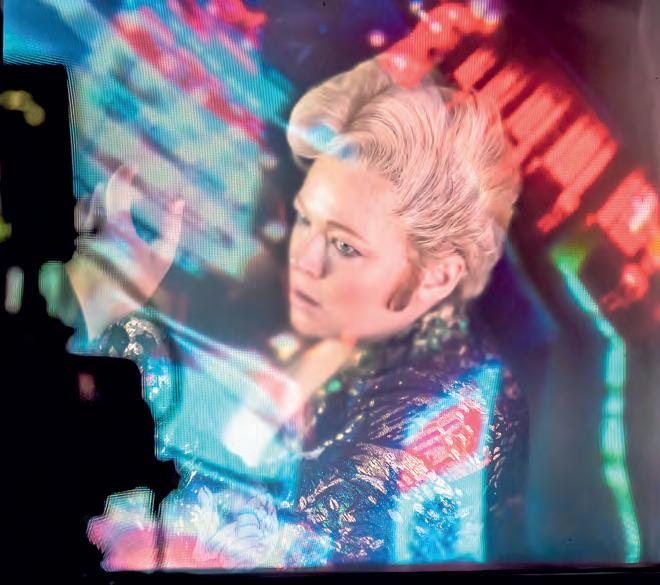
Every one of his witticisms is the equivalent of a tweet. He was born for the social media age. He’d put the Insta into Instagram, the Tok into TikTok
says she is hesitant to agree. In her production, Dorian rejects social media based on its hypocrisy, and she thinks Wilde would have rejected it on these grounds, too.
But surely such hypocrisy would have been its greatest appeal. Wilde, after all, loved to criticise the falsity and posturings of Victorian society, but only from within its warm embrace as he wafted contentedly between dinner parties. Vanessa Theron, editor of Oscar Wilde journal Intentions, tells me it’s this love for society that would’ve made social media so irresistible for Wilde: “Interior design, foreign travel, art galleries, theatres, fashionable clothing, celebrities, social climbing and parties… these preoccupations are all mainstays of social media content”. Wilde’s plays may have mocked high society, but never in a way so daring that they wouldn’t come to see it. Wilde’s wit was stinging, but it was also designed to be protective: who could object to a joke? Especially one delivered so eloquently. It is this tension that makes Wilde so relevant to the new age of social media users. While platforms like Instagram were once about curating a flawless snapshot of one’s life (posed images, picturesque backdrops, colour-coded ‘aesthetics’), to be seen to be carefully curating one’s own self-image is now firmly out of fashion. Behavioural analyst Gabriela Serpa Royo tells me that “anti-aesthetics” are now in vogue,
a look that says “I don’t care”. From casual posting (think photo dumps and BeReal) to ‘ugly beauty’ (Olivia Rodrigo’s ‘starry vomit’ Guts Tour marketing imagery), Instagram and Tiktok are now all about being ‘real’ – but still pretty, of course. One should reject the ideals of social media, but preferably in a pithy tweet or #nomakeup selfie.
It’s not hard to detect the irony, but Serpa Royo emphasises that Gen Z’s interaction with self-image is decidedly less superficial than their predecessors, with ‘aesthetics’ representing a meaningful form of self-expression and ideology. One such ideology is a reaction against hyper-productivity: hustle culture has given way to ‘soft living’; girl bosses to quiet quitting; self-help to self-care. The self remains at the heart of it, of course, but there is a rejection of utilising every part of one’s life for labour. It’s a similar impulse from which lateVictorian aestheticism was born, a reaction against industrialisation and mass commodification that instead championed art for art’s sake – beauty without use.
So, could the selfie actually be the ultimate Wildean aesthetic ideal? Certainly, the veneration of one’s own image is in line with any good dandy’s self-care programme. Love yourself first, foremost, and always. So said @girl.boss.bible, but it could as well have been Oscar Wilde.
89
Left: Oscar Wilde during his Victorian heyday – his greatest work of art was his own self, which is why he has been so fondly remembered when other authors are overshadowed by their work; Above: Sarah Snook playing Dorian Gray in the recent West End smash hit, which will soon transfer to Broadway

THE LAST WORD
ADAM BLOODWORTH
NIGHTLIFE DIDN’T DIE, IT JUST CHANGED
Soho might be little more than a collection of historic old pubs but the death of Britain’s nightlife has been greatly exaggerated.
It was once where they brewed Tetley’s bitter, but now the ordinary-looking office windows of a former factory look as if they might explode. It’s 2am and the panes are changing colour from midnight blue to rainforest green, each ‘boommf, boommf’ of bass shaking the curled floor tiles of this dreary old building. DJs were scheduled until 6am. On a vast balcony overlooking an old lobby, people were lined up in rows, trying to get a better view down onto the dancefloor. Hundreds had gathered to watch DJ Haai, who didn’t come on until 3am.
This is The Cause, a recently opened club and arts space in London’s Canning Town. There are spaces like this popping up across the country. Hundreds of besquinned folk have been gathering at Tottenham Hale at unusual times, piling onto trains out of London that would otherwise be quiet. They’re on their way to Drumsheds, a new superclub near Meridian Water on the capital’s outskirts. It occupies the former Ikea building; the inaugural show featured Hot Chip frontman Alexis Taylor. There’s space for 15,000 to shake off the work week on the air conditioned dancefloor.
Back in Canning Town, turn left out of the train station’s main entrance and, despite it being early in the afternoon on a Sunday, you’ll notice a queue spiralling into the hundreds. It snakes past a load of units in an ordinary-looking industrial estate. This is the line for Fold, a 24-hour club with lockers to store a change of clothes and shutters that open in the morning to let the light flood onto the
still-heaving dancefloor. If you turn up much past 3pm you’ll wait over three hours to get in. The lineup is never revealed: that’s the fun. Some of the world’s most respected DJs turn up to play this covert, Berlin-style party.
If you read the papers, you could be forgiven for thinking British nightlife was dead and buried – and it’s true that cities including Manchester, Bristol and Glasgow have, like London, lost centrally-located and legendary clubs to gentrification and the cost of living. But let’s not conflate nightlife dying in city centres with nightlife dying in general.
It’s true you would be hard pressed to find a proper nightclub in Soho these days. Madame Jojo’s shut in 2014 and G-A-Y Late stopped operating last year, leaving Freedom and… that’s about it. The council is more interested in placating a handful of fussy residents than they are encouraging one of the most vibrant and vital industries in the country.
But it’s time to move on and simply accept that Soho is now a collection of historic pubs and some decent restaurants – certainly not somewhere you want to find yourself after 11pm.

I’m 35 and I can’t remember a time when London had more going on. Clubs like Fold, The Cause, and Drumsheds are creating ways for people to dance into a new era.
You have to travel a little further to reach the pulsating windows, and fabulous, sequinned hordes, but if you crave a sweaty room full of interesting people in which to shake a leg, now is a great time to be alive.
COLUMN
90

THERE’S YOU YOU , THEN THERE’S THE
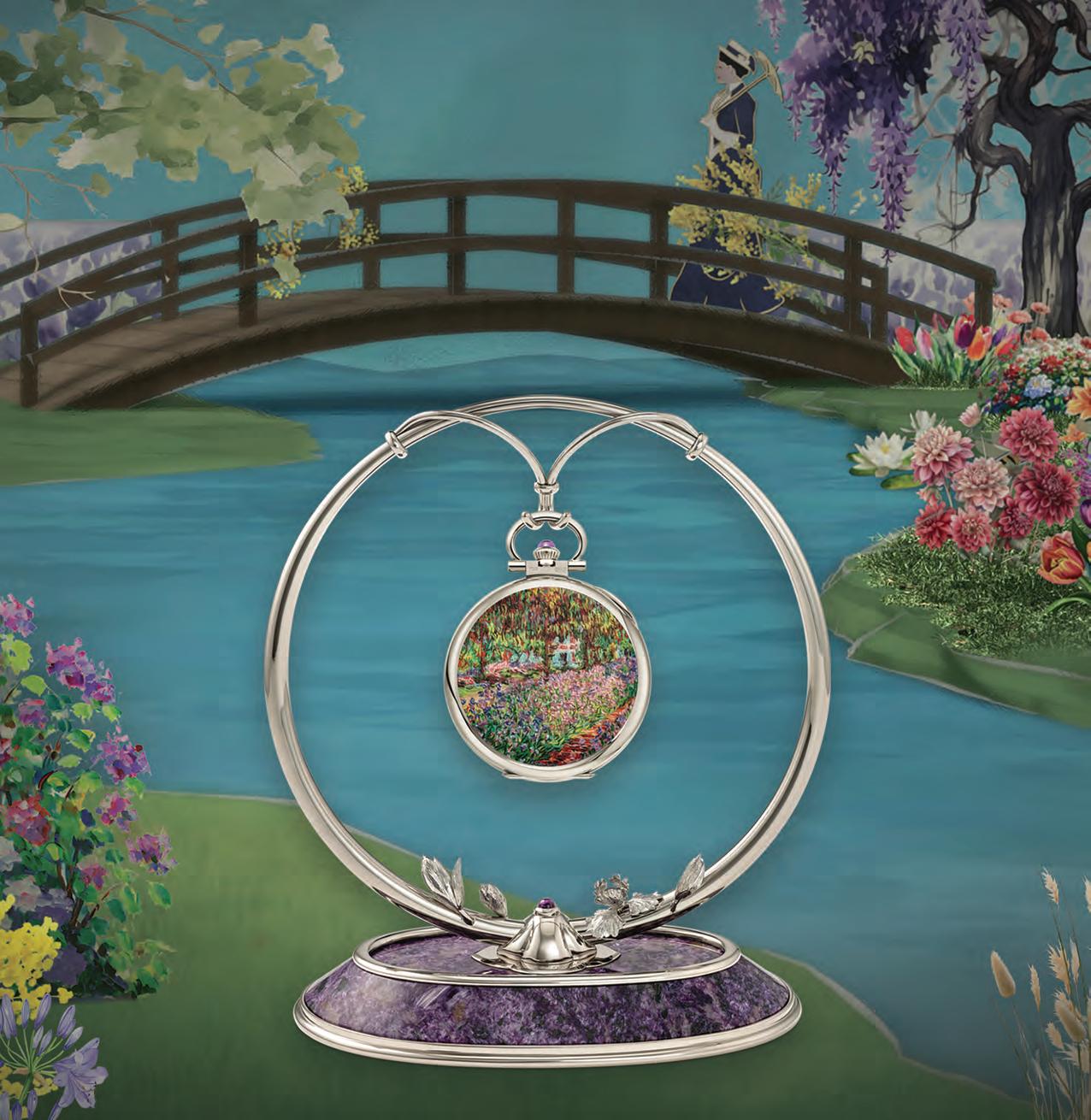
92


































































































































































































































































